



Featured image: Image from When Drones Fall From the Sky, by Craig Whitlock, Washington Post. [link]
At 0213 ZULU on the 2 March 2013, a Predator drone, tail number 04-3133, impacted the ground 7 nautical miles southwest of Kandahar Air Base, Afghanistan, and was destroyed with a loss valued at $4,688,557.[1]
On the 27th March 2007, a crashed spy plane was discovered by Yemeni military officials in the southern province of Hadramaut, along the country’s Arabian Sea coastline. The following day, Yemen’s state media identified the plane as being of Iranian origin, and that it was yet another example of an Iranian provocation at a time of high diplomatic tensions between the two countries. It was three years later, upon Wikileaks’ release of the so-called Cablegate archive, that a US Embassy cable revealed the “Iranian spy plane” was in fact a “Scan Eagle” drone. The drone was remotely piloted from the US Navy’s USS Ashland which was patrolling the Arabian Sea as part of an international counterterror task force. The United States Military was not “officially” conducting military operations in Yemeni territory at the time, and had not sought permission to conduct operations in the country’s airspace.
The discovery of the crashed drone could have posed a difficult political problem for the US to solve. However, in the cable, the official makes it clear that Yemen’s President Saleh had been keen to reach an agreeable deal with the Americans and apportion blame on a convenient third party — Iran. The cable states:
“He could have taken the opportunity to score political points by appearing tough in public against the United States, but chose instead to blame Iran. No doubt focused on the unrest in Saada and our support for the transfer of excess armored personnel carriers from neighboring countries (reftel), Saleh decided he would benefit more from painting Iran as the bad guy in this case.” [2]
By 2007, aside from occasional reporting in the media and among some activist circles, there was little public awareness of the US drone program. In fact, the program was not officially acknowledged on-the-record by a US government official until 2012. This official was John O. Brennan, then Counterterror Advisor to Barack Obama, and the momentous occasion was a speech at Washington DC’s Wilson Centre—a “key non-partisan policy forum for tackling global issues through independent research and open dialogue”.[3] Brennan states:
“So let me say it as simply as I can. Yes, in full accordance with the law—and in order to prevent terrorist attacks on the United States and to save American lives—the United States Government conducts targeted strikes against specific al-Qa’ida terrorists, sometimes using remotely piloted aircraft, often referred to publicly as drones.”[4]
While the use of unmanned aircraft in warfare goes back to the early 20th Century[5], the distinctive image of the drone has come to characterise the ambiguous geopolitics of The Global War on Terror. Their hubristic names—Reapers, Predators — evoke visions of carnivorous animals carefully and selectively stalking their prey. With their stealth and capacity to observe targets for hours on end before striking, the drone selectively adopts the tactics of the insurgency: it is an emergent weapon directed onto an emergent threat. Drones, like their intended targets, are not necessarily contained by borderlines, or to territories on which the US has declared war. They are in a suspended state of exception, and are decried both as being outright illegal by experts in international law, and simultaneously, as Brennan contests, strictly adherent to the doctrine of Just War.

In Brennan’s Wilson Centre speech, he draws on medical analogies to justify the “wisdom” of drone warfare, emphasising its “surgical precision—the ability, with laser-like focus, to eliminate the cancerous tumor called an al-Qa’ida terrorist while limiting damage to the tissue around it—that makes this counterterrorism tool so essential.”[6] But are drones as precise as Brennan’s rhetoric implies? Drones are often said to be heard, and not seen—their whirring noise inspiring local derisive colloquialisms[7]. But it is especially in the drone crash that the drone can be seen, and what’s more, subjected to inspection. It alerts us to a vital consideration: the failure of so-called precision military technology.

In IOCOSE‘s Drone Memorial, our attention is drawn to the fact that these complex systems are precarious, that the drone is indeed a fallible technology. The memorial, a sculpture of a fallen Predator drone driven into a copper plinth like a blade, subverts the surgical metaphor proposed by John O. Brennan. The drone’s mirrored surfaces create a fractured, tesselated reflection of its surroundings, its form almost vanishing in a specular camouflage. Inscribed on its wings are the memorial’s “fallen comrades”, the hundreds of other drones that have crashed, listed by location and date. This list can only be considered a selection, however, such is the secrecy around the use of drones in the War on Terror. As such, it should also be considered a monument to the journalists who manage to report on the discrete events of drone warfare in incredibly challenging circumstances.
A GPS beacon embedded in Drone Memorial broadcasts the location of the sculpture on the project website, hinting to us that this seemingly trivial technology in our smartphones has more nefarious uses. Global Positioning Systems have their roots in Cold War ballistics research, specifically in a program by DARPA codenamed TRANSIT, developed to direct the US Navy submarine missiles to “within tens of meters of a target”[8]. Today, GPS is one of many components in the assemblage of technologies used in the drone, and a key enabler of its apparent “precision”. Nevertheless, GPS can of course fail—it can be “jammed” inadvertently, or indeed tactically manipulated by malicious third parties. When the satellite link is lost with a drone, the aircraft goes into a holding pattern, flying autonomously until control is regained. In the Washington Post‘s story “When Drones Fall From the Sky”, they note that in order to keep its weight at a minimum there is little redundancy built into the drone’s on-board systems. Without backup power supplies, transponders and GPS links fail, and in several cases “drones simply disappeared and were never found.”[9]

IOCOSE’s positioning of the memorial as existing in a hypothetical, post-war scenario poses some interesting questions, but this temporal dissociation is perhaps unnecessary, for this is an issue very much of the present. It is certainly a topic more than worthy of critical investigation—the spectacle and the political consequences of failure have largely been left out of typical artistic engagement with drone warfare. In their press release accompanying the work[10], the artists suggest that the sculpture has an absurd quality. To me, it is not absurd as much as it works as an apt memorial to the violence of failure. In reading the long list of drone crash locations, the viewer might begin to probe the question of what information should be open to public scrutiny. IOCOSE pose the following question to us: “Does a drone crash count as a technological failure, or as a casualty?” This question would appear to have a clear answer: we must see the drone crash as a technological failure, so as not to make a false equivalence with the real casualties of drone warfare—the civilians who are subjected to it, the very same people who might also counter Brennan’s claims that the drone is a surgical, precise weapon of war.
Drone Memorial is the third work in a series titled In Times of Peace. This most recent work is the most astute in challenging the legally and ethically disruptive paradigm of drone warfare: it pierces the reflective rhetoric of US defense officials, and directs our attention to the high-stakes violence of its technological failure. The memorial, of course, ordinarily comes after the historical moment. This ‘moment’ is very much still unfolding 15 years later, and as the Trump administration takes form, it seems that the way in which drones will be deployed in the future is an ‘unknown unknown’. Thus, Drone Memorial is a temporal snapshot, an aesthetic pause on an ongoing, mutable war that seems to operate on a parallel continuum, only occasionally visible. More drones will continue to fail, as the drone war inevitably continues. These failures present a moment for critical analysis, a flash of visibility that should be seized upon.
Featured image: Pandora’s Dropbox by Matt Bower
The Disruption Network Lab (DNL) has been presenting in Berlin some of the finest platforms for the discussion of art, hacktivism and disruption, presenting academic debates on not-so-conventional forms of thought. In their event IGNORANCE: The Power of Non-Knowledge, the second in the series Art and Evidence, various scientists and researchers discussed ignorance, not merely as a subaltern issue but as a central tool in knowledge production.
In previous events, DNL debated how ignorance is deployed as a mechanism of truth and power negotiation, mainly through the omission of the known by the means of secrecy, obfuscation and military classification. There are many forms of understanding ignorance, and this program intended to elucidate the potentialities and pitfalls within the concept. According to DNL, the first step towards approaching ignorance is to recognise it and become aware of it. As co-curator of DNL Daniela Silvestrin said (despite the paradox) that it is necessary to render the “unknown unknown into a known unknown.” The field of ignorance studies investigates the spread of ignorance, what kind of forms it takes depending on the context, how science “converts” it into probabilistic calculations of risk, and even how it can be used to push certain political, economical or religious agendas.

In the opening keynote, Matthias Gross, a sociologist and science studies scholar who has written extensively on ignorance studies, co-editing with Linsey McGoey the “Handbook of Ignorance Studies,” starts by stating that “new knowledge always creates new ignorance” and that throughout history humans have been in constant relation – acceptance, denial, resignation – with the unknown. Gross has covered how ignorance operates in different scientific milieus, namely, how risk is widely used in natural sciences as an attempt to project an idea of the future, as demonstrated in weather forecasting, but also how not knowing operates in everyday life; through secrets, the spread of false knowledge, feigning ignorance, or even through actively not wanting to know.
Gross presented a compelling body of research, exposing numerous examples in which ignorance serves the purpose as a tool to acknowledge what we don’t know in science (important in fields such as Epidemiology) or how positions of power use ignorance to manipulate public opinion within our social structures. However, the debate felt somehow stranded in an optimistic loop, where ignorance was seen mostly as a catalyst to search for further knowledge. Yet, I believe, while duelling with the binary knowledge vs ignorance, one should never forget to tackle the universalistic shape that ‘knowledge’ tends to adopt. In the end, the discussion felt insufficient, failing to examine knowledge/ ignorance from a non-hegemonic perspective when it would have been interesting to borrow criticism from postcolonial or feminist thought.
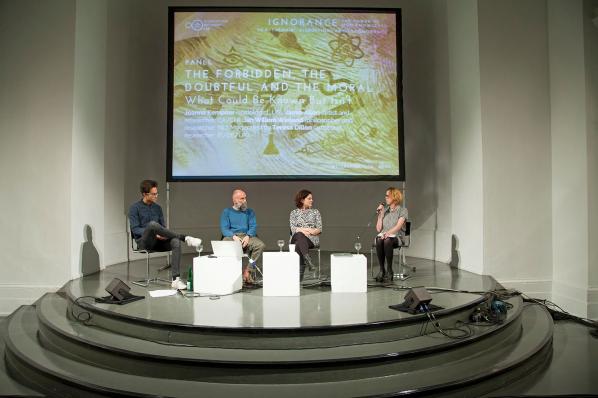
The first panel, moderated by Teresa Dillon, was deemed to shake the consensus in the room by joining the moralistic perspectives in science, the forbidden and undesired, the paranormal and the apocryphal together. Sociologist Joanna Kempner presented astonishing research focused on ‘negative knowledge,’ described as taboo, dangerous or threatening to the status quo. In an attempt to demystify the neutrality of knowledge production in sciences, Kempner interviewed various scientists to discover forbidden areas in their fields. The outcome of this research revealed that due to a fear of loss of funding and/ or sullying their reputation, scientists restrain themselves from researching illegitimate topics. For example, in Psychology one is expected not to study extra-sensory/ paranormal senses as these studies are usually associated to parasciences, a term that is in itself revealing of the hierarchies of knowledge. Kempner also exemplified how knowledge production is pressured by political interests and recalled the research-bans during the G.W.Bush government that cut funds to research related to sex and drugs under the assumption that remaining ignorant about any possible positive aspects (of recreational drug consumption) guarantees the maintenance of conservative moral values.
On the maintenance of moral values, the philosopher Jan Wieland presented an interesting experiment: “What would you do if you wouldn’t know? And what would you do if you’d know?” Giving the example of a social experiment by Fashion Revolution, a movement that calls for “greater transparency in the fashion industry”, Wieland examined consumers’ choices as they acknowledged the conditions in which clothing is actually produced. The project invokes a sentimental story with an excerpt from the daily life of a young girl living in Dhaka, Bangladesh, who works in a garment factory. Coming to terms with the girl’s story, the reactions differed — from not buying and empathically connecting with her situation to total indifference and still buying. Wieland attempts to analytically evaluate their intentions, good or bad, and how ignorance affects choices, stating that some of us might willfully remain ignorant (willful ignorance) as a way to better cope with our habits of consumption. However, I find it difficult to extrapolate these findings to a moralistic and individualistic criticism of people’s consumerist choices, since we know there is a structure that keeps consumers far from well-informed. A good example of how economy capitalises on ignorance, we know that the international division of labour is intentionally built to alienate the consumers from the “dirty” phases of production.

Jamie Allen, artist and researcher, also analyses at the economy of non-knowledge that is in the genesis of apocryphal technologies. “Do pedestrian’s crossroads’ buttons actually work?” We have all thought about this, yet has it stopped us from pressing the buttons? As long as we do not know whether a certain technology actually works, it “works”. Such an economy is boosted by acknowledging that some things remain as common ignorance. If we are not sure whether a lie detector works or not, then it can be used to incriminate — amidst ignorance, it shall produce the truth.

Informative and somewhat frightening, “Merchants of Doubt”, directed by Robert Kenner (2014), reveals how bendable ‘truth’ is in the interests of big corporations. The documentary investigates how the tobacco industry spread false information among firefighters, leading the world to believe that the domestic fires caused by cigarettes were the fault of the furniture rather than the cigarettes. This is where it goes from uncannily funny to scary. While interviewing scientists, whistleblowers and activists, the film unveils the dreadful story of corporate campaigns designed to unleash confusion and scientific scepticism among the masses, putting the life and security of millions at stake. This scepticism is not passive, thus it turns into a cynical endeavour. As corporations claim that there is no consensus surrounding issues such as global warming, conferences and books are forged to sustain their statement, while scientists who defend the existence of greenhouse gases are accused of ceding to their political biases in order to get funding for their research. What about facts? They seem to become irrelevant in the face of expensive lies.
Watch Merchants of Doubt’s trailer here.

Karen Douglas, a social psychologist, presented an empirical study of conspiracy theories whilst trying to trace a particular psychological profile of those more prone to elaborate and believe in them. Douglas used widely known conspiracy theories as examples, such as the infamous car crash that killed Princess Diana (which became a true “Schrödinger’s cat” case, instigated by the media-produced hyperreality in which Diana was both alive and dead — along with Elvis Presley) and the theory that 9/11 was orchestrated by the United States government to instigate and justify the “war on terror”. Douglas believes we are naturally hardwired to believe in conspiracy theories and sees them as a way to cope with things we are unable to answer. A socio-analytical view on conspiracy theories also seems to fail the complexity of forces that make us consider why certain theories are conspiracies and other perspectives are just theories. The issue with Douglas’ approach lies within its socio-psychological analysis, which tries to find a pathological pattern in people who believe in conspiracy theories, such as describing these people as being intentionally biased, or stating that those who tend to perceive patterns in things or believe in more than one conspiracy theory all show the “symptoms” of a conspiracy theorist. Yet, as pointed out by a member of the audience, this approach seems to lack a sensibility to the entire concept of “conspiracy theory” as a political tool to dismiss and undermine other narratives, such as narratives from an undesired other (e.g. how Russia’s government agenda is seen by the USA). Nevertheless, it is interesting to understand how these bodies of “disbelief”, should you wish to call them conspiracy theories or not, have a huge impact on our lives and inevitably our deaths (e.g. global warming, vaccination). As with apocryphal technologies, certain forms of unknown seem to crystallise as forms of knowledge – we know that we do not know and that is the way it is.
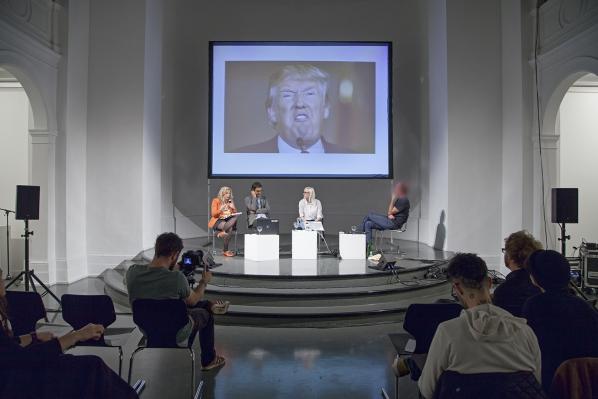
The closing panel, moderated by Tatiana Bazzichelli, has overseen our entanglement on social media and its algorithms, promising to be oracles of truth while their complex structures grow beyond our understanding. Ippolita, a group of activists and writers, warned how social media promotes emotional pornography, where our feelings are exploited by click baits in exchange for our personal data. By establishing clear metrics of interaction, like the number of likes and comments, social media creates an addictive game of forged interactivity, while we are scrutinised by biometric evaluation resultant from the same data we produce. Also analysing the manipulation of data and its weight in political agendas, Hannah Parkison, a journalist focused on digital culture, analysed Trump’s run for presidency propaganda in digital media. By using mostly social networks, such as Facebook and Twitter, Trump has kept control of his narrative without entering into risky interviews broadcast on TV. This is an effective way to get away with lies, regardless of the constant warnings from fact checkers – according to Politict 78% of what Trump said on the run for the election is not factually true. These lies spread across the internet, rendering their own truth.
Vladan Joler, chair of New Media Department at the University of Novi Sad, presented his project in which he tries to map the tentacular structure of the Facebook algorithm, an expansive database incorporating individuals’ personal information that implies the fabrication of assumptions about potential consumers’ habits, wants and needs. Facebook was thus framed as an immaterial factory of information, the functioning of its assembly line still unknown, constantly mutating and growing. A speculative visual image of Facebook’s processes was rendered as Vladan tried to map something unknown; this mapping has similarities to the work of early cartographers. And much like early anthropological stances, the nodes of information produced have the potential to define thoughts and discussions about what we are and how we are supposed to behave. As Vladan ironically concluded, these are the tools used by the cybernet dominators – the digital monarchies that will accentuate asymmetries.
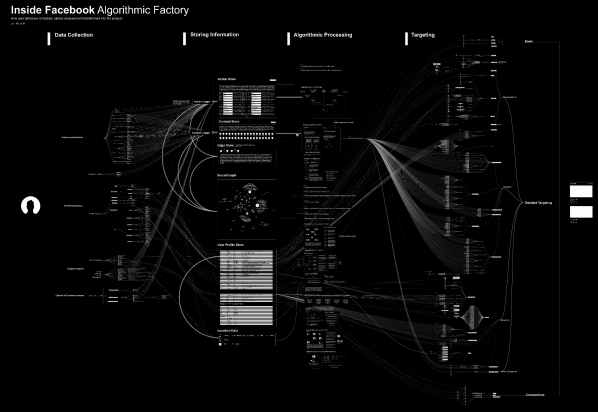
Ideas such as ‘knowledge’ find resistance and defiance from other epistemes that fall out from the western-centric productions of knowledge, such as the Amerindian ‘perspectivism’ defended by Viveiros de Castro or even the Alien phenomenologies (see Ian Bogost) that instigate the thought of non-anthropocentric ontologies. Bearing those in mind, I found that talking about the ‘dark’ side of knowledge is an invitation to dismantle and boycott its mechanisms of production, sustained in frail ideas of “truth”, “reality”, or “science”. In addition to the initial concept of ignorance, the conference provided a fertile ground for questioning the multiple ways in which humans deal with intangible phenomena, try to bypass obscurity and profit from that same obscurity. It provided insight on the relevance of knowledge to map and create reality, while bodies of power render webs of mystification of the tangible – corporations forging lies, politics of manipulation, cultural colonisation – reproducing ad nauseam epistemic violence.
The third edition of the Art and Evidence series from Disruption Network Lab, which took place on the 25th and 26th of November, wrapped up with the event TRUTH-TELLERS: The Impact of Speaking Out. TRUTH-TELLERS asks a question that could not be more crucial at the moment: “Can we trust the sources and can the sources trust us?” We have recently experienced a presidential battle between Clinton and Trump in which one of the most divisive topics were the thousands of emails sent to and from Hillary Clinton’s private email server while she was Secretary of State. A battle from which Trump left victorious despite having failed almost every fact-checking test. While Assange is forbidden to use the Internet for fear of him interfering with the presidential run in the USA, Chelsea Manning remains convicted, sentenced to 35 years of imprisonment due to her 2013 accusations of violating the Espionage Act. DNL gathered hacktivists, privacy advocates, investigative journalists, artists and researchers to “reflect on the consequences of leaking and whistleblowing from a political, cultural and technological perspective”. Unfortunately, due to a lack of funding, this could have been the very last DNL event. Let’s hope not, as these are vital, particularly in times of political despair.
Feature image: Still from Dreams Rewired: original source Das Auge der Welt (Germany 1935); dir: C. Hartmann
Dreams Rewired / Mobilisierung der Träume – Trailer from Amour Fou on Vimeo.
The 2015 film Dreams Rewired, recently shown at the Watermans Digital Weekender in London on 12-13 November, will be screened again at Watermans on 3 December. Directed by Manu Luksch, Martin Reinhardt and Thomas Tode, the film has the tagline ‘Every age thinks it’s the modern age’. It looks back to the early 20th Century, to the development and implementation (first locally, then globally) of the telephone, the radio and television.
The makers of Dreams Rewired unearthed and arranged early film recordings and brought them into the 21st century context. This was done via a playful narrative written by Manu Luksch and Mukul Patel and read by Tilda Swinton. The tagline was well chosen; almost everything Swinton says would have been relevant at almost any point within the last century. Time periods, machineries and political movements are connected in clever and unexpected ways, meaning that Dreams Rewired, a durational video whose narrative follows a recognisable storytelling structure, makes numerous links between times, places and people, which branch off from the safety of its linear structure.
Dreams Rewired is something of a treasure trove, not only for the glimpses its found-footage building-blocks gives into a past era but also because of the inter-generational, inter-national, inter-thematic connections it makes. Frequently while watching the film I felt the urge to burrow into an investigation of one of the clips, stories or introduced contexts. To emulate this ‘tip of the iceberg’ effect, this review will pull words directly from the film, linking quotations to some of the themes which appear and reappear throughout.
“A new electric intimacy”
With new media come new practices of communication. One of the recurring themes described in Dreams Rewired is the coupling of intimacy and invasion of privacy introduced to society along with a new communication method. Just as a new invention is prototyped, its social implementation causes new prototypical behaviours – new ways of caring, new ways of injuring, new comings-together, new separations. Uncertainty is inherent to experimentation.
“The waves travel at the speed of light, defining what simultaneous means. Information can travel no faster.”
When something is newly possible it also newly achievable – new precedents are set and new avenues opened for exploration. There is a flurry of activity, a rapid diversification. For those looking to gain or retain power over others, this is a problem; diversity requires more effort to manage. Initial flurries of activity are curtailed by the introduction of rules, the setting of precedents.
This limitation sets new targets to meet, new challenges to overcome. The cycle starts again as those in power look for ways to consolidate it while those without look to gain what they can. This is a simplistic, but not inaccurate, description of the machinery of the capitalist world.
This cycle of diversification and restriction is always coupled with the establishment and transcendence of thresholds. Experimentation with a new technology reveals some of its limits. (Side note – of course, what is understood as a limit is defined by wider cultural contexts.) “Information can travel no faster” is a provocation to speed up.
“Geography is history”
New advances cause conceptual shifts. Early telephony and television shrunk the gap in time between a thought or plan and its activation. Understandings of time and geography changed, and it became possible to move into new spaces and in new ways at socially impressive speeds. New powers, in short, were available to those who knew how to access them, to those who understood the preceding context well.
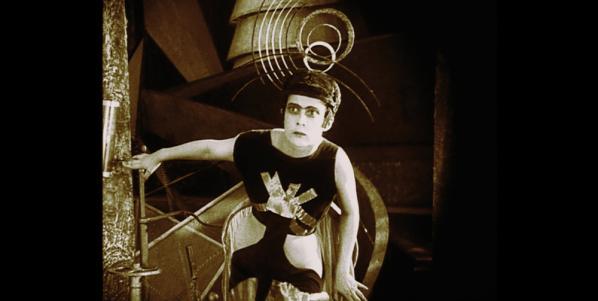
“A model of the new human is put into circulation”
A network grows, its complexity and partner processes intensifying. The machinery of daily life is altered, and daily life is a testing ground. Social interactions change as the new set of behaviours required to work the new machinery collide with existing social norms and rituals. New jobs and new workplace structures appear and people previously without responsibility or power find themselves in contact with it (though they may not understand the possibilities at first). People are no longer the same beings as before. Cycles of experimentation and consolidation reach into the body.
“Someone will have to lift us up. But who will lift them up?”
The flurry of excitement surrounding a new invention is based on the idea that ‘our’ lives will be improved, that ‘we’ will be able to do, see, have more. There is a problem here. The words ‘we’ and ‘us’ are too abstract – they bracket whoever the speaker wants them to bracket and recapitulate the prejudices they have. Anyone who is not included as part of the ‘we’ simply does not exist. This is convenient for the ‘us’ – while ‘we’ rush excitedly towards a future in which we have more and better, what ‘they’ do is of little concern. The ‘us’ does not care – or even think much – about the ‘them’. The ‘us’ cannot understand why the ‘them’ has not joined the ‘us’. After all, the ‘us’ is at a new threshold – who would not want to reach the other side?
“Personal profiles, passwords, biometrics..fully documented. Every trace filed. Bigger data, better analytics. Opt out, and we lose our place in the world. So…we share the keys to our desire, our habits, to ourselves.”
To be part of the ‘us’ and the ‘we’ requires effort. To ‘opt in’ requires sacrifice. At the same time, ‘opting in’ is the easiest thing in the world when ‘opting out’ means facing a void. Advice on how to do well, how to achieve, how to be healthy is easy to come by, but there is little guidance for those who find themselves, or wish themselves, outside the mainframe. Losing one’s place in the world means losing access to that mainframe and the stability that comes with a highly legible structure. Today the legible structure is far-reaching and well established, to the extent that opting out is dealt with violently. The new models of human coming into circulation have trouble recognising the old. There is a mutual rejection.

“Government regulation stifles amateur culture – military and commercial interests occupy most of the spectrum … transmission becomes a privilege, not a right”
As I wrote earlier, the ‘us’ and ‘them’ structure is too simple. It would be more accurate to think of people as communicating on multiple frequencies. The machinery of society is complicated to say the least, and made more so by the mainframe, which amplifies transmissions at some frequencies while restricting others. In the early 20th Century, multiple obscure radio channels were repressed, responsibility placed with public backlash following rumours that amateur radio was responsible for the sinking of the Titanic. Side questions: where did the rumours come from? What were they based on? How was the public response measured?
“For the first time he hears himself as others do. A voice absolutely familiar but estranged…But her power also grows: by controlling his voice she controls her time”
There is a strange relationship between the controller and the controlled. For every CEO there is a team whose own agenda seeps into the workings of the company. Dislocated power and fragmented or unplaceable identity are some of the symptoms of a complex system undergoing change. When a system is so complex as to involve multiple timescales, spaces, materials and structures, it is impossible to predict the future.
—
Dreams Rewired is part of the Technology is Not Neutral Symposium
3 December 2016
Watermans, London
https://www.watermans.org.uk/events/technology-is-not-neutral-symposium/
Two years after his death, Harun Farocki continues to maintain an archetypal role in the world of the visual arts. Many mourned for the loss of a gifted artist who was as not just a filmmaker but a critic, activist and philosopher en masse. Farocki succeeded his German New Wave filmic predecessors as his work would seamlessly and at once command hilarity, disparagement and intellect. A project-retrospective collaboration of his work was undertaken, just two years after his death, with its first part at The Institut Valencià d’Art Modern (IVAM) named ‘What is at Stake’, and more recently the second-part titled ‘Empathy’at the Fundació Antoni Tàpies compiled of at least 8 works focusing on an analysis of labour within the framework of capitalist demands.
The title of the exhibition, ‘Empathy’ originates from Ancient Greek; ‘εμπάθεια’ is a compound of ‘έν’ and ‘πάθος’ meaning ‘moved by passion’. In German, empathy translates to ‘Einfühlung’ and was ironically exploited by Farocki in 2008 as the title for his text and reads:
‘A compound of Eindringen (to penetrate) and Mitfühlen (to sympathize). Somewhat forceful sympathy. It should be possible to empathize in such a way that is produces the effect of alienation.’
Taking into account Farocki’s liking of Brechtian ‘distanciation’, he formulated rather quickly that to ‘empathise’ means to project one’s own feelings, therefore infiltrating objective opinion. The notion of ‘empathy’ for Farocki was carefully tailored to a synthesis that gave him the patience to be simultaneaously attentive and austere towards his subjects’ predicaments. As paradoxical as it may seem, empathy and distance are nurtured companions. With Farocki’s interpretation of empathy in mind, I entered the dark bunker where the retrospective took place. A space usually leaking brightness from the glass roof was now transformed into an industrious zone of projections, obsolete TV sets and the mellifluous humming of those operative machines. Farocki’s filmic oeuvre overflowed from devices onto white surfaces, accentuating the techno-capitalistic condition of labour operating eradically for our Western communities.
As you enter, the video-installation of Workers Leaving the Factory in Eleven Decades (2006) dominates the center. Twelve TV monitors are laid out in a horizontal line, juxtaposing chronologically the moment where the worker leaves the factory in Farocki’s twelve chosen films – among them, Workers Leaving the Lumiére Factory in Lyon (1895), Deserto Rosso (1964) and Dancer in the Dark (2000). Here, the excerpts are used as a mnemonic tool as Farocki’s montage gravitates around the entrance of each factory. Each scene extrapolates the repetition of entering as a rhetorical techne, an emphatic mimesis of organising and preserving power through the image of the factory and its systems of subjugation. Yet, distance and empathy are circular and procedural.
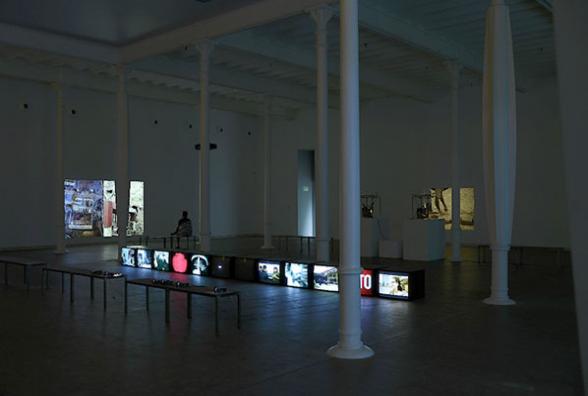
Curated to encourage a clockwise movement following the introductory piece, A New Product (2012) is being televised to the left. It commences during a mundane corporate board meeting for a consulting company violently regurgitating neoliberal logic. The goal of the meeting is to amplify competition and ascertain efficiency of their employees in the workplace by creation of a new product. Through the repetitive flipping of charts and reports, Farocki succeeds in capturing the vocabulary of rationalisation regarding their employees’ assets while unfolding the dynamics of the team and its public presentation. The narrative’s structure being static and unobtrusive, in conjunction with the ascetic use of the camera implies a degree of distancing from the subject. Still, the absence of Farocki’s own evaluation additionally contains the capability to bolster the viewer’s assessment of the situation thus achieving the artist’s desired equilibrium between empathy and distancing.
There existed a sense of rituality by which the projections were transmuted from a seemingly simple and observational nature, to one which was filled with the allegory of transparency and distance. Re-pouring (2010) was an ode to Tomas Scmidt’s Cycle for Water Buckets (or Bottles) from 1959. The original piece was a carefully choreographed mise-en-scene by which Scmidt poured one glass, a bottle of bucket of water into another. The act of pouring for Schmidt was one which indicated a simple and natural process of vaporisation with each pouring. Farocki had programmed machines to perform the artistic gesture for him, a re-pouring of the performative fluxus notion. A paradoxical act, since as human beings our navigational processes depend heavily on our cognitive ability, the mechanical hands were able to seamlessly perform the act of re-pouring. Farocki’s hyperrealism allows him to jump to a certain scale of futurity whilst also being rigorous of scrutinizing reality. The act of programming robots to perform a ritualistic and performative task goes undoubtebly implies distancing from the artistic practice of Fluxus. The Fluxus movement was predominantly a practice governed by experimental notions of performativity which were heavily conceptual. It therefore comes into stark contrast to the idea that such act could be thought by algorithm machines as notions of ‘thinking/feeling machines’ in contemporary society are rudimental and dreams of a future imagination. Farocki, able to perform the task himself such as with Indistinguishable Fire, does not. He steps out, physically distances himself from undertaking the task himself but maintains his empathy to former Fluxus activities but also expressing a empathy towards machines who today perform most human labour.
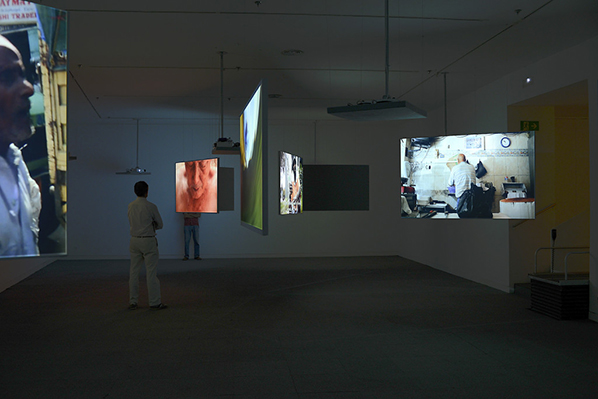
Amidst one of the spectacular accummulations of Farocki’s body of work, the apogee of the retrospective would be Labour in a Single Shot, shown for the first time in Spain. The project was initiated in 2011 by Harun Farocki and Antje Ehmann, co-curator of the retrospective. Located in an entirely different bunker, the work was compiled from a series of workshops whereby a fixed camera filmed paid, unpaid, material and immaterial labour from fifteen workshop locations. Projection screens are hanged in a room, most facing eachother whilst the noise of all labour taking place floods the space. Harmonious parallels are created as sequences from butcher shops and surgeries face eachother. The repetitive looping and sequencing of labour is used as a means of distancing and signifies non-judgmental watching as an active practice of iconic power. Our lasting impression is a call-girl sucking on a lollipop explaining how her artifice encourages clients into believing the gratification she provides is sincere. Here, we understand that just as she, through sex, retains empathy and distance in unison, Farocki’s empathy can thrive.
Featured image: The Refusal of Time, film still, courtesy William Kentridge, Marian Goodman Gallery, Goodman Gallery and Lia Rumma Gallery
There is a show of art by W K now in town. My friend, if you see but one show of art works this year or the next one or yet the next I beg of you see this one. The world of these works is both our world and not our world. The world of these works is thick and dense with rune and script and sign and light. And do you know the show is called THICK TIME and this seems as they say bang on for there is a sense in which the world and all that we are in it is here boiled down is made dense or thick. And it flows in front of us and we can see in what way and where from and where to it flows. Rune and script and sign and glyph and folk and things are drawn with ink or shown with torn or cut up scraps or light yes light much of it. And since light then dark too. Yes dark. This world flows yes and this world jumps and swells and shakes too.
And song and sound. There is song and there is sound of all kinds. There is a drum a big loud drum and a thing which marks time tick tock tick tock. There are sweet sounds and harsh sounds too. There is song. And there is change. Things change this way and that. This world will fill you with joy and at times it might make you sick at heart. It will make your head ache and pulse and spin. You might need to close your eyes. This world will speed your pulse and make you sweat. You start to dance when you see this world. You might smile. You might cry. You might have as they say a lump in your throat. W. K sees the world as we see it and knows our world as we know it and sees a world that we don’t see and we don’t know and shows it to us and now we think why did we not know this world it was there in front of us all that time.
Please note W K makes stuff with his hands. That is what he does and then he makes the stuff move. He makes things come and he makes things go and he makes things flow or stay still, he makes a world but he is not a God. He makes art. This is art. If you say to me what is art I would say art is a thing like this. The best of art is a thing like this. This is rich. This is not poor thin soup but a meal we can feast on for a long time and then come back for more. (And when we come back we will find things we did not see or taste the first time!)
He is like us and in this lies his strength. And I think he likes us and in this too lies his strength. Oh and did I say he does tricks with chairs.
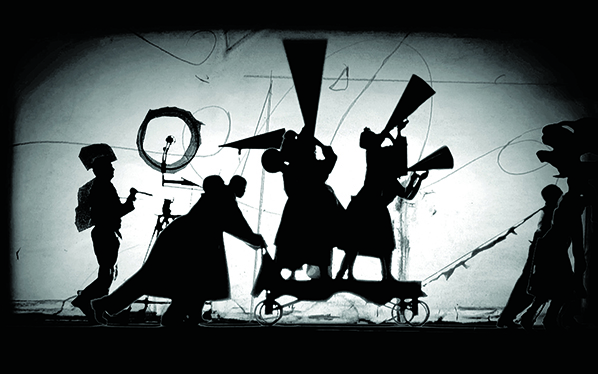
I will tell you more. Let us as they say zoom in. In the first room is a pair of lungs or things that stand for lungs. Things made of wood and nail and screw and cloth which go back and forth as if they pump and move the air. And there are screens and on the screens is light and dark. Folk walk and dance. W K too is on the screens. He does tricks with chairs (and hats too) and he walks. I think I saw once he had a stick but I might be wrong. Once he bore a young girl round his neck and walked with her on the screen. He looks you might say sad but no more as if he is in deep thought. He looks at the world. And there are such sounds now here now there it is like a spell. It is a sweet pain. And there is print and type—there are words and there are sums. Now there now crossed out now smudged now clear to read but hard to grasp what it all means.
What does ‘means’ mean? What does it mean to say art, or a work of art, means? Hmm. Though not hard for sure to feel. Not thoughts but a way to feel. The strange words and the maths make you feel. The words and the dance and what you see on the screens make you sad and glad too (and your heart beats fast). And there are folk who come and go in a long line like in a march they come and go. They come in one end and walk and dance and march and then they go out. And you smile and you think hard and you see them there and then you are there and you are them. Oh a dream of life. Oh a real hard life. Oh a life of hard dream. All pass us by. King and queen and poor and knave and prince and thief and saint and the well and the sick those who live and those who will all too soon die and those who have died they pass by us, and show us the way things are and the way things might be, both the best and the worst of it. There is filth and dirt and there is joy and a bright light and there is dark and there is space. Look! It goes on and on dark and dark. The man ails—the girl does a dance. The man jigs a jig—the girl is sick. The bird flies. The old man lives—the young girl dies. A man is in a fat suit. He looks like a great white pea. She plays a tune on a thing of brass. The clock ticks. And ticks. Oh look now there is a flash. A flash of light. It is so bright. There is death. There is an end. But look now things flow once more. There is life. Here is a new start.
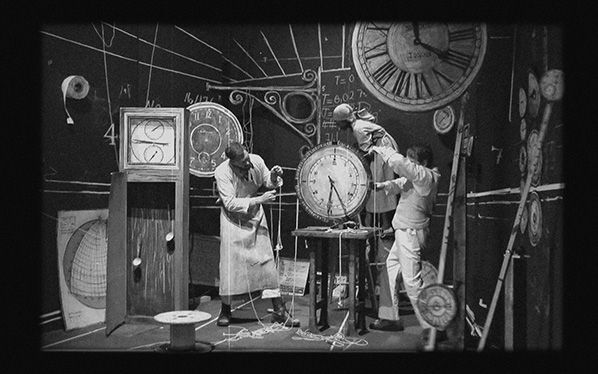
Things in a row. Things put in a row in a space, the right space. A space on a wall a space in a screen a screen in a space a space in a space. A gap. A pause. To look at— to put in the right space since this will help to make us feel and see what it might be like to be one who is not us.
I want to say W K is not cool. He dares much and this can make him trip and fall. (One piece I will not say which is not as good as the rest. What do you think?) He might fall on his face. At times he lacks grace. But so do we all. He does not fear this fact and this gives him strength. He does not seem to fear what folk might think. I like this. I do not like cool. I do not care for when art folk act as if they do not feel or they do not fear or hurt or love. As if this is not the stuff of our short life. And I do not like it when they claim this lack is good that to not feel is for them some sort of good thing.
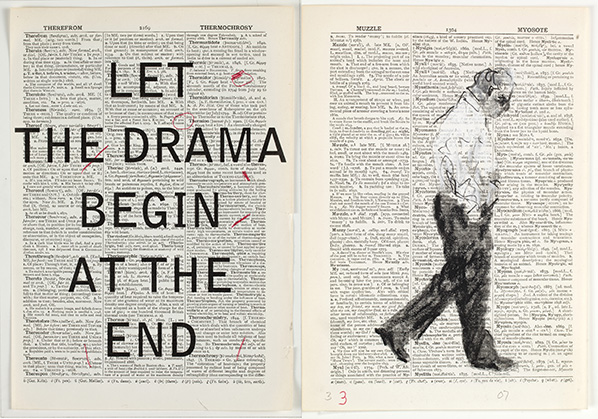
There are six rooms in all I think and all will make you feel and make you think new thoughts and a warm shock will run down your spine now and then in all those rooms. (One just one is not so good I think. Which one do you think it might be?)
There comes a point where words cease to be of help. Where they lose their point or at least their edge. For just think if we could gloss the whole of a work of art why would she or he who made it want to make it—the art ? There comes a point where words must stop where we must look and feel and not say. And if we know when to stop it seems to me we are wise and we know how to live. And in a way I think this work might help us to know how to live.
Michael Szpakowski October 2016
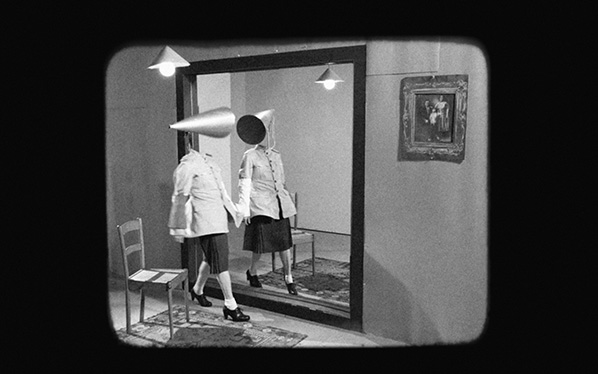
A Book Review for Benjamin Peters’ How Not to Network a Nation: The Uneasy History of the Soviet Internet, The MITPress, 2016
“At the philosophical scale, the abundance of information and the plurality of worldviews now accessible to us through the internet is not producing a coherent consensus reality, but one riven by fundamentalist insistence on simplistic narratives, conspiracy theories, and post-factual politics. We do not seem to be able to exist within the shifting grey zone revealed to us by our increasingly ubiquitous information technologies, and instead resort to desperate modification strategies, bombarding it from the air with images and opinions in order to disperse and clarify it. It’s not working.” -James Bridle [1]
In Benjamin Peters’ “How not to Network a Nation” we learn that the USSR had the engineers with the technical knowhow and capacity to construct national computer networks of scale. Indeed, the Soviet military had such a network already in the 60s, but the question Peters wants to ask is why the USSR did not develop a ‘civilian’ computer network akin to the Internet we know and love today. The USSR did not develop a ‘civilian computer network’ because there was officially no part of the society which was independent of the state. Also, by the time anything approximating what we call the Internet began to emerge in the US, the USSR was already deep in decline. Thus, Peters’ question is moot and he only finds what is obvious from the beginning: that the social system of the USSR was incompatible with the liberal information-sphere of the capitalist West.
The book, though, should be praised for opening up and translating to English various documents, not yet available, which describe the work of early Soviet cyberneticists, and for mapping the institutional vicissitudes of the USSR at the time. We learn, for instance, about the brilliant cyberneticists Anatoly Kitov and Viktor Glushkov and their travails attempting to gather institutional support for a national civilian computer network in the USSR. Glushkov’s atrophied OGAS project forms the central narrative of the book, a project for an Inter-network of computers proposed years before Vint Cerf coined the term Internet in 1972. However, rather than appreciating the precocious cybernetic accomplishments of early Soviet theory, Peters blandly uses the “failure” of the OGAS to argue that the USSR was too perversely corrupt and bureaucratic to let progress take its course.
“Because the OGAS threatened to reorganize the social and economic spheres of life into the kind of national planned system that the command economy imagined itself to be in principle, it threatened the very practice of Soviet economic life: in [Eric P.] Hoffman’s analysis, “creates more choice and accountability and threatens firmly established formal and informal bases of power throughout the entrenched bureaucracies” [2]
Interdisciplinary historical studies of the academic, philosophical life of the USSR in English are sorely needed. Peters is sadly not sufficiently technically competent to give the reader any substantial insight into the structural concepts or proposals of the early USSR cyberneticists. It is certainly not clear from the information in the book whether any of the proposals would have produced anything akin to the Internet. In order to compensate for inadequate knowledge of political economy Peters sadly defaults to half-hearted liberal reproaches.
“Glushkov’s vision directly opposed the informal economy of mutual favours that oiled the corroded gears of Soviet production. In the end, the OGAS Project fell short because, by committing to rationalize and reform the heterarchical mess that was the command economy in practice, it promised to encourage the rational resolution of informal conflicts of interest — which worked against the instinct to preserve the personal power of almost every actor that it sought to network.”[3]
For readers interested in how the various prototype networks in the USSR (the OGAS, ESS and EASU) technically actually worked, anything about the USSR military computer network (analogous to ARPANET), how USSR computer industry differed from that of the capitalist countries, o how USSR computer theory differed from that of the capitalist countries, the book experience will be disappointing; it has too little of this. What’s really lacking is a strong attachment to the subject, the meat and bones of the OGAS, its material scale, how the projects actually ran, on a daily basis. Peters’ seems more passionately concerned with reasserting that capitalism is better than socialism because it produced the Internet.
Peters’ thesis is specious: “The first global civilian networks (sic) developed among cooperative capitalists, not among competitive socialists. The capitalists behaved like socialists, and the socialists behaved like capitalists. “ [4] The capitalists in this formulation are merely individualists, who, to Peters’ mind, surprisingly cooperated to build the network. The socialists, in his formulation, are altruists who couldn’t live up to their principles, competing with each other for resources like professors in a badly run faculty. Peters unfortunately appears not sufficiently interested in either socialism or capitalism to nuance these historically heavily-laden terms.
The utopian project, imagined by the Soviet cyberneticists for the USSR and exemplified in the Cybersyn project in Chile, was that a socialist society could manage the entirety of national production distribution and disposal more efficiently and effectively through an internally transparent communication system. Cybersyn was, however, no prototypical Internet. Such a network as Cybersyn would also likely have to be highly secure (since national security would depend on it) and the data exchanged there only selectively available to an exclusive few. Thus, such a system would not likely have produced the vibrant media environment of the Internet we know today.
Peters does not technically imagine how such alternative forms of networked computation might work. Instead he consistently returns to the vague claim that the USSR was too ideologically conflicted, flawed and corrupt to allow the flourishing of the genius of figures like Glushkov to permit the panacea of an Internet-like network to be developed there. “The history of the OGAS project is akin to the history of a miscarried effort to perform an IT upgrade for the corrupt corporation that was the USSR itself.” [5] And cloaks his disparaging attitude in befuddling doubletalk. “The Soviet network projects did not fail because they did not possess the engines of a particular Western political or technological values. They broke down for their own reasons.” [6]
What reasons? They broke down because there could be no Internet in the Soviet Union.
The book points out that the difference that created the conditions for the development of a civilian network such as the Internet was the fact that the US had a private sector which could fund research and production independent of central governmental approval. Curiously, Peters’ gives the example of Paul Baran, inventor of the packet-switching technology essential for the Internet as we know it today, who, seeing his projects disregarded by the priorities of the military industrial complex at the time, eventually abandoned it, only to see it implemented in the US after the British Post system’s research generated the same idea. Here we have two “socialist” government-funded communication projects in “capitalist” competition, apparently the secret to the technical success of the Internet.
A Soviet civilian network, equivalent to that of the nascent Internet in the US, would have meant a network of scientific/academic institutions working outside the classified military information-sphere. There was no such “civilian” sphere. What Peters shows instead is that many of the efforts to implement a national computer network outside of the military were reformist, intending to ‘liberalize’ the Soviet economy and make it more compatible with the capitalist West. “Most of the new employees [of Glushkov’s state-of-the-art cybernetics institute CEMI] were young researchers with bold ambitions and a distaste for the culture of totalitarian control in the 1940s and 1950s. Enthusiasm for decentralized economic reform met with central flows of funding”. [7] Glushkov’s senior ally in the bureaucracy Vasily Nemchinov “sought to impose ‘economic cybernetics’ and its plausibly nonsocialist “dynamic models of balancing capital investment” in the ideologically most acceptable light”. [8]
Peters points out that the USSR’s ideals of social egalitarianism were superimposed on a society which was not used to such a distribution. It is often argued, that, unlike Germany (which Marx & Engels had in mind when they wrote their Manifesto) pre-industrial Russia was lacking the institutional, industrial and economic basis for socialism. The result was that the highly abstract egalitarianism of socialism clashed with the conditions on the ground there, and generated more contradiction, inefficiencies and strife.
The promise of socialism, though it is unprecedented, is that a fairer juster society for every inhabitant of the earth can be achieved. The contradictions between the ideal and the reality need to be allowed to run their course, but this time was not afforded the USSR, as it was not afforded Chile, Cuba, Venezuela, Congo or any other nation which have dared strive for an egalitarian society. Lenin, Allende, Castro, Chavez, Lumumba came to power through popular and democratic processes but were attacked mercilessly, undermined, even assassinated by intolerant reactionary alliances from without and within. Remember that minerals from the de-liberated Congo [9], fundamental to networked computing today, are extracted under the most extreme injustice and exploitative coercion.
Peters claims the the US “succeeded in “networking a nation” because its ethos is to ask “how“ rather than “why”, and that the USSR failed because they were too concerned with “why.” The inertia of systemic unfairness socialism has to confront is immense, and, since it must deliver on its promise to improve the living conditions of the great majority, it is understandable that considerations of “why” will slow down technological choices on a national or global scale. The US and Western economies under their influence had much less of such moral compunctions. Capitalism “frees” entrepreneurs to scale ideas up to industrial scale and ‘externalises’ any deleterious consequences. Today in the age of automated techno-industrial-powered environmental degradation, resource wars and climate change, it appears far too late anymore to ask “why.” Networked capitalism has long had the answer to “how”, though: more computers.
It seems Peters wants to say with this book that socialism can be good as long as it takes place within capitalism. But since Peters’ conflates capitalism with individualism he does not see that this would mean socialist practices merely serving their conventional function as unquantified subordinate contributions to rationalizing capitalist exploitation. When Peters writes that the US built the Internet because their capitalists behaved like socialists, he is merely indicating that socialist practices are a well-spring of the value extracted by capital. Marianna Mazzucato argues convincingly how public investment in fundamental education, technologies and infrastructure brought about the great prosperity (such that it is) and unprecedented cultural affordances such was we enjoy through the Internet. [10] Socialists build things for use value, capitalists build things for surplus value. The huge edifice of Internet-based and coordinated commerce is build on functionalities built in the public interest, not to mention the house of cards ponzi scheme of contemporary financialized capital. The grand juggernaut of US capitalism is still running on infrastructure built during its brief social democratic experiment in the 1950s, which itself was a concession to labour in order to ward off nascent communism at home.
Jeremy Corbyn aims to produce a surge of public investment in vital infrastructure, which, in the proceeding decades it can be assumed, will be reappropriated piece by piece by capital. Public spending on public services do not produce merely quantifiable benefits for “stakeholders”; they produce qualitative improvements which cannot be reduced to commodities, and therefore do not require computer networks to manage or employ, but on which we nevertheless all depend for our social lives.
It is fashionable today to envisage that we are heading, or should head towards a sort of “Fully Automated Luxury Communism” (FALC), where an Internet of Things, transparently managed through a hive-mind, public-access liquid-democracy interface, a civic HyperCyberSyn, will provide unprecedented industrial efficiency and irrepressible prosperity, automatically for all. History shows however that such a system would be set upon and usurped by powerful alliances, just as has every technology in the history of humanity, for the benefit of the few and the detriment of the many. In the meantime, instead of FALC, we get Opportunistically Accelerated Predatory Rentierism, cyborg capital serving a persistent fully-automated financialized rent extraction system.
Peters attempts to close the book on a conciliatory note. “Neither American-style capitalism nor Soviet-style socialism should be considered a sufficient philosophical banner for making our way into a networked world… The social necessity of restraining self-interested competition unites, not divides, the modern legacy of cold-war capitalism.” [12] Peters’ appears to propose that capitalists (in his taxonomy) are the true socialists since they acknowledge the limits of their self-interest whereas socialists are dangerous because they must pretend as if self-interest doesn’t exist. But what can the benefit of this caricature conciliation of socialism and capitalism be? Only if we can mutualize the rentier system for the benefit of all according to their needs will we generate societies of sustainable social and economic justice worth the name communism, with all the myriad revolutionary technological affordances we can barely imagine today.
The exhibition Power and Architecture was created for viewing across several months in a particular sequence. Part 1 focused on Utopia and Modernity (12 June – 3 July), Part 2 on Dead spaces and Ruins, (July 4 – August 10), Part 3 on Citizen activated space — Museum of Skateboarding,(11 August – 11 September), and Part 4 on The afterlives of Modernity — shared values and routines, (15 September – 9 October). A conference held in June – The Centre Cannot Hold? –led by important scholars Michał Murawski (SSEES, UCL) and Jonathan Bach (New School, New York) served to frame the cultural, political, economic ramifications of “centrality and monumentality in 20th century cities” with thought from prominent researchers, architects and artists. Power and Architecture concluded this October as the Calvert 22 Foundation partners with innovative architecture, design and engineering collectives Assemble (UK), Museum of Architecture (UK) and reSITE (CZ) and an Urban Research Mobility Lab connects London with Prague by asking the question: how does migration and mobility in cities affect the experience of the urban environment? A curated series of reports, essays and photo stories further explored the themes of Power and Architecture in the online Calvert Journal available through the gallery website.
Calvert 22 is a gallery devoted to contemporary Eastern European and Russian art. They presented this exhibition as “a season on utopian public space and the quest for new national identities across the post-Soviet world.” I arrived at the gallery, a Californian artist, coincidentally just as I’d read comments from Lev Manovich about the young intelligensia of post-Soviet Russia. Thus, when thinking about the exhibition, I was also thinking about the new global mobile class and the impact of Putin’s Russia upon a new generation.
Power and Architecture is a fascinating collection of research into contemporary art, films, and research about post-Soviet urban identity and the positioning of artists therein. Obviously once communist societies have experienced dramatic change since the fall of the Berlin Wall, collapse of Soviet Russia, and rise of Putin to power. Curators used multiple cultural lenses with which to pry open a critical “western” eye on the aftermath of the Soviet era and invited exploration of cultural narratives about the “post-Soviet” city. The exhibit, particularly in certain places, looked at ideas which appear to have disappeared or become outmoded as a means of aesthetic and political communication. There was an air of longing and self-reflection towards Russian identity when experiencing the work. The Russian people have something to reckon with; a revolutionary utopia which once was, but which is no more and which has left them with the traces of an almost empire,- although to call communist Russian an empire seems to obscure the politics of the revolutionary element-. These juxtapositions were in essence the heart of the show which explored the Soviet Union as constructed space. This ”location” then functions as a backdrop to present-day national identity and urban design emerges in the portrait of a “post-Soviet” society with its own futuristic ideas as well as in the lingering relics of Soviet intentions.
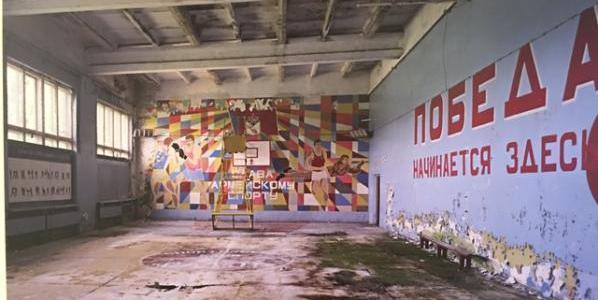
Power and Architecture falls on the heels of Calvert 22’s very successful Red Africa program which examined the cultural, economic and social geography between Africa, Eastern Europe, Russia and related countries during the Cold War. The Eastern European art historical and social trend of the last thirty years labelled ‘self-historicization’ –or the self-conscious effort for Eastern European and Russian artists to articulate, archive, and collect their own history, is exercised throughout the exhibit itself designed in series of presentations directed at the problem of “historical understanding” of history. The post-Soviet city and utopian public space was used as a critical framework from which to position contemporary space, identity and the intent of the exhibiting artists. The Soviet Union has fallen, but who or how is its revising and re-examination taking place?
Part 2 which dealt with “dead spaces”, the architectural ruins of empty cities, military bases, technologial infrastructure and cavernous, open landscapes at once modern and moribund seemed to suggest that retrospective analysis of utopia could only be a well-conceived guess at what was or might have been. This Part was a sojourn into the life of Soviet artifacts both remaindered in their historical trajectory and as a convincing backdrop to a pervasive contemporary ambivalence. Danila Tkachenko’s “Restricted Areas” for instance, was a series of photographs documenting relics of the military build up of the Soviet Union only to be found on abandoned, snow-covered sites in the frozen tundra. Oversized photographs of personal ID cards from unknown persons presumably found amidst Soviet architectural rubble, large format, richly-detailed color photographs of crumbling rooms, weather-worn, orphaned Soviet-era paintings, and peeling, once colorful murals inside Soviet military bases and institutions form an historic record of obvious and shocking lack of preservation of Soviet art and architecture as Russian history. Artists participating in Dead spaces and ruins were Vahram Aghasyan, Anton Ginzburg, and Eric Lusito.
To say that this work engaged narratives which imbue modern mythologies of “utopia” with certain ideas, or contained evidence of the self-conscious effort to bring post-Soviet identity into the picture is an understatement. ‘Utopian’ ideas’ exhibited, situated in urbanism and public space, were the self-conscious investigation of old or familiar‘ or “statist” (maybe) viewpoints on public identity and gave curious attention to questions of truth, experience, voice and historic preservation found in documentary discourse. Self-historicization was apparent in Russian artist Kirill Savchenkov’s Museum of Skateboarding, a mixed media installation, which was its own entire Part 3. Savchenkov’s piece talked about the activation of public space by young people and about skateboarding as a means through which to reflect upon the post-Soviet residential suburbs of Moscow. This work suggests how certain architectural interventions or objects contain meaning and can even be accessed differently or more significantly through subculture. It alluded to tropes in notions of “world” or global “utopia” which translate across seemingly disparate spaces and identities such as Californian and post-Soviet/Soviet Russia. Moreover, this reading of public space as accessed and interpreted by youth is a powerful concept about notions of history and who it belongs to.

In Part 4 (on through Oct. 9) the urban poetics of the post-Soviet city are further contextualized by looking more closely at modernity and everyday life. The afterlives of Modernity — shared values and routines. This Part concluded the exhibit with four artists, Aikaterini Gegisian, Donald Weber, Dmytrij Wulffius, and Ogino Knauss, who examine the “afterlife” of the utopian endeavor, especially the search for new national identity. This theme is provocative to be sure, given the current political contest in the Ukraine and Russia’s role in Syrian conflicts. The curators write:
“Across the former Soviet Union there are a series of architectural and physical nostalgias connecting citizens who share the same socialist history – Part 4 of the programme reflects on these shared values and routines for citizens today.”
I asked myself the question—how does art tie societies together through processes of change? Aikaterini Gegesian’s film, “My Pink City” offers a portrait of a post-Soviet Yeravan in transition and depicts the militarisation of public space and the gendered divisions within the city. In many instances, Russian government has pushed for laws “designed to rid Ukraine’s public spaces of communist relics. Their destruction proclaims a deep desire to change the cultural narrative.” In Part 2 many documentary photographs of “dead” Soviet relics are a poignant record, and politically at odds with ideas at play in contemporary Russian national consciousness. It is a record which rightfully belongs to the Russian and Ukrainian people and which makes this show more meaningful when thought of as the struggle to preserve the past for the future.“Monumental Propaganda”, a series by Donald Weber documenting sites where Soviet monuments stood and the empty pedestals remain, speaks to exactly this. Dmytrij Wulffius’ “Traces on Concrete” is a series of photographs taken from 2009 and 2013 of his own hometown, Yalta in Crimea, which also explore its architectural landscape from the perspective of modern youth. “Re:centering Periphery: Post Socialist Triplicities” by Ogino Knauss is a fascinating examination of post-socialist history in Berlin, Belgrade, and Moscow, three cities in which modernity triggered profound utopianism towards the “radical transformation of the everyday.” The piece looks at “what is left of the architectural vision in the cities and what this legacy leaves to citizens”.

Power and Architecture aimed at a present-day coming to terms with a particular Russian existence now broken into segments and pieces. It focused profoundly on the precarity and erasure of history which plagues 21st century thought on so many levels.The real and the fake, the true and false, the meanings of “Soviet utopian vision” and its presence in time in architectural and artistic form. Without quite melding together as what that vision was in the political sense, the show formed a quasi-science fictional narrative and interpretation; a history of place, both real and imagined; promised and denied.
Central to the visual collection and comprehension of these ideas was, curiously, the strategy of the archive where the act of collection takes place and where the borders and edges of history are possible. By focusing upon the urban environment of the Soviet Union now past, Power and Architecture asked us to consider ‘what modernity is” in this context. If it is machine aesthetics as James Bridle (2011) suggests, then which machines have contributed and how do we use this modern aesthetic position on technology to examine a past? If it is the new aesthetic to be looking at old relics with a different lens, then what intellectual “spin” is constructed? For whom, how, and for what? Maybe modernity is all of these—a presence of unprecedented scale in terms of cities, and the sky and the water. How do we see this totality now? How did they see it then?
Modernity did come upon Eastern Europe and Russia, arguably in similar and dissimilar ways to how it was absorbed in the west. Power and Architecture re-examined the Soviet epoch, through what artists are seeing and thinking about what has remained. It seemed expressed as a brute emergence of a set of ideas which, because they were collective, revolutionary, technological, shaped and still shape Russian consciousness, but as a past. How the past is preserved or ingested is again a compelling idea on the power-struggles for “history” which take place in modern times. Power and Architecture elucidated key features of this new era of global subjectivity and societal change through creative lenses of the recent past.
When looking at the many artistic projects focused on how and why we use the internet, it’s easy to find yourself lost in a field which doesn’t show obvious, strong ties with what we normally know as “traditional art history”. This is due to historical and social reasons that emerged between the 80s, 90s and early 2000. These artists were at the vanguard of art culture and pushed at the edges of what art could be, whilst living in a post-punk and postmodernist era, and on tip of this, the arrival of the Internet in 94 changed everything. Many artists took on the challenge of what the Internet offered the world creatively, and explored it not merely as a marketing tool or a place to upload images and videos, but as a medium in its own right, inventing new technically informed, artistic tools and also building grass root led, networked art groups with new infrastructures as cultural platforms. Turning away from anything relating to the mainstream art world and what was seen as outmoded and tired traditions.
In the last decade, we’ve seen the expansion of the Internet and its use by younger generations where the medium is no longer something you exploit to change the culture, but more to integrate in traditional terms, canonical contexts.However, artist Jan Robert Leegte (born in 1973) is a very important figure to reflect upon, in order to understand this transition; while other artists of his generation were taking the internet for a non-hierarchical distributed system, he chose to explore it from a classical studies background that forged the cardinal points of his artistic research. He reflects an Internet art influenced practice which not only exists online but also in physical space. In fact, we can safely say he can be considered as one of the first Post-Internet artists. This makes him a pivotal figure in this historical segment and it’s under this light that one must visit the online exhibition On Digital Materiality (Carroll / Fletcher Onscreen, 3 August-12 September 2016). It’s a retrospective show presenting some of the most important and representative works of the Dutch artist, who wrote for the occasion an essay in which describes some of the most important aspects of his work.
Leegte says, the “materials I first used were basic HTML objects, buttons, scrollbars, frame borders, table borders, and also plain color fields and found images. I questioned what it was that rendered this practice similar to making installations rather than collages. At first it was the simulacrum of real world interactive elements (buttons, window frames, etc.). The operating system extended this haptic strategy with traditional paper-based forms, like check boxes, text fields, lists, etc, and, along with the form elements and the interactive document, led to an ecosystem of fake 3D, interactive objects.”
The work fluctuates between working on the surface and thinking in three dimensions. The same difference can be found with his use of Photoshop and HTML. If in the former case an image editing software operates directly on the final result, for the latter there is the need to know how to write code while at the same time imagine what the potential results will bring via its translation in the public space, the internet. In this sense, we do not hesitate to define Leegte as an artist who studies and uses the tools of the sculptor; he wonders how to place objects in the space, he feels the problem of contextualising a work in relation to a public and physical environment.
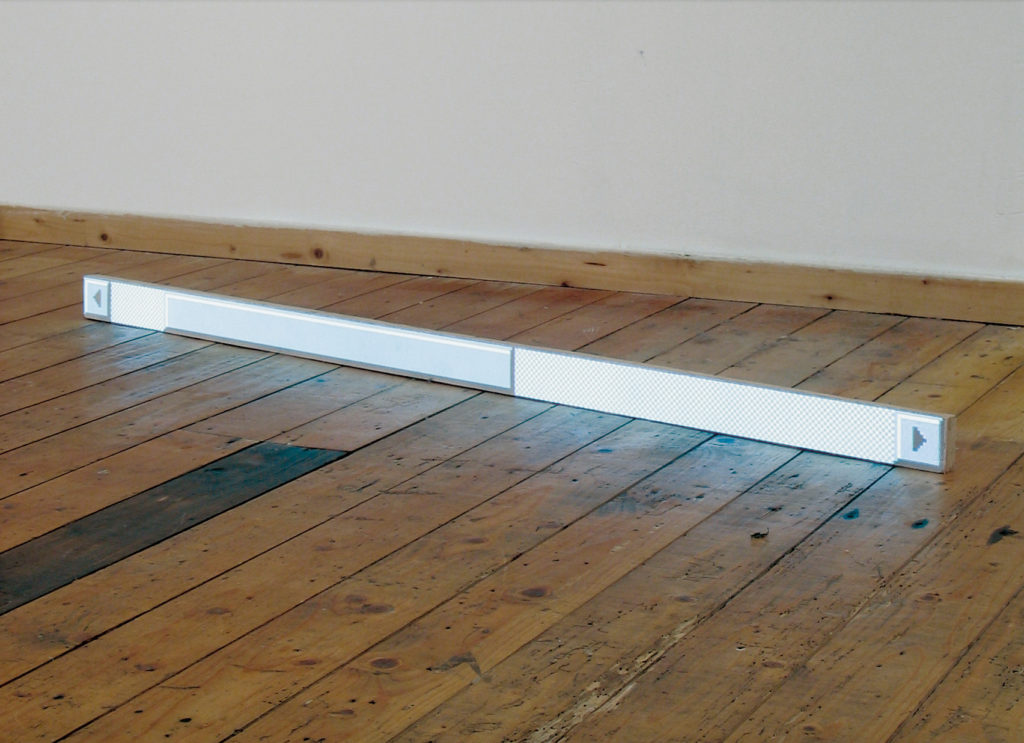
The perception of a substantial difference between surface and space is also proven with his interest in the basic elements of composing the digital interface (scrollbars, mouse pointers, etc). His research examines the artificial environment built by Microsoft and Apple designers. The colours and the shapes were designed to not be perceived as evident mediating agents between the user and the content – in this sense, it is interesting to note that Microsoft has often chosen a minimalist style (shades of grey, square shapes) while with Apple systems the style is usually more exuberant.
However, we should not look at the former as a less culturally relevant product. In the same way, we should not take the white cube exhibition space as a synonym of neutrality (unless we want to think that the whiteness and emptiness stay for an objectivity). This is an aspect that the artist does not seem to detect (in the text, he writes that he “preferred the aesthetics of the Windows classic interface design because of its minimalistic design – no rounded corners and ribbings like the OS 9 design, but simple beveled grey rectangles and a button object was merely a highlight and a shadow, nothing more”).
The artist reflected on how specific design elements may in some sense be preserved, as reflections and products of a particular aesthetic and cultural taste: “In Memory of New Materials Gone” (2014) is a work made by a print of the OS9 scrollbar placed in a transparent case in the same way you would do with an object no longer fashionable. This project and all the other works belonging to The Scrollbar Composition Series programmatically address the perception of virtually anonymous and transparent objects on the screen in a three-dimensional space. In a situation where their significance must be noticed; it’s the artist himself who begs to not see in this a disruptive act, an action that reveals the subtle ways in which they influence us. It is, however (but not “in opposition to”), a reflection on the artist’s activity; as we previously noted, these works are shown on the internet in the same manner in which they would be set up in a gallery space.
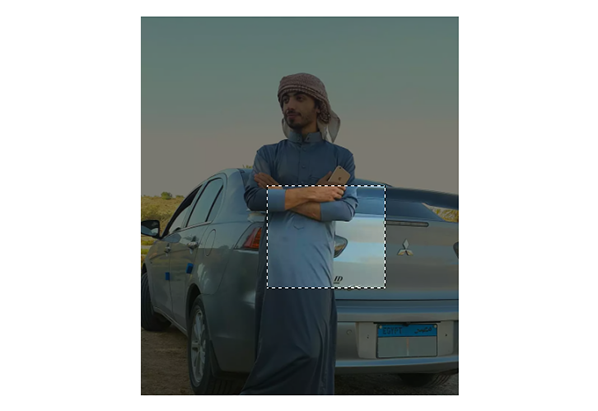
Perhaps, the highest point of the artist’s reflection on the differences you meet working on a surface or in three dimensions is The Photoshop Marquee Selection Series. “Random Selection in Random Image” (2012), in which a randomly generated selection marquee is shown within an image randomly obtained from the net. It is the most important work of this series because it opens three-dimensional gaps which have been created sculpturally in two-dimensional images – a dynamic that has echoes of “Scrollbar Composition” (2000), in which the Web browser’s monodimensional space is broken down and reassembled in many windows, many independent spaces sharing only the mathematical material they are made of.

The works featured in this exhibition are related to questions that go beyond the historical and cultural contingency in which they have been created. This makes many of them feel very much alive even 20 years after their creation (a novelty in digital art, I would say). This allows a healthy dialogue between different generations of artists to exist as common ground. It also engages art experts who want to be introduced to artistic issues linked to the internet. It is a dynamic that makes this exhibition a special opportunity for us all to relook at this so-called digital culture and its traditional and non-traditional art theories and its practice under a peculiar and exciting light.
On Digital Materiality – an Internet exhibition is online at Carroll / Fletcher Onscreen until 12 September 2016
What is the relationship between state corruption and economic collapse in Greece?
Lina Theodorou, artist and creator of the board game ‘Pawnshop- Days of Mistrust’, talks with Furtherfield’s Ruth Catlow about Grexit, Brexit and crisis in Europe.
I met Lina Theodorou, the artist and creator of Pawnshop, in her apartment on a sunny Sunday morning in Berlin. It was just one week after the UK referendum resulted in a vote to leave the EU. I was in Berlin to take part in an event called Art, Money & Self Organization in Digital Capitalism, the first in a series of events called Arts and Commons, organised by Supermarkt.
Theodorou and I quickly got onto the topic of Brexit. We compared notes. She wondered if, like Greece, the UK government would choose to ignore the result of the referendum, fail to invoke Article 50, and stay in Europe after all. That possibility had not occurred to me. She talked about her memories surrounding the Grexit debate- the distress, the uncertainty, the shocking hatred and hostility expressed between family members and people previously considered friends. I had been deeply shaken by the upsurge of street-level racism on the streets of Britain.
Pawnshop, the artwork that is also a board game, was set up for play, laid out on a table in her studio. It is an inversion of Monopoly: the same square board, the pieces, the bank, the cards, the dice. However in this game the player starts the game with no money, only property – jewelery, a bouzouki, antique furniture, a flat- and pays a European tax of €1500 when they pass Go (if they get that far).

Players proceed around the board, according to the luck of the dice, along a path strewn with dilemmas. A second row of squares is used to keep track of the time spent dealing with the consequences of their choices- jail sentences, or hospitalizations for example. As they move around the board, they pick one of the cards, depending on their landing square, and must choose how they will respond to the given dilemmas.
Theodorou tells me that the game is based entirely in fact. For years she has collected newspaper stories in Greece. And here they are gathered in four categories of cards – Dilemma, Involvement, Debt and Luck- to encapsulate the experience of daily life, for everyone, in modern day Greece. ”If you are honest you lose” she says.
On her website are photos of engrossed players at Bozar, Center for fine arts, Brussels; at the exhibition TWISTING C(R)ASH; at Bâtiment d’Art Contemporain « Le Commun » in Geneva; and at the exhibition It’s Money Jim, but not as we know it, at Mario Mauroner Contemporary Art Vienna, and As Rights Go By, Museumsquartier, Vienna. She says it’s important that at the beginning players laugh… but because of ”synesthesia”, the longer they play, the more uncomfortable they become, they feel the ethical discomfort in their bodies.
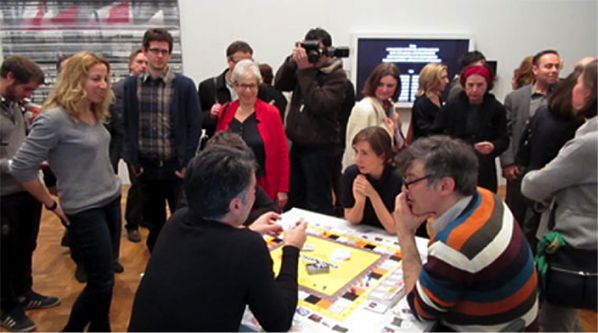
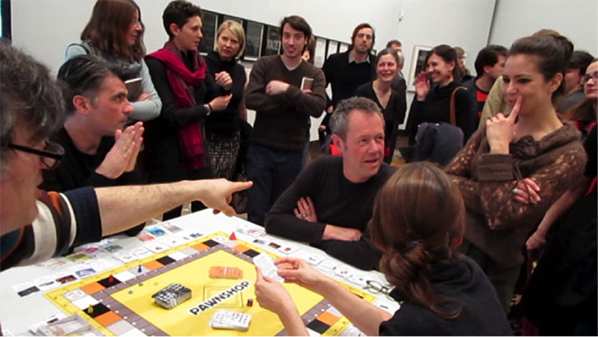
Theodorou and I digress again, coming back to the Europe question. Because I’m in Berlin I think about Germany’s role. Germany at the heart of Europe is perhaps more part of the problem than they realise. The style of bureaucracy is molded to reflect the German mentality and their industrial system.This is coupled with a confidence in the correctness of the system – that Theodorou points out, is accompanied by the Northern European, Calvinist attitude – anyone who does not comply is wrong and must be punished. “But what is good for Germany is not necessarily what is good for Greece” she says. In Greece for many years the economy was made up of many small entrepreneurs, small businesses, shops, and a community focus” Why must we suddenly give this up in favour of big business. “Why do you have to destroy something that is healthy?”After the banking crisis in 2008 pawnshops started popping up on every street in every town in Greece.
Theodorou tells me that Pawnshop is the Greek reality board game.
“Your father is sick, do you pay his hospital bill?
Yes: pay €3000 and he lives for another 6 years,
No: unfortunately he dies, but you receive a life insurance pay out of €75,000”
Picking an ‘Involvement’ card means that that player’s decision will have consequences for other people too; Debt (is the biggest pile of cards).
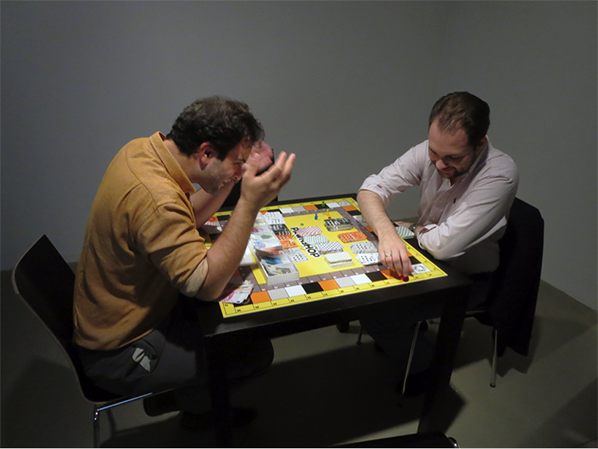
Gentrification strategies have failed in Athens. Back in 2006 the rich Greeks, many of whom were also art collectors, started to organise the large scale art events, (in which of course the artists worked for free), but it didn’t take. Then in 2008 the banks collapsed, the economy became surreal, but somehow, Athens remained the same. Perhaps this because regeneration does not have the ever-rising bubble of property prices to support its economy. In Greece everyday people do not speculate on the housing market (as we do in the UK). Rather a house is something you keep for ever in the family.
Theodorou describes the real world Greek tax system as “insane”. It changes every 3 months, Even the accountants have difficulty keeping up with the laws. This alone forces many people into the black market. Then the web of bureaucracy protects the hierarchical status quo and people in higher positions hold onto their power by putting obstacles in the way of others.
The only way to win this game (on the board and IRL in Greece) is with good luck. Good luck is the only way to avoid ethical discomfort or financial ruin.
The Luck cards (also based on fact as reported by the newspapers) are hilarious. “A politician hits you with her car, but fortunately the accident is witnessed by the media – collect €2500”.
“Some rich ladies wish you a Merry Christmas and hand you €100”.
Apparently Athens newspapers have reported tales, for the last few years, in which “ladies” have distributed money to “the poor” from black windowed limousines.

Pawnshop is a polemic on corruption. Small corruption. Long standing, Greek-style, everyday corruption from which no-one can escape. The universal, forced collusion in corruption, and its corrupting effect on the spirit of Greek citizens and society, is set out in the game mechanics. The playful and social medium of the game means that the impact of contemporary Neoliberal politics on the Greek ‘everyman’ is made legible, feelable and discussable: unending, ethical traps; the impossibility of old-style moral political clarity; the flushing of righteous action, solidarity, resistance or even survival. Corruption all the way up and down.
I question Theodorou carefully, because I have long been suspicious of the narrative that says that corruption is the cause of Greece’s economic problems. But the corruption is a fact. While it is not necessarily the only or even the primary cause of its economic distress – which is very very real- the lack of trust in the state is debilitating and has a stagnating effect on the economy.
Pawnshop sits in an honourable tradition of artist’s activist games: to change mindsets and attitudes by actively implicating players in a reconstruction of values – see Mary Flanagan persuasive research about crticial play and the many attitude-hacking games coming out of her lab Titlfactor. Also Brenda Romero’s chilling Train game, Yoko Ono’s Play it by Trust. And for games that train for resistance and solidarity in games such as Escape from Woomera, Debord’s Game of War, and my own pacifist chess hack, Three Player Chess.

A look around Theodorous portfolios of works reveals a long practice that crosses agitprop, video, installations, and networked pieces.
The work all builds on close observations of contemporary political and social systems. Through graphical exuberance and humour these observations are rendered just (barely) bearable so that we are able to spend time with complex, difficult situations and suspend our certainties. And this is necessary and important. We need to face the complexities and ethical contradictions of contemporary politics. There’s no time to lose.
Before the referendum, I found myself uneasy about actually campaigning for “Remain” in spite of my desire for a pan-European peoples’ alliance. This was because I couldn’t ally myself with the dominating political arguments proposed by the Conservative party (and backed up by big-business and the establishment). I also didn’t want to participate in a binary campaign that stamped on the dignity of the layer of people in the UK who are already so disenfranchised by the effects of austerity cuts (and many years of other systemic injustices). This moment revealed for me, and for many others in the ‘social liberal’ layer, a chasm between my own values and experience and those who voted to ‘Leave’. And a desire to find a way to connect. PostBrexit the reality board game may be just the thing we need to help us come together and play our way through the effects, consequences and possibilities.
During my visit to Ars Electronica I was humoured by the excessive amount of ‘hello world’ creativity that is often produced when science and technology meet and exhibit interactive spectacles that make very little claim other than an enchanting proof of concept. What I thought would be an interesting media festival turned out to be a robotics road show. This tech road show attracts over 90,000 people from Europe and Asia to wonder at the latest innovations in robotics, VR, bio-hacking, 3d printing, drones and anything that glossed the pages of Wired magazine as the next big thing.
The alchemists of our time, or as I like to call them ‘Dumb wizards’, are continuing to design and exhibit technological achievements in self-fulfilling speculative words that have very little concern, consideration or critique with any relevant social issues of our time. Excluding the CyberArts exhibition (curated by Genoveva Rückert), which I thought was a top selection of some of the best media art works of the last years, Ars Electronica is predominantly occupied by interactive spectacles that neglect to examine the social & political impact of technology.
To overlook how smart phones, big data and network computing are changing privacy & security, or how cloud based services are transforming the labour market or how Silicon valley start up culture has convinced a sizeable amount of the population that for every problem, there is an app based solution. In the bazaar of innovative design and interactive art I struggled to identify any work (be it art, product, or concept/agency) that voiced or articulated concern or criticism with technology, politics or social change. The most provocative aspects would be the whimsical one liner that is planted to introduce some speculative design projects, showcasing some daft prototype with a splash page and a quote in large font to grab the attention of the viewer.
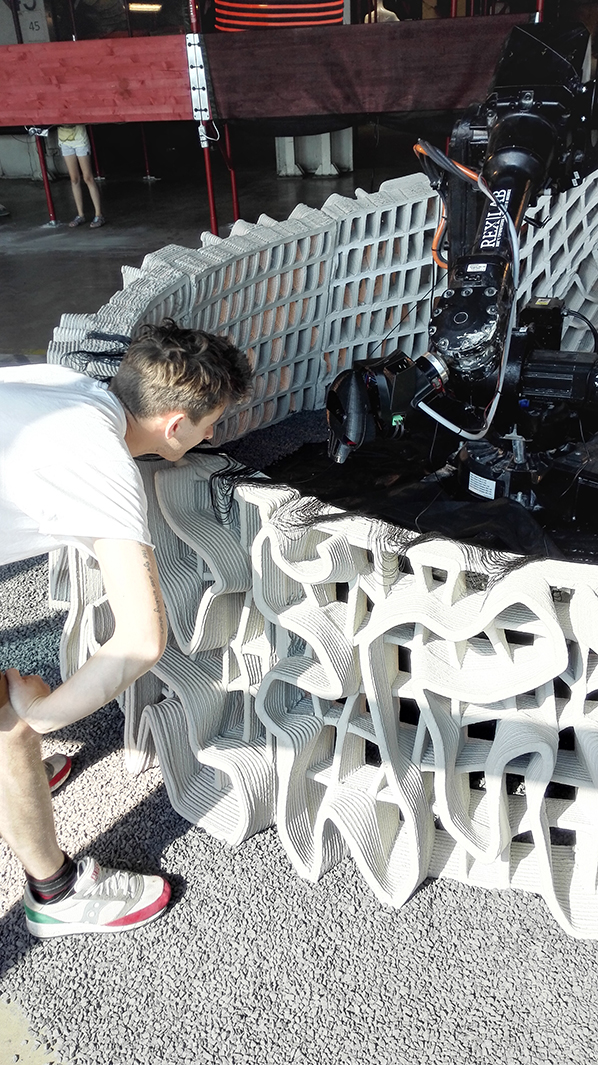
What is the gold of our time?
How do we build a social relationship with others?
Innovation: Where do we go from here?
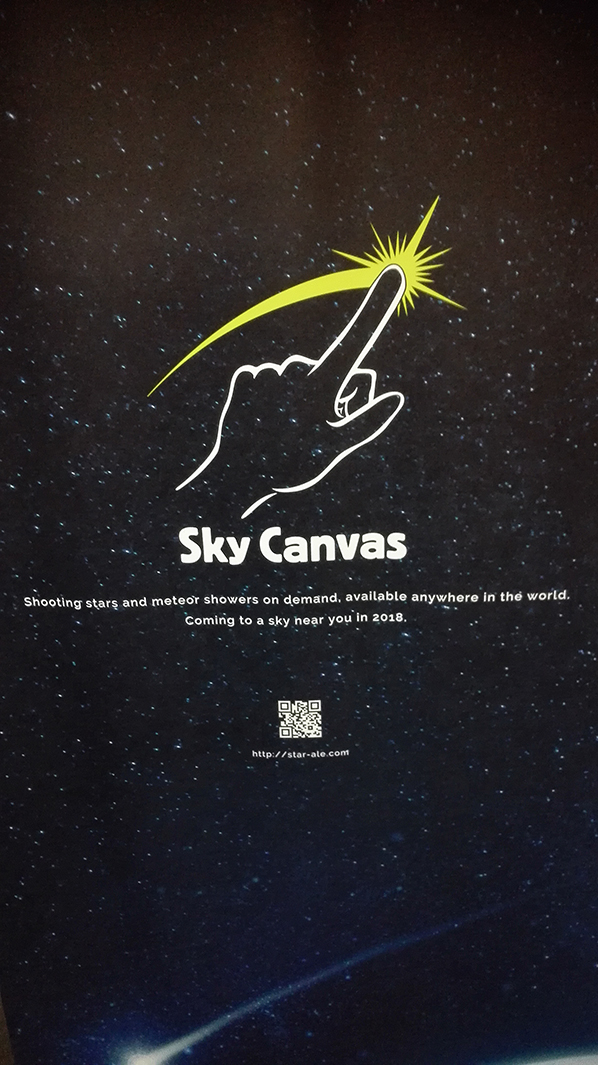
My favourite example of this was the disastrous ‘sky canvas: Shooting Stars. On demand’, an initiative to re-create the magic of a shooting star with satellite technology and glowing bits of plastic that can be shot into the night sky at the tap of a mobile app. The Alchemists of our time have fixed the magic of shooting stars. Great, thanks.
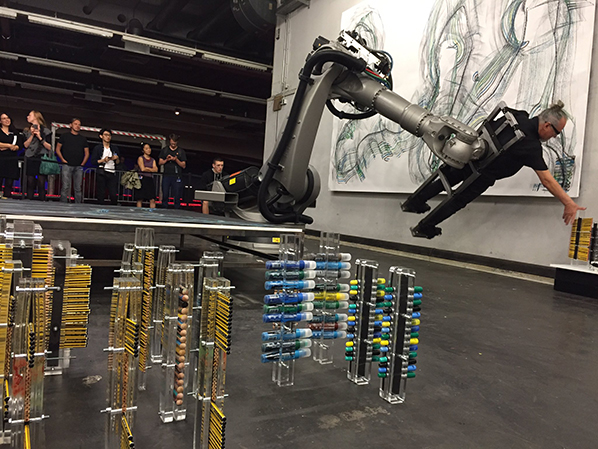
Much of the programme was better suited as light-hearted evening entertainment, drone racing, robot cooking, and endless drawing automaton. This robot, which I called ‘Human Pencil’ would throw around its inventor while he held 20 pencils and tried to make a drawing. Simultaneously inventive, pointless and entertaining; these robotic meme installations are better suited to robot fail video compilations on YouTube than to an art exhibition. The rejection of a critical consideration or a socio-political framing of the role of technology leads to what I call ‘enchantment art’, where the same devices used to execute mass killings in war zones become family friendly evenings entertainment.
Congratulations Dragan Ilić & team. Next performance at 10pm #Arselectronica16 #Artandscience @ArsElectronica pic.twitter.com/HgYXEctsYN
— GV Art (@GV_Art) September 8, 2016
So how has Ars Electronica, one of the longest standing and biggest media arts festivals in the world, found itself so far distanced from the political concerns surrounding technology? The first reason perhaps is that science does not bode well with critical theory. Many of the projects at Ars Electronica (again, excluding the CyberArts exhibition) feel like science museum artefacts that simply demonstrate technical (in)capability.
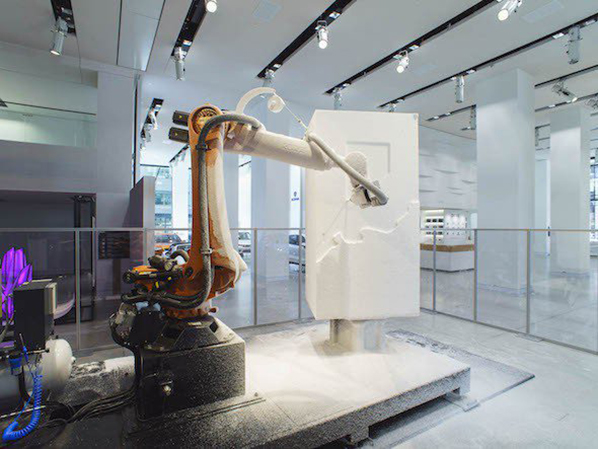
This attitude can be personified by the man I saw wearing a t-shirt stating “SCIENCE – It works, bitches”. Take for example this robotic arm reprinting Michelangelo sculptures which can only underline the immense technical potential of technology. Another possible reason perhaps that many of the works at Ars lacked social awareness is because they are produced by scientists & programmers in isolated laboratories. In this working methodology the viewer is rarely considered apart from in user tests, case studies and de-bugging. I found many maker lab types standing next to their large laser cutters avoiding eye contact while they printed out modular components and hoped for the next entrepreneur to walk past and slam down an investment fund. The lack of social awareness and engagement of issues surrounding our time have begun to impinge on the festival itself and an awareness campaign called #kissmyars is voicing concerns over the lack of female representation at the festival, particularly in the prix art prize which is awarded to men 9/10 times. The gender diversity in technology sector should no longer be ignored; this is one example of a socio-political issue not only overlooked at the festival program but also exacerbated by the organisation itself. I hope that the #KissMyArs campaign will not only rebalance the gender inequality at the event but also encourage the organisers to address other alarming realisations that operate within and around the application of technology in the social, political and economic sphere. Perhaps the Alchemists of our time should stop staring into the night sky planning the next life saving app and begin addressing the issues that applications can’t fix.
#KissMyArs
For more than two decades, Italian artist duo Eva and Franco Mattes have sought to subvert and expose the systems which produce power. Their current exhibition, Abuse Standards Violations at Carroll/Fletcher gallery, looks at who and what is made visible and invisible in the process of producing culture for online consumption.
The artists, who did not receive a formal arts education, describe themselves as “a couple of restless con-artists who use non-conventional communication tactics to obtain the largest visibility with the minimal effort.” They repeatedly worry the edges of technical structures – legal, religious, software – observe the resultant content and feed it back into new structures. It’s a process which acknowledges and seeks to communicate erasure, loss and chaos as well as their inverses. In Abuse Standards Violations, the artists acknowledge that chaos, and slippiness of boundaries in the arrangement of work that collides fragments of different disciplines and practices together.
The central work in the exhibition is Dark Content. When their project No Fun (2010), presented unchallenged in a gallery, was removed from YouTube on the grounds of being ‘shocking and disgusting content’, the Mattes’ began investigating content moderation. The video, image and text content we encounter on platforms like Youtube is there because it has been permitted to be there. To gain permission, content once produced must be approved. The approval process involves a number of decision-making structures. The rules determining which content passes or fails (is good or bad, safe or unsafe) are built by, and entangled with, the organisational framework of the platform. To deploy this framework and enforce its rules, algorithms organise data and trace patterns, and people – working as ‘content moderators’ – are paid to decide which criteria a piece of content belongs to, and act accordingly.
Eva and Franco spoke to a number of content moderators about their work. These interviews give insight into a role which is simultaneously powerful and socially stigmatised (one moderator does not tell their partner what they do); which, despite actively forming culture, is in many ways concealed. Following the neoliberal pattern, process is skipped over to reach the content; moderators are scarcely mentioned by the culture in whose production they are thoroughly implicated. This is unsurprising given that the moderators are people like you and me, as well as being points through whom the governing structures of social media can be accessed.
The Mattes’ interviews with content moderators are presented in the exhibition as stock avatars, preserving the anonymity of the speakers; away from the exhibition, the interviews can be seen only on the Darknet. The avatars in Dark Content are displayed on screens within booths constructed from office furniture; structures designed for typing and filing are flipped around like tetris blocks to become a new kind of structure. The furniture is simultaneously recognisable, and out-of-place – particularly, no doubt to the freelance, self-employed person who often works from the sofa or cafe.
BEFNOED (Be Everyone For No One Every Day), deploys unusual positioning of screens in the gallery space. Visitors are required to lie on their backs, crouch down or otherwise contort themselves in order to watch videos of other people carrying out banal tasks such as putting a bucket on their head. The latter group of people has been paid for their work, the tasks having been advertised on crowdsourcing websites. Both groups have spent energy and time on their endeavours, and now both come together in a space. The intimacy is an interface which suggests the connectedness of gallery visitor and global networks and their mutual implication in the way culture is produced.
The works in Abuse Standards Violations relate and separate different lives, different cultures and different kinds of labour. They muddle contexts and objects, creating spaces and structures that are – clearly and disconcertingly – no less strange than those already available in contemporary society. These spaces and structures complicate the difference between reality and simulation. They also make the distribution of power painfully clear. For a powerful structure to appear trustworthy it is useful to appear impartial, logical, scientific; to appear trustworthy it is useful to destabilise or dismantle other structures by choosing what is made visible and what is not, what to make public and what to keep private. Those who are unfamiliar with the regulatory structures become implicated unknowingly. One of the moderators interviewed for Dark Content did not consider their work censorship since they worked for the government. Another comment ran along the lines of ‘I am only enforcing the rules; I don’t make them’.
In making clearer the arrangements of power behind YouTube, the arrangements of power in the art world – one of the routes to cultural production – are necessarily also challenged. The aesthetic choices the artists have made have clear social and political implications which create uncomfortable questions about concepts such as privacy. The complicated act of content moderation makes some information unavailable in order to communicate other information. This process is by no means limited to the world of content moderation – it applies wherever there is a message to pass on.
Invisible labour and visible outputs are separated by social stigma, sophisticated regulatory systems and other factors, local and global, which create a powerful invisibility. The works in Abuse Standards Violations combine objects, images, texts and concepts in surprising ways which give some substance to this invisibility. The job of the content moderator is part of culture, as is the expenditure of energy by bodies, as are rotas, as are company regulations, as are artists and galleries and gallery visitors. Thinking about how such things relate leads to challenging and powerful questions.
Abuse Standards Violations is at Carroll/Fletcher gallery in Soho until 27 August alongside Planetary-scale Computation by Joshua Citarella.
http://www.carrollfletcher.com/exhibitions/55/overview/
Featured Image: Ubermorgen, “Vote-Auction”, 2000. Installation view from the exhibition “Whistleblower & Vigilantes”
It has been a long time since an exhibition shocked and confused me. In fact, I cannot even remember when it last happened. Yet the exhibition Whistleblowers & Vigilanters has managed to do just that. Curators Inke Arns and Jens Kabisch of the Dortmund art institution Hartware Medienkunst Verein (HMKV) have put up a show in which complete nut cases are presented side by side with political activists, artists and whistleblowers a la Edward Snowden. This makes the exhibition ask for quite some flexibility from the audience. Visitors have to work hard in order to understand the connection made here between, for example, racist conspiracy theories expressed through YouTube videos and the ordeal of a whistleblower like Chelsea Manning.
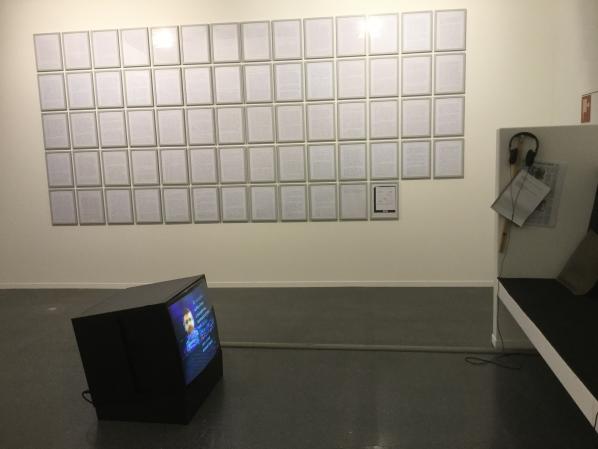
The very short introduction text to the exhibition guide is part of the puzzle we are presented with. The basic premises of the exhibition are explained in what I think is not the best possible manner, because it leaves out any mentioning or analysis of the huge political differences among the people and works presented. At the same time the use of words like higher law and self-legitimization easily creates a feeling of unease about each practitioner or type of activism in the show:
“The exhibition asks what links hacktivists, whistleblowers and (Internet) vigilantes. What is the legal understanding of these different actors? Do they share certain conceptions? Who speaks and acts for whom and in the capacity of which (higher) law? Among other issues the exhibition will examine the differing legal conceptions and strategies of self-legitimisation put forth by activists, whistleblowers, hackers, online activists and artists to justify their actions.”
By placing the revelations of Edward Snowden next to the complete print out of the manifesto of the Unabomber or (more harmless but still of a different level of impact) the battle over a hostile domain name takeover in Toywar the first impression is a levelling of the practices and people involved. To make some sort of distinction between the various represented rebellious or activist positions in the exhibition guide the whole is divided into sections. The sections however do not indicate socio-political position or relevance, but rather imply the ways people legitimize their actions (1).
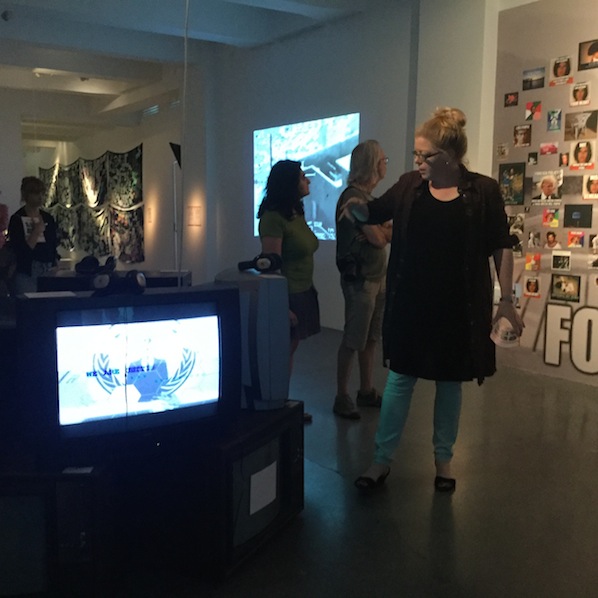
The spatial design and mapping of the exhibition seem to give some indication of political direction, but it is accidental. To the far right of the entry we find all installations labeled ‘Vigilantes’: a website collecting images of online fraudsters (419eater.com), two videos about Anders Breivik and Dominic Gagnon’s collection of mostly right-wing extremist YouTube videos. Slightly controversial is how the Vigilantes section puts together these quite obvious nut cases and criminals with Anonymous and what the curators call ‘Lulz’, the near troll-like jokesters who ridicule anything they don’t like with razor sharp memes. I am not sure whether these two products of the online forum 4chan deserve this simple pairing to YouTube hate preachers. A finer distinction between the various Internet underbelly representatives might have been better here. That this could have been done is shown by Lutz Dammbeck’s archive on the Unabomber’s placement in the Vigilante section, which has two labels. It is the sole representative of the Critique of Technology section as well. Another strange pairing happens in the Antinomism section, where an installation around a video with Julian Assange and a rightwing terrorist bomb disguised as soda machine are the only examples.
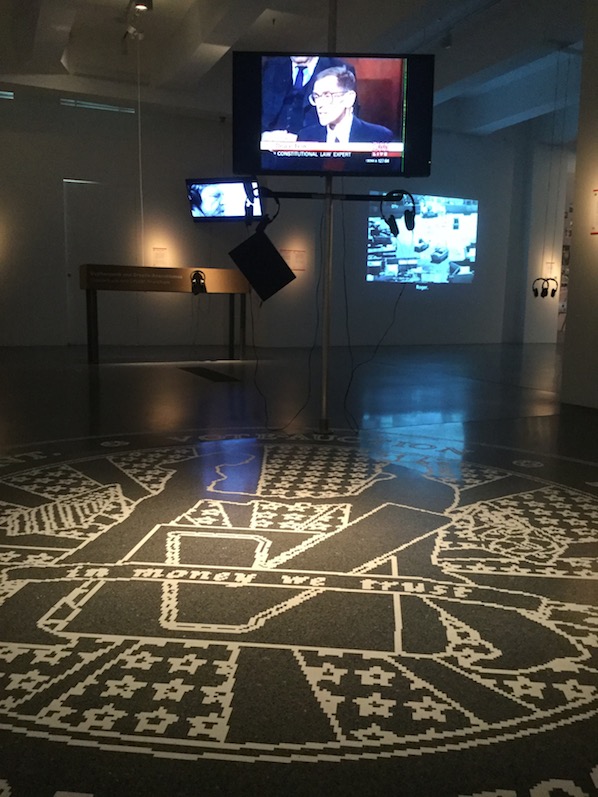
The middle ground of the exhibition shows a mix of artist activism and hacker culture. Mediengruppe Bitnik are here with a video of their Delivery for Mr. Assange. Black Transparency by Metahaven is represented through one utopian architecture model and printed wall cloths. The Peng! Collective’s Intelexit: Call-A-Spy has a telephone stand in the exhibition. The provocative sale of US votes in Vote-Auction by Ubermorgen is here as docu-installation. Etoy’s legendary Toywar is represented as well, with -in my opinion- too small a stand. Traces of many other art works and activist projects are presented in display cases, which give some more background or context to the theme. These were one of my favorite parts of the exhibition, next to the amazingly diligent and meticulous hand-drawn documentation of the Manning trial by Clark Stoeckley.
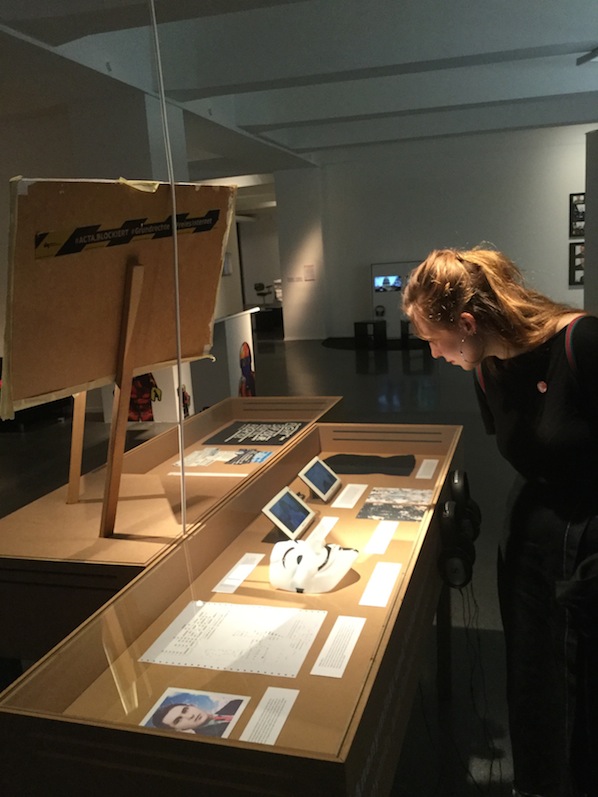
The display cases are dedicated to freedom of speech, tools of online resistance, the Netzpolitik case, anonymity and collective identities and cypherpunk and crypto-anarchism. They provide an important insight into the context within which the other practices in the exhibition exist.
Here we find Luther Blissett, the Italian born collective online identity, with a name borrowed from a former football player. The Blissett identity is related to pre-Internet art practices, in particular Neoism, and has been used for various art pranks and activist projects, particularly in Southern Europe.
Other art projects include the influential book Electronic Civil Disobedience by Critical Art Ensemble, the German hacker art collective Foebud’s battle for free speech and privacy (presented with one of Addie Wagenknecht’s anonymity glasses), and the Electronic Disturbance Theater’s Floodnet. The latter is a DDoS attack software that was used in actions for the Mexican freedom fighters the Zapatistas, by the Yes Men and for Etoy’s Toywar project.
There is also a print out of the Cypherpunk mailinglist. The cypherpunk crypto-anarchist community is responsible for some of the most influential elements of the free Internet. They produced the PGP encryption technology, cryptocurrency such as Bitcoin, TOR, the idea of WIKI and torrent platforms and marketplaces like the Silk Road. Julian Assange was one of its members.
Last but not least the presentation of the Netzpolitik.org case, which covers a German censorship scandal from last year, had to be part of this exhibition. Journalists from the online magazine Netzpolitik were arrested for treason after they had published about classified Internet surveillance plans of the German secret service. A copy of the accusation letter from the state prosecutor is oddly signed with ‘Mit freundlichen Grüßen’ (‘With kind regards’).
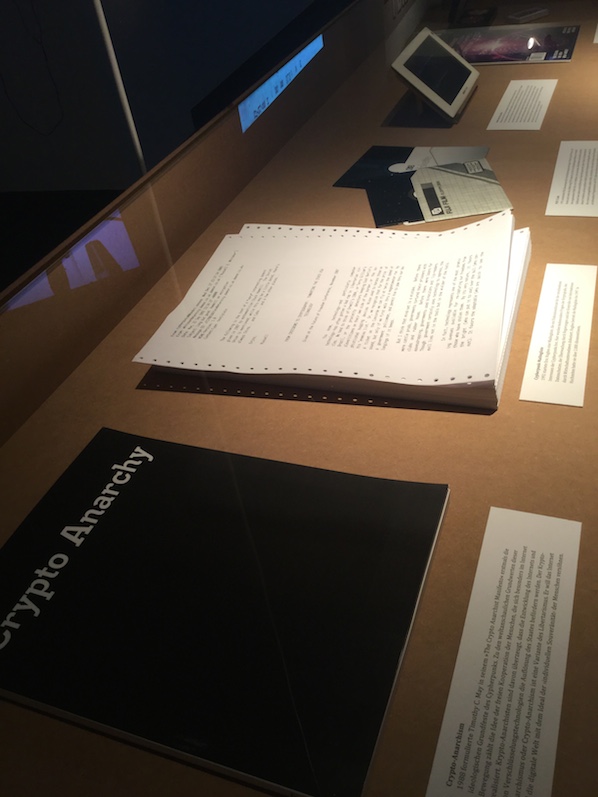
All in all the display cases made me happy to see some of the events and works that have been so hugely influential to the development of the Internet (and thus to the development of our current culture and politics) represented in a physical cultural space. They show a side of Internet culture that is heavily underrepresented in the general discourse around new media technologies in both mainstream media and art. During a private tour of Whistleblowers & Vigilantes for visitors of the simultaneously running Hito Steyerl exhibition Inke Arns explained how for her this exhibition is long overdue as well. According to Arns the threat to our freedom through abuse of new technologies should receive as much attention in art as the anthropocene. HMKV sees it as its responsibility to do something about it.
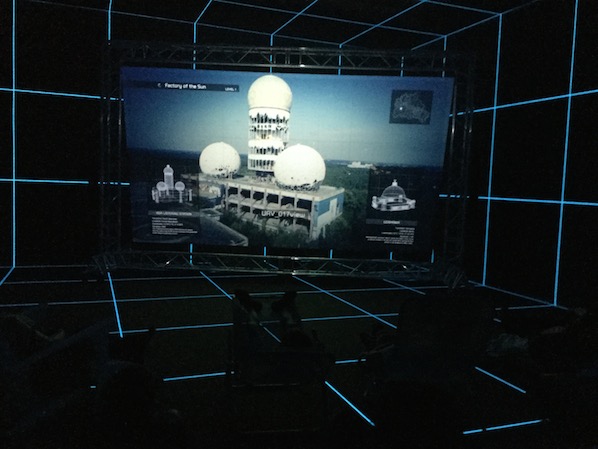
Whistleblowers & Vigilantes however does not make a straightforward statement. Its structure, both physically and content-wise, is too complex for that. This does not mean it is a bad exhibition. The bringing together of the ‘Lulz’, Anonymous, the Unabomber, net art, hacktivism, hackers and Manning, Snowden, Assange and even Breivik in one space definitely creates a lively exhibition, which cannot leave a visitor unaffected. This strange assembly then needs to be unraveled and this is where the curators take quite some risk. The addition of Hito Steyerl’s installation Factory of the Sun, an exhibition that runs simultaneously on a different floor, could help to bring the serious, crazy and light elements of the show together for that part of the audience that loses its way. In her smart playful manner Steyerl blends science fiction, humor and critique of the surveillance society in a faux holodeck cinema experience. The exhibition also includes a few live events that steer the whole into safe waters. Netzpolitik journalist Markus Beckedahl has given a presentation and so has Jens Kabisch. Kabisch wrote a text about whistleblowers that is available on the website, but this text is unfortunately only available in German. My advice to the non-German audience is to download the press kit in order to get more background information.
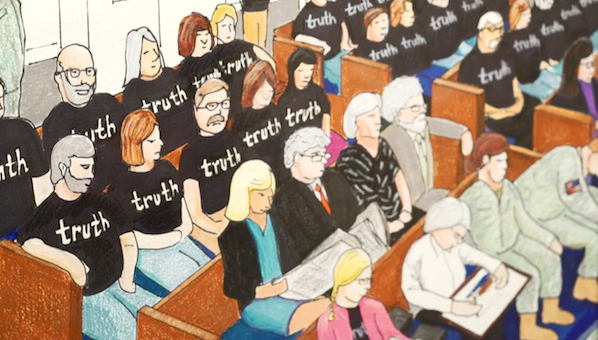
Whistleblowers & Vigilantes is a challenge to the audience. It asks for more reflection and time to take in than most exhibitions. After getting some more grip on it the complexity and scope of the exhibition, however, is impressive. It not only brings together many important, interesting and sometimes scary examples of contemporary forms of resistance and rebellion. What is also represented is the space of resistance and play that escapes attempts at systematic control, even in a full-on surveillance state. Once recovered from my initial shock this is what stayed with me the most. The wide-ranging documents, objects and installations reveal the system’s shadow spaces and vulnerabilities. Whistleblowers & Vigilanters differs from the flood of other art exhibitions themed around surveillance and control by reflecting on the legitimacy of online autonomous political action in general. Indirectly this means it also reflects upon the space of life that exists beyond all control. Rather than create another horror show around the future of privacy and freedom, with Whistleblower & Vigilanten we are presented with the persistence of fringe cultures and of free thinkers. For me this makes this an exhibition of hope.
Whistleblowers & Vigilantes. Figures of Digital Resistance
HMKV, Dortmund
9/4/16-14/8/16
https://www.hmkv.de/_en/programm/programmpunkte/2016/Ausstellungen/2016_VIGI_Vigilanten.php
https://www.hmkv.de/_pdf/Ausstellungsfuehrer/2016_VIGI_Kurzfuehrer_Web.pdf
There is a common sense in place about the fact that civil rights are undermined by a various amount of ‘exceptions’; exceptions which are based on a system, in which governmental decision-making processes are increasingly determined by the rule of money, or else the market. The idea of a constant ‘crisis’ leads to a ‘state of exception’. Regardless of established legal standards – in the name of financial, economical or security measurements – civil rights are constantly taken away. As a result, the social and legal relations between the different members of society and between nation states are increasingly out of balance. This creates an endless pool of watering down legal standards in postdemocratic societies and produces harmful sociopolitical asymmetries. The exhibition “As rights Go By” which took place in freiraum Q21 this spring 14th April – 12th of June 2016 aimed to exactly pinpoint these asymmetries and to unfold the irregularities of a ‘regular legal system’.
The 15 works in the exhibition, curated by Sabine Winkler, focused directly on the complex dynamics between the sources and consequences of disappearing civil rights under the global neoliberal umbrella. The show, which was very well set, had strong internal and external references and what really could struck somebody was the content. The exhibition could be experienced as a single piece, inviting the visitors to discover more more than just the visible tips of the il/legal iceberg and to bring these issues of discussion to schools, universities, festivals, shopping malls and the mainstream media. Of course this doesn’t mean not to exhibit – but it means not to stop there.
As Rights Go By was an exhibition which stays in mind ; the visitors could produce their own individual collages, making sense of the gravity of the problematics involved.
The works presented were the following:
Silvia Becks, who worked with the privileges in the art world, presented an installation which discussed how the special rights in place, like the information accessibilities, the funding resources and the leveling up of the societal status, are at the same time leading to a certain loss of legal rights.
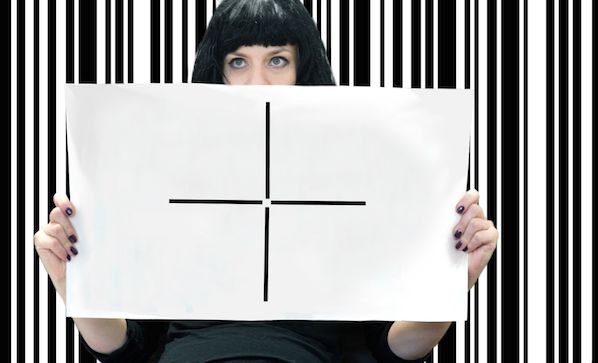
James Bridle, with his video animation “Seamless Transitions”, tried to visualize the physical spaces of the unknown arrest, the legal decision making processes and the juridical judgments involved, offering a virtual insight into the secret spaces of il/legality. His work questioned not only the surveillance strategies of physical space but also the secrecy about trading agreements and legal treaties.

George Drivas’ film‚ “Sequence Error” referred to a typical business setting where a sudden crisis has lead to a collapse. A fictional situation with a more than real deal: The crisis serves as the exception for legal rights to be erased.
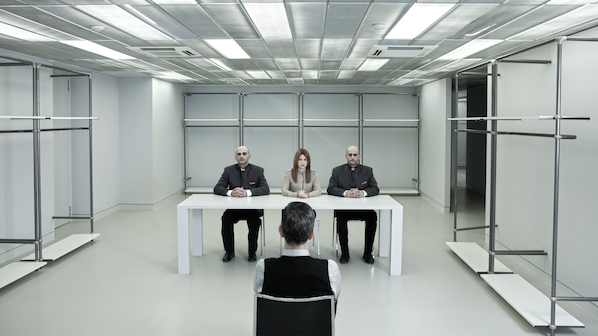
Özlem Günyol and Mustafa Kunt, overlaid the portraits of the hundred wealthiest people of the world fading into one collage of one single passport image projected to the wall. A symbol for lost identities and unidentifiable legal entities.
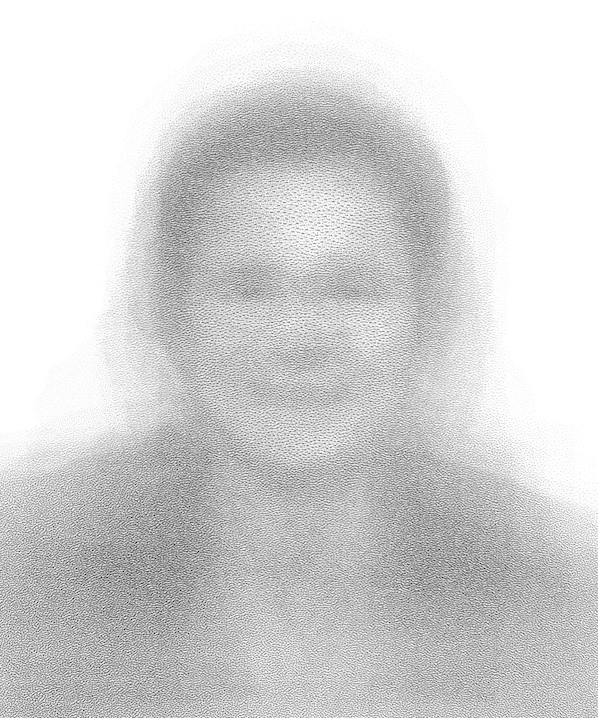
Adelita Husni-Bey video documentation gave a very detailed insight into an urban planning process in Cairo (“Land”) including gentrification processes, which go not only against Egyptian law but actually threaten a huge amount of informal dwellings. The notion ‘participations’, in particular, delivered a learning lesson about contemporary urban development strategies and their methods.
Nikita Kadan used a “Popular Medical Dictionary” of the Soviet era in his work “Procedure Room”. Painting torture methods on ceramic plates, he showed how physical and psychological violence can be justified for a ‘higher’ political order.
The Collective Migrafona reported via Comic strips about the Austrian migration politics. Imaginary Heroes are delivering identities in order fight for political rights.
Vladimir Miladinovic’s research focused on multinational companies and their strong connections to pre- and post-war power structures. His work discussed the power relations, which are in place during setting up regulations between states and their legal standards.
In his film “1014” Yuri Pattison mixed fictional Hollywood scenes with documentary footage from the hotel room where Edward Snowden gave his first interview. The work offered an insight into the conscious loss of legal rights when fiction becomes reality and vice versa.
Lorenzo Pezzani and Charles Heller raised the question about acting against human rights while being aware of the refugee tragedies based on surveillance technology. Their forensic reconstruction of a boat disaster offered a clear insight into the thin borderline between socio political responsibilities and legal settings.
Julien Prévieux work “What Shall We Do Next? 2006-2011“ showed how close technology, law and our bodies are connected; the fact that international corporations obtain patents for specific movements such as scrolling moves on a tablet shows how unaware we are about our daily il/legal routines.
Andrea Ressi related the notion of loss onto her work; loss of living space, loss of rights, loss of freedom, loss of security and represented these losses in her pictograms with modules of exception.
Judith Siegmund’s text based installations produced discomfort. Newspaper quotations about violence against refugees were set up opposite to philosophical text fragments, triggering associations about the relation between violence and competitiveness assuming that people take advantages from others who find themselves in a lawlessness situation.
Lina Theodorou’s project was one of the most intriguing works in the show. Her board game club offered a playful insight into the crisis in Greece and the social and legal consequences of austerity measurements up leading to losing well established rights. The setting would be funny if it wouldn’t be real.

Carey Youngs’ work “Obsidian Contract” transformed the visitor into an affiliate. The public space and the legal space were imagined and lost rights were reconstructed fictionally while watching the contract text through a mirror.
The exhibition did not refer directly to any political action, artivism, hacktivism or any other form of resistance but it implied the embedded hegemonic power structures pointing where it all begins.The exhibition was not a subversive act but it showed how subversion as an act of societal struggle became something illegal. Up to around 15 years ago the notion of ‘subversion’ was relatively easy to connect to counter-cultural productions. But a subversive act wasn’t nesessarily illegal – it was done in a grey shadow light between established settings in order to shake up presumably fixed sociopolitical surroundings. An unclear task under clear conditions.
In the era of global capitalist hegemony, shadows turned straight into black or white areas; no grey is involved anymore. Subversion dissolved into two parts: the legal one, which consists of what is now understood as innovation – or ‘creativity’ as the motor for an ‘idea based economy’- and the illegal one, what now labels all the ‘unwanted’ realities: terror, refugees, homeless; etc. Therefore subversive thinking and acting is no longer part of a cultural discourse but is simply illegal. Why?
The unlimited governmental practices which are today in place show that decisions are made as it happens in the financial markets; everything becomes a derivate, something to speculate with. The future has consequences on the present before anything happens. In times where potentials are seen as threats, the subversive process is turned upside down: subversions themselves become clearly defined and legal settings are turned into grey areas. A clear task under unclear conditions.
The exhibition encouraged, motivated and gave an insight into the power of rights including the absence of it. Focusing on how rights are either set or (il/legally) undermined by their exceptions and on how well these tendencies are sold as (inter)national necessities, it underlined the urge for a collective awareness of these i/legal practices and their consequences.
‘As Rights Go By’ was a very important exhibition; as mentioned above – what was visible was just the tip of the iceberg. As in many shows which include a huge amount of artistic research, a retrospective view in the future will show that this is just the beginning of a different kind of political engagement which most of all is a call for action.
Rights go by and are not falling from the sky.
Featured Image: With 69.numbers.suck by Browserbased
Athens Digital Arts Festival (ADAF) returned this year on the 19th to the 22nd of May with its 12th edition to bring Digital Pop under the microscope. Do machines like each other? Does the Queen dream of LSD infused dreams and can a meme be withdrawn from the collective memory?
Katerina Gkoutziouli, an independent curator and this year’s program director together with a team of curators proposed a radical rethinking of digital POP, placing the main focus on the actors of cultural production. From artists to users and then to machines themselves, trends and attitudes shift at high speed and the landscape of pop culture is constantly changing. What we consider POP in 2015 might be outdated in 2016, as the Festival’s program outlines, and that is true. But even so, in the land of memes, GIFs, likes, shares and followers what are the parameters that remain? ADAF’s curatorial line took it a step further and addressed not just the ephemerality of digital POP. It tackled issues related to governance and digital colonialism, but in a subtle and definitively more neon way.
450 artists presented their work in a Festival that included interactive and audiovisual installations, video art, web art, creative workshops and artist talks. Far from engaging in the narrative of crisis as a popular trend itself though, ADAF 2016 was drawn to highlighting the practices that reflect the current cultural condition. And the curated works were dead-on at showcasing those.

How are we “feeding” today’s digital markets then? Ben Grosser’s sound and video installation work “You like my like of your like of my status” screened a progressive generative text pattern of increasingly “liking” each others “likes”. Using the historic “like” activity on his own Facebook account, he created an immersive syntax that could as well be the mantra of Athens Digital Arts Festival 2016.
Days before the opening of the exhibition, Ben Grosser was asked by to choose the image that defines pop the most. No wonder, he replied with the Facebook “like” button. What Ben Grosser portrayed in his work is the poetics of the economy of corporate data collectors such as Facebook with its algorithmic representation of the “Like” button as the king pawn of its toolkit, that transform human intellect as manifested through the declaration of our personal taste and network into networking value.
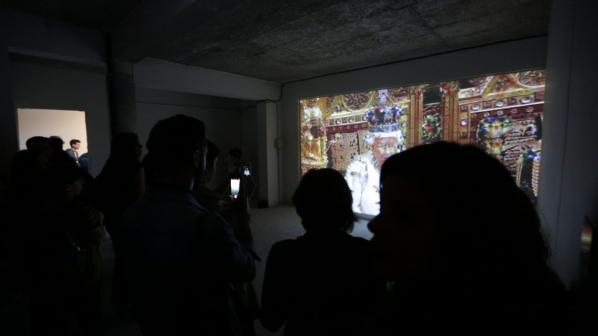
Speaking of taste, what about the aesthetics? From Instagram and Snapchat filters to ever updated galleries of emoticons available upon request, digital aesthetics are infused with social significance. In the Queen of The Dream by Przemysław Sanecki (PL) the British politics and the Royal tradition were aestheticized by the DeepDream algorithm of Google. In an attempt to relate old political regimes and established technocracies, the artist places together hand in hand the political power with the algorithmical one, pointing out that technologies are essential for ruling classes in their struggle to maintain the current power balance. The representation of the latter was placed there as a reminder that it’s dynamic is to obscure this relation, rather than illuminate it.
However, could there be some space for some creative civil disobedience? Browserbased took us for a stroll in the streets of Athens, or better to say in the public phone booths of Athens. There, the city scribbles every day its own saying, phone numbers for a quick wank, political slogans, graffiti, tags and rhymes. With 69.numbers.suck Browserbased mapped the re-appearance and cross-references of those writings, read this chaotic network of self-manifestation and reproduced it digitally in the form of nodes. Out there in the open a private network emerged, nonsensical or codified, drawn and re-drawn by everyday use, acceptance and decline.
Can virality kill a meme? Yes, there is a chance that the grumpy cat would get grumpier once realized that its image would be broadcasted, connoted and most possibly appropriated by thousands. But how far would it go? The Story of Technoviking by Matthias Fritsch (DE) was showcased at the special screenings session of the Festival. It is a documentary that follows an early successful Internet meme over 15 years from an experimental art video to a viral phenomenon that ends up in court. Once the original footage was uploaded, it remained somehow unnoticed until some years later that it was sourced, shared, mimified, render into art installation, even merchandised by users. As a cultural phenomenon with high visibility it fails to be deleted both from servers around the world and from the collective memory even though that this was a court’s decision. In his work Matthias Fritsch mashes up opinions of artists, lawyers, academics, fans and online reactions marking the conflict between the right of the protection of our personality to the fundamental right of free speech and the direction towards which society and culture will follow in the future in regard to the intellectual property.

It’s the machines alright! Back in the days of Phillip K. Dick’s novels the debate was set over distinctions between human and machine. Since then the plot has thickened and in memememe by Radamés Ajna (BR) and Thiago Hersan (BR) things were taken a step further. This installation, situated in one of the first rooms of the exhibition, of two smartphones seemingly engaged in a conversation between them through and incomprehensible language built on camera shots and screen swipes is based on the suspicion that phones are having more fun communicating than we are. Every message is a tickle, every swipe a little rub. In memememe the fetichized device was not just a mechanic prosthesis on the human body, it was an agent of cultural production. The implication that the human might not cause or end of every process run by machines was promoted to a declaration. Ajna and Hersan have built an app that allows as a glimpse into the semiotics of the machine, a language that we can see but we can’t understand.
How many GIFs fit in one hand? If one were to trace all subcultures related to pop culture, then he or she would have to stretch time. Since they are multiplying, expiring and subcategorized not by theorists but by the users themselves and with their ephemerality condemning most of which into a short lived glory. Lorna Mills (CA) explores the different streams in subcultures through animated GIFs and focuses on found material of users who perform online in front of video cameras. In her installation work Colour Fields she is obsessed on GIF culture, its brevity, compression, technical constraints and its continued existence on the Internet.
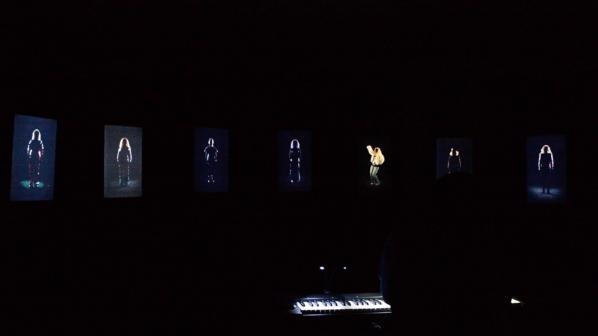
Global pop stars, a blueprint on audience development. Manja Ebert (DE) in her interactive video installation ALL EYES ON US, one of the biggest installations of the Festival, embarked on an artistic analysis of the global pop star and media phenomenon Britney Spears. Based on music videos of the entertainer that typecast Spears into different archetypical female characters, Ebert represented each and every figure by a faceless performer. All nine figures were played by a keyboard, thus allowing the users to recompose these empty cells decomposing Spears as a product into its communicational elements.
Going through the festival, more related narratives emerged. Privacy and control, the representation of the self and the body were equally addressed. People stopped in front of the Emotional Mirror by random quark (UK/GR), to let the face recognition algorithm analyze their facial expression and display their emotion in the form of tweets while they were photographing and uploading in one or more platforms the result at the same time.
Τhe Festival presented its program of audiovisual performances at six d.o.g.s. starting on May 19 with the exclusive event focus raster-noton, featuring KYOKA and Grischa Lichtenberger.
ADAF 2016 brought a lot to the table. Its biggest contribution though lies in offering a great deal of stimuli regarding the digital critical agenda to the local digital community. ADAF managed to surpass the falsely drawn conception of identifying the POP digital culture just as a fashionable mainstream. On the contrary it highlights it as a strong counterpoint.
Featured Image: Julian Rosefeldt Manifesto, 2014/2015 ©VG Bild-Kunst, Bonn 2016
Entering the darkened gallery space in the side wing of Berlin`s Hamburger Bahnhof – Museum für Gegenwart, the visitor first encounters a projection showing the close-up of a fuse cord burning in the dark. Shot out of focus its sparks are flying in slow motion, a firm clear female voice comes in beginning a monologue which includes familiar lines and passages: “I am against action; for continuous contradiction, for affirmation too, I am neither for nor against and I do not explain because I hate common sense. […] All that is solid melts into air. […] I am writing a manifesto because I have nothing to say.”. The fuse cord gradually exstinguishes without leading to an explosion.
Quoting parts of the manifesto of the Communist Party, Tristan Tzara`s Dada Manifesto as well as pieces of Philippe Soupault`s “Literature and the Rest”, the 4-minute video in its function as “Prologue” sets the tone of Julian Rosefeldt`s exhibition “Manifesto”. The opulent 13-channel installation is a homage to the textual form of the artist manifesto – in Rosefeldt´s words “a manifesto of manifestos”. Inspired by the research for his previous work “Deep Gold”, Rosefeldt began looking further into the genre and its poetics. From about sixty popular art manifestos – the earliest from 1848, the latest from 2004 – he collaged twelve new powerful and entertaining manifestos. Said manifestos serve as the source for each of the thirteen videos (a prologue and 12 scenarios) delivered and performed as monologues by Oscar-winning actress Cate Blanchett.
In every film, an extremely versatile Blanchett morphs into another role: From homeless man to broker, newsreader to punk, puppeteer or scientist. Obviously these roles do not represent the manifesto`s authors, they rather show contemporary types chosen by the artist to counterpoint or stress the ideas and attitudes of the text passages they are reciting. As a CEO at a private party, Blanchett is orating in front of an affluent audience, praising “the great art vortex”. Continuing her celebratory speech, she changes the tone to amuse her crowd quoting more passages of the Vorticist manifesto: “The past and future are the prostitutes nature has provided.”. Polite laughter, glasses are clinging. Another scene shows a bourgeois American family sitting at the dining table about to say grace. Blanchett in the role of the conservative mother is leaning her head, folding her hands but instead of the usual blessing, she begins to fervently recite Claes Oldenburg`s Pop Art Manifesto which consists of a series of propositions starting with “I am for an art …” and includes such gems as: “I am for an art that is political-erotical-mystical, that does something other than sit on its ass in a museum.” or “I am for the white art of refrigerators and their muscular openings and closings.”.

All 10-minutes-long videos in the exhibition work according to the same principle: the art manifesto collages are delivered as monologues by Blanchett at first in voice-over introducing the scene, then in filmed action and at its climax as speech to camera. Shown in parallel and installed without spatial division, the monologues interfere with one another, and the visitor is always confronted with more than one narration. While watching Blanchett in the role of a primary school teacher softly correcting her pupils quoting Jim Jarmusch: “Nothing is original. Steal from anywhere that resonates with inspiration or fuels your imagination.”, one can at the same time hear her in the role of an eccentric choreographer slamming the rehearsal of a dance ensemble with the words of Yvonne Rainer, “No to style. No to camp. No to seduction of spectator by the wiles of the performer.” From somewhere else the sound of a brass band appears, introducing the funeral scene in which Blanchett is holding a eulogy consisting of a collage of several Dada manifestos. Sounds and voices overlap and compete for attention until a point in each video when all characters in sync turn towards the camera falling into a chorus-like liturgical chant, filling the dark gallery space with a polyphony – or cacophony – of interfering monologues. It is an impressive experience, but simultaneously the installing method makes it very hard to concentrate on words and ideas expressed in the manifestos.
In general, the exhibition and each of the videos are aesthetically pleasing and entertaining to watch, which is equally due to the scenography with its amusing artifices, the strong selection of text passages as well as its its star power. Rosefeldt´s opulent, multi-layered and choreographed installation blurs the lines between narrative film and visual art. Commissioned by a unique group of partners that include the Australian Centre for the Moving Image, the Art Gallery of New South Wales, Hamburger Bahnhof and Hanover `s Sprengel Museum, “Manifesto” is in no way inferior to most cinematic productions made in Hollywood. But here´s the problem: Although Rosefeldt claims in his intro text and again in the video interview accompanying the exhibition online, that he wanted to emphasize and celebrate the literary beauty and poetry of artist manifestos, the texts are outshined by the cinematic staging of actress, setting and choreography of space. The attention of the viewer is drawn to speaker and theatrical performance, instead of focusing on the poetics and messages contained in each one of the thirteen art manifesto texts.
Another stylistic element that Rosefeldt uses attempting to highlight the manifesto texts is creating tension between text and image. Most of the settings and characters in “Manifesto” deliberately break with the performed text, which can for example be witnessed in the scene of the conservative mother reciting Oldenburg. Both were conceived by Rosefeldt to intensify the contrast between the rebellious rhetoric, idealism and radical notions of the manifesto form and the realities of today´s world. This does not work out at all times, sometimes the performances seem so exaggerated that they tip over and border on the ridiculous, the staging turns into travesty. It reinforces the impression that the exhibition is not in the first place about the texts, their content and reflective presentation, but rather aimed at the maximum achievable effect. But Rosefeldt succeeds in his intention to show how surprisingly current the demands of some of the manifestos presented are, most of them written in the 20th century. A century which was defined by historian Eric Hobsbawm as the short century and “The Age of Extremes” which saw the disastrous failures of state communism, capitalism, and nationalism. The world has more or less continued to be one of violent politics and violent political changes, and as Hobsbawm writes most certainly will continue like that.
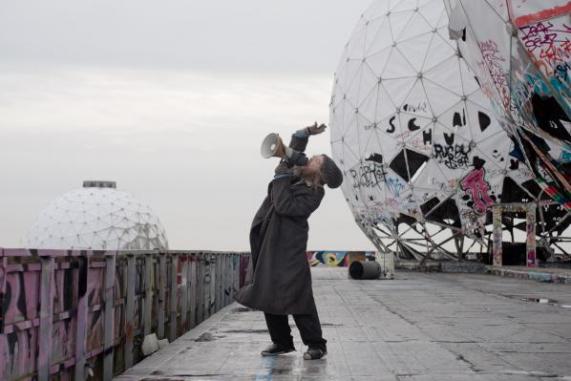
So it is no wonder that the manifesto, also serving as a signal of crisis, is experiencing a revival. With the internet as an easy means of dissemination, the manifesto form has been revisited by a great number of single artists and artist activist groups, it spread out in every niches of the art world, and was adapted by academia and beyond. So when Rosefeldt in his statements nostalgically praises texts from the “Age of Manifestos” and states that he misses this thoughts focus in today´s discourses, one cannot but wonder if he missed the current debates sparked by texts like the “#ACCELERATE MANIFESTO for an Accelerationist Politics”, “The Coming Insurrection” by the anonymous Invisible Committee, “Xenofeminism: A Politics for Alienation” authored by Laboria Cuboniks collective or texts by individual artists like Hito Steyerl which became important points of reference.
Rosefeldt´s selection of manifesto texts seems random and inconsistent with his expressed intentions: Why was the manifesto of the Communist party included in an assortment of art manifestos? Or why were Jim Jarmusch`s “Golden Rules of Filmmaking” from 2002 and Sturtevant`s ”Man is Double Man is Copy Man is Clone” from 2004 chosen in a selection concentrating on 20st century texts? Instead of concentrating on canonic art movements and a few single artists, it would been more convincing to reflect how the art field since then has been trying to re-position itself within the shifting boundaries of activism, technology and aesthetics. With a subjective selection of simply “the most fascinating, and also the most recitable” texts, “Manifesto” is caught up in an acritical nostalgia to the disadvantage of coherence and focuses rather on text as performance as on persuasive messages and reflection.
As Mary Ann Caws in her anthology “Manifesto: A Century of Isms” states, the manifesto is “a document of an ideology, crafted to convince and convert”. Naturally, there also is some discomfort with or even suspicion of the manifesto form. The obvious example being the Futurists, who in their manifesto glorified speed, machinery and war. Their text largely influenced the ideology of fascism which they supported in the run up to World War II. In the exhibition, the macho-male tone of the Futurist manifestos fittingly and amusingly is performed by Cate Blanchett in the role of a female stockbroker. Rosenfeldt met Marinetti`s dream of an engineered society showing us the violent creator and destroyer financial capitalism.
Julian Rosefeldt. Manifesto
Curated by Anna-Catharina Gebbers & Udo Kittelmann
10.02.2016 to 10.07.2016
Hamburger Bahnhof – Museum für Gegenwart – Berlin
http://www.smb.museum/en/museums-institutions/hamburger-bahnhof/exhibitions/detail/julian-rosefeldt-manifesto.html
Featured Image: Gerald Raunig, Dividuum, Semiotext (e)/ MIT Press
Gerald Raunig’s book on the concept and the genealogy of “dividuum” is a learned tour de force about what is supposed to be replacing the individual, if the latter is going to “break down” – as Raunig suggests. The dividuum is presented as a concept with roots in Epicurean and Platonic philosophy that has been most controversially disputed in medieval philosophy and achieves new relevance in our days, i.e. the era of machinic capitalism.
The word dividuum appears for the first time in a comedy by Plautus from the year 211 BC . “Dividuom facere” is Ancient Latin for making something divisible that has not been able to be divided before. This is at the core of dividuality that is presented here as a counter-concept to individuality.
Raunig introduces the notion of dividuality by presenting a section of the comedy “Rudens” by Plautus. The free citizen Daemones is faced with a problem: His slave Gripus pulls a treasure from the sea that belongs to the slave-holder Labrax and demands his share. Technically the treasure belongs to the slave-holder, and not to the slave. Yet, in terms of pragmatic reasoning there would have been no treasure if the slave hadn’t pulled it from the sea and declared it as found to his master. Daemones comes up with a solution that he calls “dividuom facere”. He assigns half of the money to Labrax, who is technically the owner, if he sets free Ampelisca, a female slave whom Gripus loves. The other half of the treasure is assigned to Gripus for buying himself out of slavery. This will allow Gripus to marry Ampelisca and it will also benefit the patriarch’s wealth. Raunig points out that Daemones transfers formerly indivisible rights and statuses – that of the finder and that of the owner – into a multiple assignment of findership and ownership.
We will later in the book see how Raunig sees this magic trick being reproduced in contemporary society, when we turn or are turned into producer/consumers, photographers/photographed, players/instruments, surveyors/surveyed under the guiding imperative of “free/ voluntary obedience [freiwilliger Gehorsam]”.
The reader need not be scared by text sections in Ancient Greek, Ancient Latin, Modern Latin or Middle High German, as Raunig provides with translations. The translator Aileen Derieg must be praised for having undertaken this difficult task once more for the English language version of the book. It can however be questioned whether issues of proper or improper translation of Greek terms into Latin in Cicero’s writings in the first century BC should be discussed in the context of this book. This seems to be a matter for an old philology publication, rather than for a Semiotext(e) issue.
It is, however, interesting to see how Raunig’s genealogy of the dividuum portraits scholastic quarrels as philosophic background for the development of the dividuum. With the trinity of God, Son of God and the Holy Spirit the Christian dogma faced a problem of explaining how a trinity and a simultaneous unity of God could be implemented in a plausible and consistent fashion. Attempts to speak of the three personae (masks) of God or to propose that father, son and spirit were just three modes (modalism) of the one god led to accusations of heresy. Gilbert de Poitiers’ “rationes” were methodological constructions that claimed at least two different approaches to reasoning: One in the realm of the godly and the other in the creaturely realm. Unity and plurality could in this way be detected in the former and the latter realm respectively without contradicting each other. Gilbert arrives at a point where he concludes that “diversity and conformity are not to be seen as mutually exclusive, but rather as mutually conditional.” Dissimilarity is a property of the individual that forms a whole in space and time. The dividual, however, is characterized by similarity, or in Gilbert de Poitiers’ words: co-formity. “Co-formity means that parts that share their form with others assemblage along the dividual line. Dividuality emerges as assemblage of co-formity to form-multiplicity. The dividual type of singularity runs through various single things according to their similar properties. … This co-formity, multi-formity constitutes the dividual parts as unum dividuum.”
In contemporary society the one that can be divided, unum dividuum, can be found in “samples, data, markets, or ‘banks’”. Developing his argument in the footsteps of Gilles Deleuze, Gerald Raunig critically analyses Quantified Self, Life-Logging, purchases from Amazon, film recommendations from Netflix, Big Data and Facebook. “Facebook needs the self-division of individual users just as intelligence agencies continue to retain individual identities. Big Data on the other hand, is less interested in individuals and just as little interested in a totalization of data, but all the more so in data sets that are freely floating and as detailed as possible, which it can individually traverse.” In the beginning “Google & Co. tailor search results individually (geographical position, language, individual search history, personal profile, etc.” The qualitative leap from individual data to dividual data happens when the ”massive transition to machinic recommendation [happens], which save the customer the trouble of engaging in a relatively undetermined search process.” With this new form of searching the target of my search request is generated by my search history and by an opaque layer of preformatted selection criteria. The formerly individual subject of the search process turns into a dividuum that is asking for data and providing data, that is replying to the subject’s own questions and becomes interrogator and responder in one. This is where Gilbert de Poitiers’ unum dividuum reappers in the disguise of contemporary techno-rationality.
Raunig succeeds in creating a bridge from ancient and medieval texts to contemporary technologies and application areas. He discusses Arjun Appadurai’s theory of the “predatory dividualism”, speculates about Lev Sergeyevich Termen’s dividual machine from the 1920s that created a player that is played by technology, and theorizes on “dividual law” as observed in Hugo Chávez’ presidency or the Ecuadorian “Constituyente” from 2007. The reviewer mentions these few selected fields of Raunig’s research to show that his book is not far from an attempt to explain the whole world seamlessly from 210 BC to now, and one can’t help feeling overwhelmed by the text.
For some readers Raunig’s manneristic style of writing might be over the top, when he calls the paragraphs of his book “ritornelli”, when he introduces a chapter in the middle of his arguments that just lists people whom he wants to thank, or when he poetically goes beyond comprehensiveness and engages with grammatical extravaganzas in sentences like this one: “[: Crossing right through space, through time, through becoming and past. Eternal queer return. An eighty-thousand or roughly 368-old being traversing multiple individuals.”
It is obvious that Gerald Raunig owes the authors of the Anti-Œdipe stylistic inspirations, theoretical background and a terminological basis, when he talks of the molecular revolutions, desiring machines, the dividuum, deterritorialization, machinic subservience and lines of flight. He manages to contextualise a concept that has historic weight and current relevance within a wide field of cultural phenomena, philosophical positions, technological innovation and political problems. A great book.
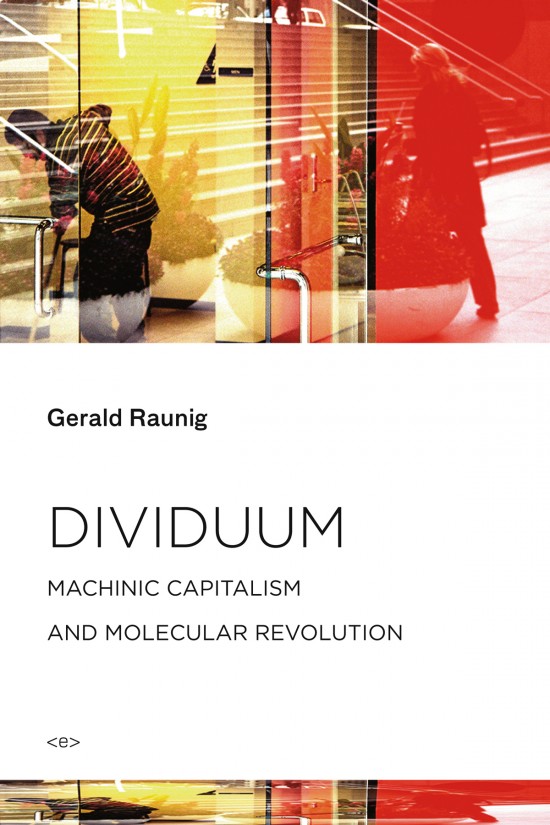
Dividuum
Machinic Capitalism and Molecular Revolution
By Gerald Raunig
Translated by Aileen Derieg
Semiotext(e) / MIT Press
https://mitpress.mit.edu/books/dividuum
Artists to my mind are the real architects of change,
and not the political legislators who implement change after the fact
(William S. Burroughs)
A large-scale model of a CCTV camera made from recycled cardboard peers through the window of the Seventeen Gallery out onto Belmont Street in Aberdeen, alive with passers by. This is the main piece of Under New Moons, We Stand Strong (2016), the project conceived and designed by Teresa Dillon to prompt reflections on solidarity, literacy and symbolism within digital civic governance.
If one gets close enough, it is evident that the eye of this camera is blind for there is no actual watching and recording apparatus inside. Still, the sensation of being watched remains. Bird spikes are mounted on top of the camera. The first thing one notices is the scale of the model: for the first time, what is an almost impalpable and invisible presence (surveillance technologies tend to be increasingly difficult to spot in the urban space) gets amplified, taking a physical presence that invites us to explore our personal relationship with surveillance and the multiple technologies that embody it.
The enlarged cardboard CCTV camera not only reminds passers-by of surveillance, its visual presence, eye to eye and the size of an other, functions to interpellate the viewer as an active gazer. Instead of us being the object of its gaze, the large-scale model allows us to look at the CCTV camera up-front. The exchange of gazes between the two subjects, the surveillance apparatus and ourselves, occurs on an equal level: we occupy a position that is not anymore subservient to the mechanical all-seeing-eye. In the act of looking at the CCTV cardboard model, we can also recognise our own complicit capacity to become overseers.
Teresa Dillon’s installation invites us to become aware of the change occurred in contemporary social and technological developments in the relationship between surveillance and society. This change is subtler than it might appear at first. The Panopticon, Bentham’s prison architecture, was discussed by Foucault in his Discipline and Punish: The Birth of the Prison (1975) as an exemplar, among others examined in the book, of the mechanisms of social control that become permanent and interiorised. The prisoners, in fact, have no need to be actually watched, they know that they might be being watched. The condition of being potentially under surveillance transforms the dynamics of the gaze, causing an interiorisation of the watchtower’s gaze, in such a way that the prisoner becomes her own overseer.
Surveillance studies have pointed out how the Foucauldian metaphor of the Panopticon fails to describe the multi-faceted contemporary figurations of surveillance. It is not anymore a matter of keeping the prisoners in a certain space, but much more of keeping them away. The movement from the Panopticon to the Banopticon, for example, exemplifies the attempt to use profiling techniques to determine who should be placed under surveillance for security purposes. The Banopticon can be described as the attempt to keep away certain social groups (asylum seekers, migrants, suspected terrorists) in the context of global security and border control. This ban, interestingly, is not exercised exclusively upon certain groups or in extraordinary circumstances, but also upon those individuals who do not have the resources (for example credit cards and smartphones) to promptly respond to the enticement of consumer spaces such as shopping malls.
We need to take responsibility for the way in which we exercise the power to look. This was the sense of the two talks arranged as part of Urban Knights, a program of events conceived to provoke and promote practical approaches to urban governance and city living by bringing together people who are actively producing alternatives to our given city infrastructures, norms and perceptions. Programmed during the opening of Under New Moons, We Stand Strong, the first talk saw Keith Spiller, a lecturer in criminology at Birmingham City University, discussing state surveillance and individual rights in the context of his practical experiences of accessing CCTV data in London. Heather Morgan, a Research Fellow at the Health Services Research Unit, University of Aberdeen, presented her on-going research on sousveillance (in the context of health self-monitoring wearable technologies). In the middle of our smart cities, caught up in the illusion of being in control of smart technologies we are actually constructing our own prison.
Dillon’s interventions successfully unfold what the two talks left implicit at theoretical level, that is the passage from Foucauldian surveillance to “surveillant assemblage”. Deleuze’s and Guattari’s concept of surveillant assemblage makes visible processes in which information is first abstracted from human bodies in data flows and then reassembled as “data doubles” (Deleuze and Guattari 1987). Thus, a new type of body is formed, whose flesh is pure information transcending corporeality. The body is an assemblage, comprised of component parts and processes that need to be observed. Moving away from a hierarchical top-down gaze, in a rhizomatic-fashion, surveillance expands in multiple fractured forms.
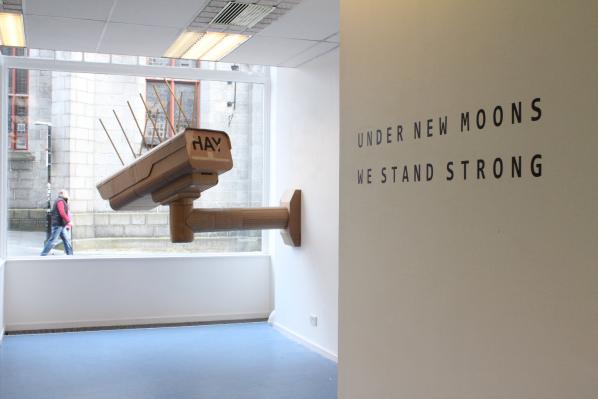
Going back to Dillon’s installation, on the gallery wall there is a digital print portraying a snowy owl in mid-air flight. This is a special edition print related to an episode on January 3rd, 2016 in Quebec, where a CCTV camera captured a stunning image of a snowy owl in mid-air flight. Four days later the images were tweeted by Quebec’s Transport Minister and went viral, turning the snowy owl into an “Internet star”. In Greek mythology the owl represents or accompanies Athena, the goddess of wisdom – and military strategy. Curiously, the next generation of surveillance technologies developed by the United States military bears the names of Greek mythological creatures. Argus Panoptes, which recalls the all-seeing giant monster with a hundred eyes, is a monitoring system that allows the constant surveillance of a city. Gorgon Stare, an array of nine cameras attached to an aerial drone, takes the name of the monstrous feminine creature whose appearance would turn anyone who laid eyes upon it to stone.
The owl is a highly metaphorical and yet ambiguous presence in the exhibition. On the one hand, the owl symbolises knowledge, wisdom and perspicacity. With its appearance, “flying only with the falling of the dusk” to paraphrase and transpose the famous passage from Hegel where the owl incarnates the appearance of philosophical critique and appraisal, the owl of Minerva (the Roman goddess identified with Athena) makes explicit the ideas and beliefs that drove an era but could not be fully articulated until it was over. Therefore, the owl is revealing something to us about our own epoch – it is our task to decipher the content of the message.
On the other hand, the owl is also the physical medium through which collaborative interspecies strategies of resistant actions to surveillance can be organised. Dillon’s techno-civic intervention, as the artist herself calls her work, is ideally connected to another artistic project, Pigeonblog, made by Beatriz da Costa, artist, academic and activist, member of the Critical Art Ensemble and graduate student of philosopher and science and technology scholar Donna Haraway. Pigeonblog was a grassroots initiative designed to collect and spread information about air quality to the public. Pigeons were equipped with small air pollution sensing devices capable of gathering data on pollution levels. The data could be then visualised and accessed by means of Internet (da Costa and Kavita 2008). Da Costa’s Pigeonblog was inspired by a photograph depicting a technology developed in Germany during wartime but then never implemented: a small camera, carried by a pigeon and set on a timer, was designed to take pictures at regular intervals of time as pigeons flew over specific regions of interest – possibly military targets. Pigeons were participating agents in this early surveillance technology system. Da Costa resuscitated that idea to create a surveillant assemblage formed by a living animal and technology but with civilian and activist goals.
By means of this mythological creature, the owl, Teresa Dillon asks us to learn to look at those technologies of surveillance, to re-adjust our gaze in order to be ready to face them upfront. The role played by mythology is evident not only in the installation but in the procession that accompanied the exhibition on Saturday May 7th. The public were invited to gather together and take part in a “forensic anthropological walk”, as the artist labelled it, throughout the city of Aberdeen, with participants holding hand-held models of two-dimensional CCTV cameras. Stopping in front of the CCTV cameras encountered in Castle Square during the walk, the artist revisited the world history of CCTVs, starting from the first documented use of surveillance cameras in Germany in 1942 for the documentation of Test Stand VII, the V-2 rocket testing facility, through the introduction of CCTVs in the urban landscape in the US in 1968, and more recent examples of surveillance technologies in the UK.
Dillon blends story-telling techniques with an emotional urban cartography created by means of walking together. Namely, the walk cannot be described in the guise of a city tour: the performative element transformed the walk into a procession, a collective rite, consumed on the Aberdeen beach where the paper cameras were set alight by participants. The history of surveillance technologies is in fact interwoven with mythological, symbolic and ritual elements, from the owl to the closing ceremony on the beach. Like in Cities of the Red Night, written by Beat Generation novelist William S. Burroughs, Dillon’s multiple interventions combines history with rituals and performance to evoke magical elements, doomsday scenarios and our phobias about the powers that control and enslave us.
The different interventions conceived and designed by the artist (the artwork itself, the performance, the walking tour through the city, the talks that accompanied the opening of the exhibition) can be read as artistic enactments of the cut-up and fold-in literary technique used to re-arrange and combine the pieces of a text to form new narratives. The technique can be traced back to the Dadaists of the 1920s. It was then popularised by Burroughs in the 1960s as a radical and creative method of socio-political subversion. It is evident that the cut-up and fold-in technique can be applied to contexts other than literature as Dillon demonstrates. It helps overcoming conventional associations (in this case, surveillance as a merely technological apparatus) to create new ones (the literacy infrastructure of surveillance), transforming the reader/player/visitor from a passive consumer of other people’s ideas into the architect of her own knowledge and action.
Under New Moons, We Stand Strong allows citizens to become not only more aware of the technological power infrastructure at work in our cities but also to learn how to read it, confront it, possibly resist it. The beach, at the outskirt of the urban space, a liminal site, nowadays often associated with the refugees crisis, becomes a space of freedom and catharsis. To set the cardboard cameras alight is, simultaneously, an act imbued with mythology – Prometheus’ gift of fire, the first techne, to humankind for their survival – and a collective gesture of transformation and renewal. Having freed ourselves from the idols, from all-seeing eyes, we can stay up-front, together, as a community, to face the darkness of our time.
Seventeen, Art Centre, 17 Belmont St, AB10 1JR, Aberdeen
Supported by Scotland’s Festival of Architecture, Peacock Arts Centre & Aberdeen City Council
Date: Thurs 5 – Sat 28 May 2016
Location: Seventeen, 17 Belmont St, AB10 1JR, Aberdeen
Opening: Thurs, 5 May, 6pm with special edition of Urban Knights
Procession: Sat 7 May, 8pm from Seventeen, 17 Belmont St, AB10 1JR, Aberdeen
Credits
Model & assistance: Jana Barthel
Commissioned by: Festival of Architecture, Scotland, 2016; Peacock
Visual Arts, Aberdeen & Seventeen Gallery, Aberdeen
In the introduction of Civic Radar, editor Peter Weibel sets out the motivation, layout and journey of the book. This first comprehensive monograph of Lynn Hershman Leeson’s artistic career, spanning across five decades. It must have been a dizzying publication to work on, when compiling her pioneering work in the fields of photography, video, film, performance, installation, and interactive and net-based media art. It is noteworthy that Hershman Leeson collaborated in its production. One feels her personal involvement in the book – its richness, care and detail, shows in its nearly 400 pages, and approximately 500 illustrations. It also features supporting texts by other writers, curators, theorists, and artists, such as: Andreas Beitin, Pamela Lee, Peggy Phelan, Ruby Rich, Jeffrey Schnapp, Kyle Stephan, Kristine Stiles, Tilda Swinton, Peter Weibel and interview by Hou Hanru and Laura Poitras with the artist.
“I try to live in the present, because most people live in the past. If you live in the present, most people think you live in the future, because they don’t know what happens in their own time.” Lynn Hershman Leeson.
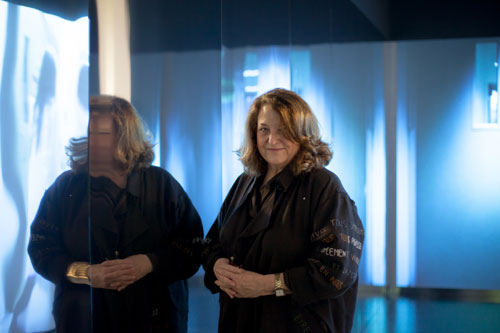
Lynn Hershman Leeson has pioneered uses of new technologies, recognized as key to the workings of our society today. She tackles the big questions surrounding: identity in a time of mass, overpowering consumerism; privacy in an era of surveillance; the interfacing of humans and machines; the relationship between real and virtual worlds; and new bio-ethics surrounding practices such as growing parts of the human body from DNA samples. We can think of Hershman Leeson as a direct artistic descendant of Mary Shelley. Consider Shelley’s celebrated publication, Frankenstein: Prometheus Unbound, published in 1818, and its challenges towards macho revolutionaries of ‘reason’, and her critique of the misuses of science and technology by the patriarch. We can see strong parallels between both women. They are feminists, who have managed to find ways around (and to work with) traditional forms of dominant, patriarchal frameworks, so to express personal, creative and cultural identities, on their own terms.
“Lynn Hershman Leeson’s mission statement seems to be that the body is a programmable software embedded in a changeable hardware. Therefore, she shows us so many hybrids and mutants, aliens and agents, actors and avatars, in real life and second life. From Dolls to clones, she demonstrates the paradox plurality of identities especially in the age of total observation.” [1] (Weibel 2016)
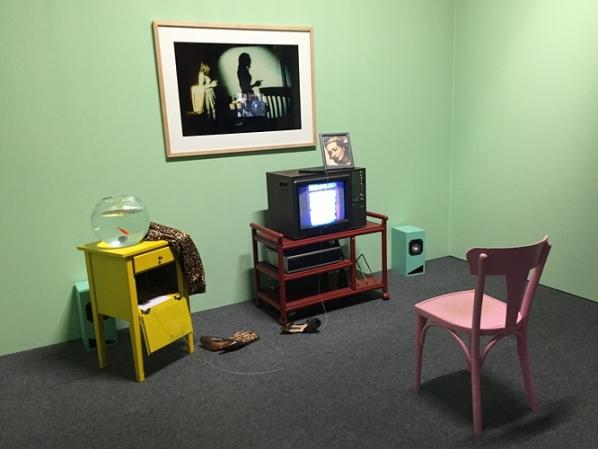
Hershman Leeson’s artistic process however does not keep its distance from the processes of science and technology. She leaps into the depths of our fears and unreservedly engulfs herself, and her imagination in their material influences and modifications. Like Donna Haraway, Hershman Leeson takes cyborgs, misfits, biology, mutation and transformation as her inspiration, contexts and materials. And also like Haraway, she playfully and critically owns concerns around science and technology, along with the ethical issues that may arise out of their continuously shifting, influences on society; and, thus not owned by or weighed down by them. Every work put forward by Hershman Leeson, is an experiment. Her interests and knowledge inspired by science and technology reflects her constant state of contemporariness. Her work directly correlates to breaking down systems of perceived values.
“Hershman Leeson confronted conventional gender roles and exposed the normative construction of gender identity. Some of her videos have included cross-dressers and transgender men and women, as in Double Cross Click Click (1995), and her assumed male pseudonyms at a time when the art world was dominated by men who mostly ignored women.” [2] (Beitin 2016)
Hershman Leeson’s art moves fluidly between different formats, contexts and disciplines. This of course is not easy to brand. The art market survives by promoting art that fits into particular roles and products that are easy to promote, predict and consume. The irony here is that the art world promotes the idea of itself as a site of novelty and insights, but in reality represents a deeply conservative culture. Some artists, Hershman Leeson is one of them, transcend the contemporary artworld norm and build alternative universes, contexts and identities, where the art is so investigatory and esoteric, traditional conventions are challenged.
When I interviewed Hershman Leeson last year for Furtherfield she talked about how she’d like to “eradicate censorship, and make more transparent the capitalistic underpinnings that are polluting access, value and visibility”. In the 70’s, she was the first artist working on a prison art project in San Quentin, and many of her early public art works “geared toward social change.” [3]
Civic Radar shows us that her work is not reduced to a singular, reflection of her own creative self. There is a wider story and it includes the voices of many others as part of the narrative of her life and her work, as well as reclaiming a history in a male dominated society.
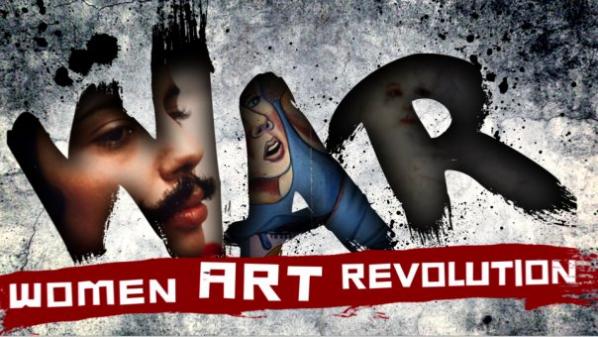
We see reaffirmed a varied and dynamic history where she has been involved in strengthening the role of women in society, as part of an extension of her art process. One excellent example of this rich history is that over a period of 40 years she interviewed an extensive array of women artists, historians, activists, and critics who integrated personal and political content into their work. Then, some of that gathered material was made into a film project !Women Art Revolution, in 2010.
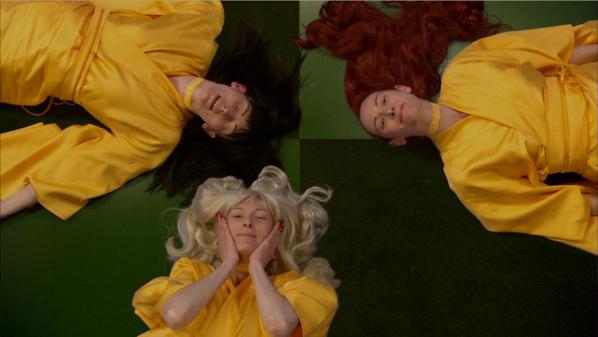
Lynn Hershman Leeson has not only achieved pioneering work as an artist, but also as filmmaker. She has collaborated with actor and Oscar winner Tilda Swinton in several feature films that have gone on to receive numerous awards at international film festivals on account of their outstanding quality and innovative themes. »Teknolust« is an absurd, amusing and scientifically highly topical science-fiction drama on the subjects of cyber-identities, biogenetics, gender constructions and sexual self-determination in the age of the Internet. The plot turns on the scientist Rosetta Stone (Tilda Swinton), who illegally produces three clones of herself. The artificial entities can only be distinguished by the color of their clothing and live in an enclosed cyberspace. Because they are dependent for survival on the male Y chromosome, Ruby, the femme fatale among the clones, goes in regular pursuit of men. Sexual contact with Ruby leads to impotence in her lovers as well as to an allergic reaction triggered by a computer virus which is transferable to human beings. The FBI becomes aware of the clone family’s machinations following the increased incidents of infection among men, and begins to investigate. Note*
Her work has crossed into many different fields and formats. Which includes: installations, videos, films, sculptures, robots, avatars, contracts, computer programs, photography, paintings, drawings, collages, browser based art, artificial intelligence, bio-matter, network communication systems and devices. Synthia Stock Ticker and Dollie Clones are just two examples that demonstrate how ahead she has been with her ideas and her integration of digital technologies into art. Synthia Stock Ticker, is a networked-based media artwork made in 2000. It refers to the stock ticker invented by Thomas Edison and is unusually prescient in its portrayal of the emotional life of global markets. Inside a glass casing sits a small monitor screen, showing a video of a woman character named Synthia. “When the market is up, the character dances and shops at Christian Dior: when the market is down, she chain smokes, has nightmares, and shops at Goodwill.” [4]

Again The Dollie Clones 1995-96 predate a contemporary artistic obsession with creeping surveillance. Two telerobotic dolls, Tillie the Telerobotic Doll and CyberRoberta, whose eyes have been replaced with cameras. Each doll has a website that allows users to view the images taken by the webcams and click on an “eyecon” to telerobotically turn the doll’s head 180 degrees to survey the gallery.

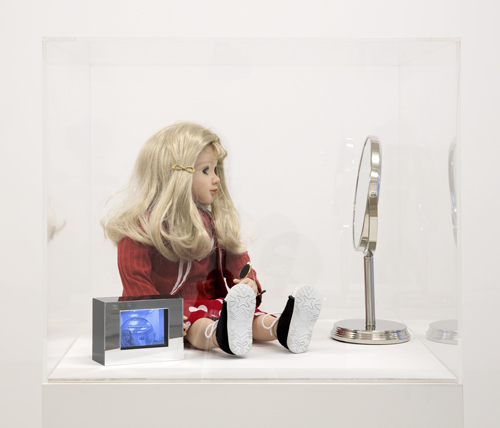
Hershman Leeson’s most prominent performance work was as another woman, Roberta Breitmore. This elaborate alter ego existed between 1973 and 1978. The Breitmore character was well developed, possessing different behaviors and attitudes to Hershman Leeson’s own personal identity. Roberta Breitmore had her own handwriting, clothing, wig, makeup, driver’s license, apartment, psychologist, bank account, credit cards, acquaintances, life story, and adventures. Hershman Leeson took the audacious leap and sporadically became Roberta Breitmore for 5 years. Other women also lived as Roberta Breitmore and sometimes simultaneously. [5]
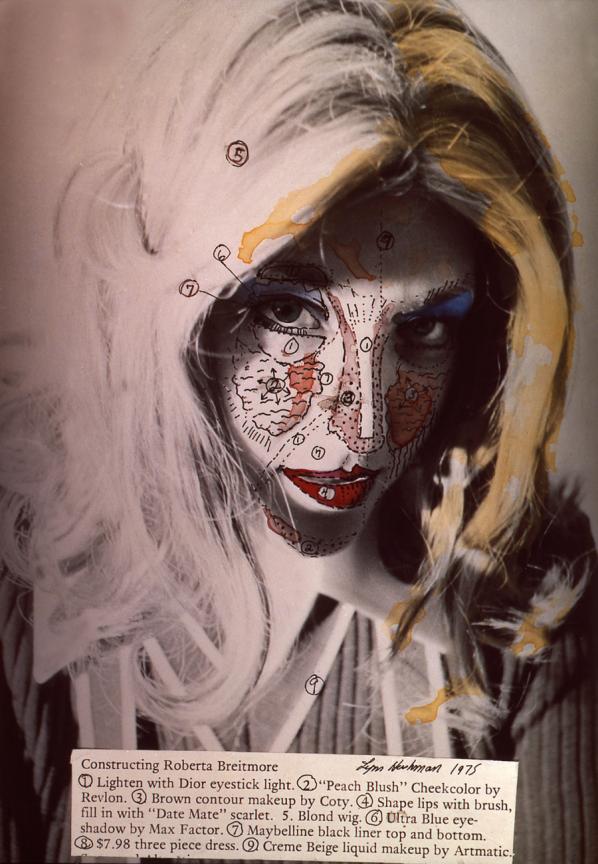
“Hershman Leeson hired three additional performers, all women, to play Roberta. They wore costumes identical to the ones Hershman Leeson herself wore, and they treated Roberta essentially as a professional (albeit part-time) gig. They undertook some of Roberta Breitmore’s correspondence and went on some of her dates (which were documented in photos and audio recordings). Eventually, Hershman Leeson stopped enacting Breitmore, reducing the instantiations of Roberta Breitmore from 4 to 3.” [6] (LaFarge 2007)
The spirit of Hershman Leeson’s radical art persona can be seen in younger, contemporary artists today. For instance, Heath Bunting’s Identity Kits, part of his larger The Status Project consist of various items, personal business cards, library cards, a national railcard, T-Mobile top-up card, national lottery card and much more. “They take a few months to compile each of them because they are actual items that everybody uses in their everyday lives, involving evidence of identity. There is also a charge for the package of 500.00 GBP, which is cheap for a new identity.” [7] (Garrett 2014) Then we have Karen Blissett, an Internet artist who suddenly decided to go multiple by opening up all of her email, Twitter, Facebook and Google accounts to many different women around the world. “A torrent of provocative, poetic, and often contradictory voices issued proclamations, made auto portraits, and shared psalm-like meditations on her existential transformation; distributed across online platforms and social spaces, in text, image and video.” [8] (Catlow 2014)
Towards the end of Civic Radar a collection of pages show us various images of the exhibition by the same name at the ZKM Museum of Contemporary Art, in Germany 2014. When viewing the images of her work in the large gallery spaces you realize the scale of it all, and how substantial her work is.
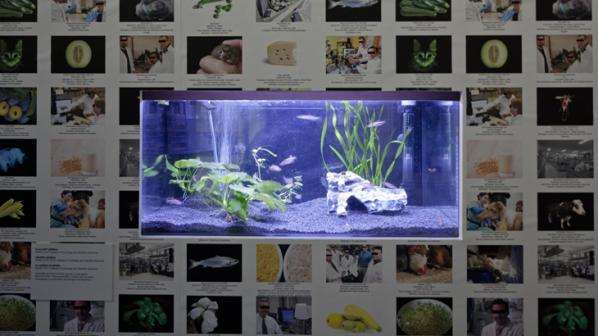
Moving on after the images of the works in ZKM, there is a selection of Hershman Leeson’s texts written, from 1984 and 2014. These writings, take us through different stages of her career, revealing ideas and intentions behind much of her work and also some of the work included in the publication. In the last paragraph of the last text in a short essay, titled The Terror of Immortality she writes about the contexts that have given rise to her most recent work. “As organic printing and DNA manipulation reshapes the identities of newly manipulated organisms, so too the culture of absorbed surveillance has dynamically shifted. In the next 100 years, the materials used to create DNA will become increasingly distributed and hybridized. The implications of this research include not only the creation of a sustainable planet of hybrid life forms that can survive a sixth extinction and incorporate into to its existence a morally responsible future.” (Leeson 2016)
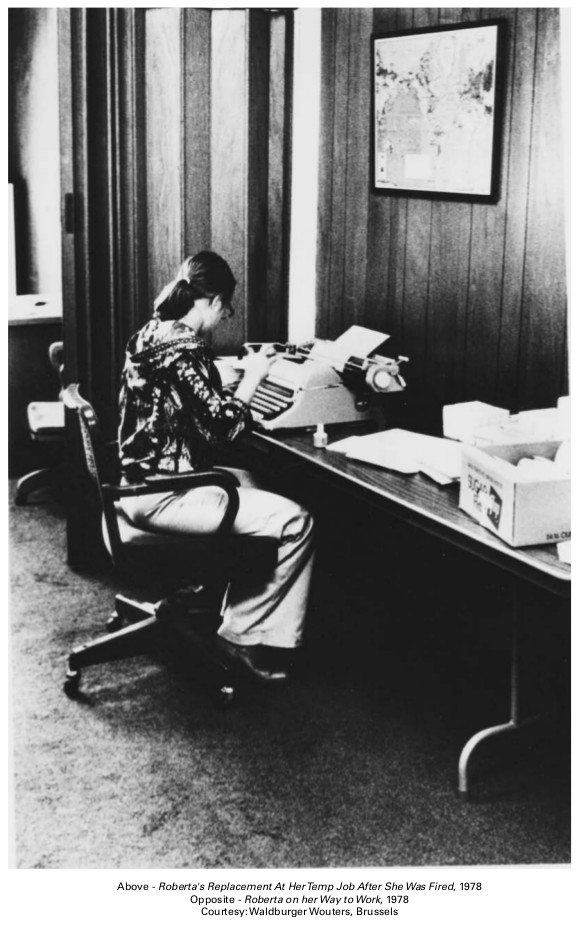
This book is a profound read, offering an insight to this generous and profound artists’ fantastical journey in an era marked by accelerating change. And what’s so amazing is that the content, the narratives, and the histories, are real. It is an Aladdin’s Cave of rich, exceptional artworks, flowing with brilliant ideas. Hershman Leeson has had her finger right on the pulse of what’s relevant in the world for a long time, and transmuted the knowledge she unearths in her examination of identity, feminism, science, technology and more into her own artistic language.
Her work is way ahead of most contemporary artists showing now. This book should be read everywhere. Not just because it features great art, but also because features a woman with a great mind. I am not a fan of the words genius or masterpiece; I find them tiresome terms reflecting a form of male domination over women and the non-privileged classes. Yet, after spending time with Civic Radar, I cannot help myself thinking that I have just witnessed something equivalent without the negative baggage attached.
*Text from ZKM – Teknolust. With Lynn Hershman Leeson at the cinema.
http://zkm.de/en/event/2015/03/teknolust-with-lynn-hershman-leeson-at-the-cinema
In 2015, ZKM in cooperation with the Deichtorhallen Hamburg / Sammlung Falckenberg exhibited the first comprehensive retrospective of Leeson’s work, including her most recent productions of art. Last year Modern Art Oxford hosted a major solo exhibition of her work Origins of a Species, Part 2 and she also has work in The Electronic Superhighway, at Whitechapel Gallery, in London.
What does the comic book heroine Wonder Woman have to do with the lie detector? How is the Situationists’ dérive connected to Google Map’s realtime recordings of our patterns of movement? Do we live in Borges’ story “On Exactitude in Science” where the art of cartography became so perfect that the maps of the land are as big as the land itself? These are the topics of the Nervous Systems exhibition. Questions that are pertinent to the state of the world we are in at this moment.
The motto “Quantified life and the social question” sets the frame. Science started out as a the quantification of the world outside of us, but from the 19th century onwards moved towards observing and quantifying human behaviour. What are the consequences of our daily life being more and more controlled by algorithms? How does it change our behaviour if we are caught up in a feedback loop about what we are doing and how it relates to what others are doing? Does this contributed to more pressure towards a normalized behaviour?
These are just some of the questions that come to mind wandering around the densely packed space. You have to bring enough time when you visit “Nervous systems” – it is easy to spend the whole day watching the video works and reading the text panels.
There are three distinct parts: the Grid, Triangulation and the White Room. Each treats these questions from a different perspective. The Grid is the art part of the show and features younger artists like Melanie Gilligan with her video series “The Commons Sense” where she imagines a world where people can directly experience other people’s feelings. In the beginning this “patch” allows people to grow closer together, increasing empathy and togetherness, but soon it becomes just another tool for surveillance and optimizing of work flows in the capitalist economy – an uncanny metaphor of the internet.

The Swiss art collective !Mediengruppe Bitnik rebuilt Julian Assange’s room in the Ecuadorian Embassy – including a treadmill, a Whiskey bottle, Science Fiction novels, mobile phone collection and server infrastructure – all in a few square metres. The installation illustrates the truism that history is made by real people who eat and drink and have bodies that are existing outside of their role they are known for. Which is exactly why Assange is confined since 2012 without being convicted by a regular court.
The NSA surveillance scandal does not play a major part in the exhibition as the curators – Stephanie Hankey and Marek Tuszynski from the Tactical Technology Collective and Anselm Franke, head of the HKW’s Department for Visual Arts and Film – rather concentrate on the evolution of methods of quantification. For this reason we are not only seeing younger artists who directly deal with data and its implications but go back to conceptual art and performance in the 1970s and earlier.
The performance artist Vito Acconci is shown with his work “Theme Song” from 1973 and evokes the Instagram and Snapchat culture of today by building intimate space where he pretends to secrets with the audience. Today he could be one of the Youtube ASMR stars whispering nonsense in order to trigger a unproven neural reaction.
Harun Farocki’s film “How to live in the FRG” on the other hand shows how society already then used strategies of optimization in order to train the human material for the capitalist risk society.
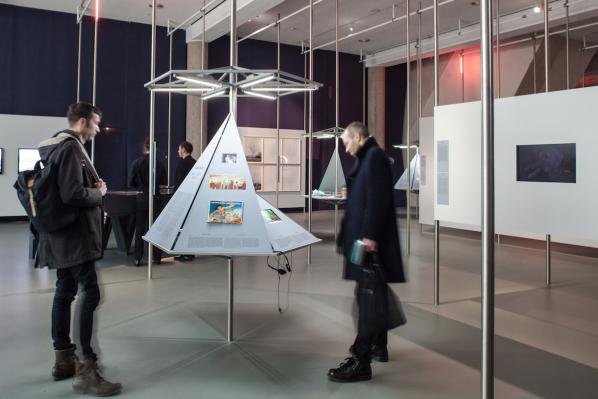
Triangulation is the method to determine the location of a point in space by measuring the angles from two other points instead of directly measuring the distance. As a method it goes back to antiquity. In the exhibition the Triangulation stations give a theoretical and cultural background to the notion of a quantified understanding of the world. Here the exhibition give a rich historical background mixing stories about the UK mass observation project where volunteers made detailed notes about the dancing hall etiquette with analyses of mapping histories and work optimization.
The triangulations in the exhibiton are written by eminent scholars, activists and philosophers. The legal researcher Laurence Liang writes about the re-emerging forensic techniques like polygraphs and brain mappings that have their roots in the positivism of the nineteenth century. Other triangulations are about Smart Design (Orit Halpern), algorithms, patterns and anomalies (Matteo Pasquinelli) and quantification and the social question where Avery F. Gordon together with curator Anselm Franke speaks about the connection of governance, industrial capitalism and quantification.
“Today’s agitated state apparatuses and overreaching institutions act according to the fantasy that given sufficient information, threats, disasters, and disruptions can be predicted and controlled; economies can be managed; and profit margins can be elevated,” the curators say in their statement. We see this believe everywhere – the state, the financial sector, in the drive towards self-optimization. A lot of the underlying assumptions can be traced back to the 19th century – the believe that if we have enough information we can control everything.
Like Pierre Laplace and his demon we believe that if we know more we can determine more. The problem is that knowing is only possible through a specific lens and context so that we become caught up in a feedback loop that only confirms what we already know to begin of. Most notably this can be seen in the concept of predictive policing which is also present in the triangulation part of the exhibition. Algorithms only catch patterns that are pre-determined by the people who program them.
Going through The Grid of the art works (the exhibition architecture by Kris Kimpe masterfully manifests a rectangular gridlike structure in the exhibition space) and reading the Triangulation stations the visitor is left a bit bereft. Is there still hope? One feels like at the end of George Orwell’s 1984 – the main character is broken and Big Brother’s reign unchallenged. This is where the White Room comes in. Here the visitors can be active. The Tactical Technology Collective provides a workshop programme where one can learn about how to secure one’s digital devices, how to avoid being tracked – on the web or by smartphone, what the alternatives are to corporate data collectors like Facebook or Google.
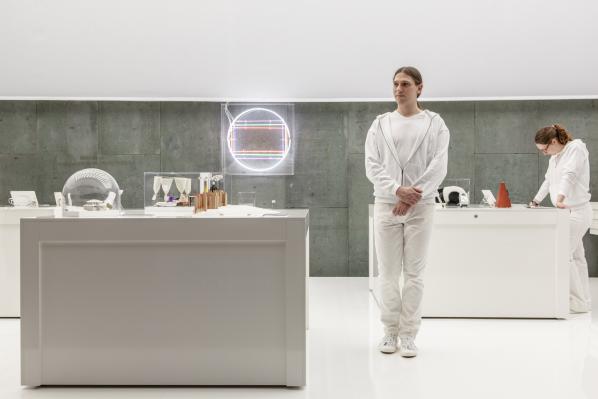
In the end the nature of internet is twofold and conflicting: on the one hand it allows for unprecedented observation and monitoring, on the other it is a tool for resistance connecting people who were separated by space and time. It is not yet clear if this is enough or if (like the radio and other technological media before) it will be co-opted by the one’s in power.
This leads me to one problem of an otherwise very necessary and inspiring show: For all its social justice impetus that narrative that is presented here is very androcentric – there are few if any feminist, queer or post-colonial perspectives in the exhibition. If they are presented then from the outside. This is not a theoretical objection as women, people of colour and other minorities (who are actually majorities) are especially vulnerable to the kind of hegemonic enclosures on the basis of data and algorithms. In a talk in the supporting programme the feminist philosopher Ewa Majewska gave some pointers towards a feminist critique of quantification: the policing of women’s reproductive abilities, affective labour or privacy as a political tool. More of this in the exhibition itself would have gone a long way.
The exhibition is accompanied by an interesting and ambitious lecture programme. The finissage day, May 8, is bound to be especially interesting. Franco Berardi, Laboria Cuboniks, Evgeny Morozov, Ana Teixeira Pinto and Seb Franklin are invited to think further about digitial life, autonomy, governance and algorithms.
Nervous Systems. Quantified Life and the Social Question
March 11 – May 9, 2016
Haus der Kulturen der Welt Berlin
Opening hours and information about the lecture programme on the website.
Featured Image: Smoke Signals at the International Anthony Burgess Foundation, Manchester
Red floodlights illuminate the silhouette of a grand piano standing in the centre of a darkened room. As musician and composer Jonathan Hering begins to strike the keys of the late Anthony Burgess’ piano, a hidden bank of machines cough a sequence of smoke rings into the air, which catch in the red light above. The room fills with a ghostly red mist, all but obscuring the source of the beautiful music. The irregular pattern of smoke puffs suggest it’s some sort of message or code. In fact, it’s a sequence based on email data from seven arts organisations, put through a Polybius cipher.
Smoke Signals places digital communication in context, as simply the latest in a line of our approaches to long-distance forms of communication,” explains co-creator Ed Carter. “I was very interested in the way that as the smoke, or ‘data’, filled the room it became more and more dense. At the beginning, you can decipher it if you understood the code, but eventually it becomes more of a fog – which is a nice analogy for the way data works on a big scale.”
This performance of Smoke Signals at Manchester’s International Anthony Burgess Foundation captures much of what FutureEverything festival is all about: looking simultaneously backward and forward through technology, fusing the analogue and the digital, the theoretical and the artistic, and uniting practitioners across disciplines.
FutureEverything is an innovation lab for digital culture and an annual ideas festival exploring the space where technology, society and culture collide. Featuring thought-provoking panel discussions, original commissions and parties, this year it took place in arts venues across the city, from Wednesday 30th March to Saturday 2nd April.
This summary explores how the festival encourages multi-disciplinary collaboration between different creative communities through interviews with artists who embody this collaborative ethos in a variety of different ways. How do they bridge the divides between disciplines to break new ground and meet the challenges of the future?
Commissioned for FutureEverything, artist Ed Carter created Smoke Signals with engineer and technologist David Cranmer. Musicians Sara Lowes and Jo Dudderidge & Harry Fausing Smith and Hering, then devised original compositions in response to the piece, taking each performance in a new direction. “Working with a collaborator or collaborators is like working with a process or working with a data set,” Ed says. “You create a framework but leave a degree of openness which allows for the unexpected.”
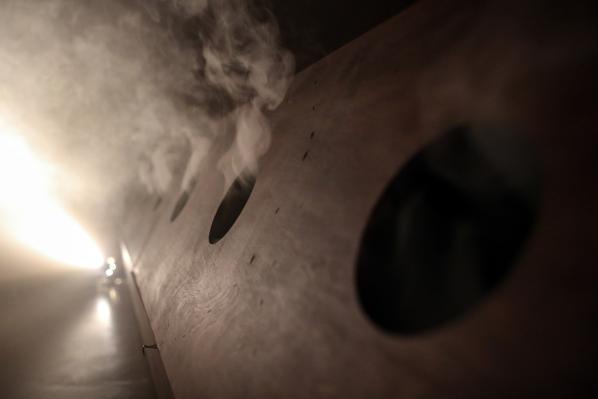
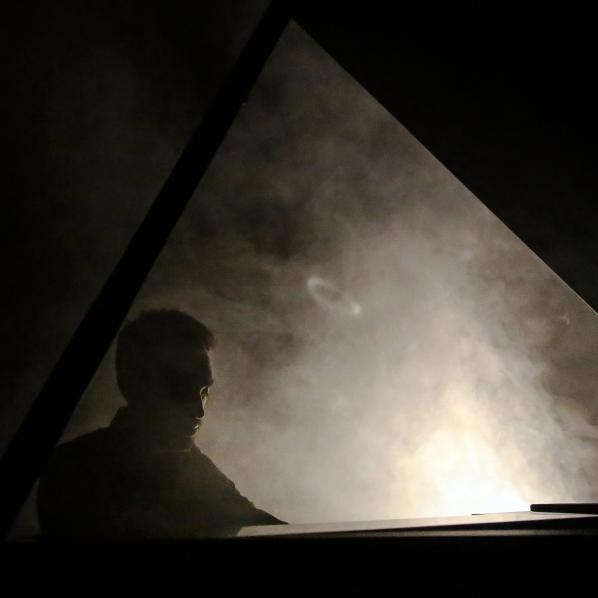
Newcastle’s Occasion Collective chose to deconstruct the collaboration process behind their Babble series of improvised performances at Islington Mill in a lively workshop on the final day of the festival. The collective invited participants to get hands-on with improvised dance and live-sampling in sound and video, to help reveal the feedback loops between artists at the heart of their multilayered performances.
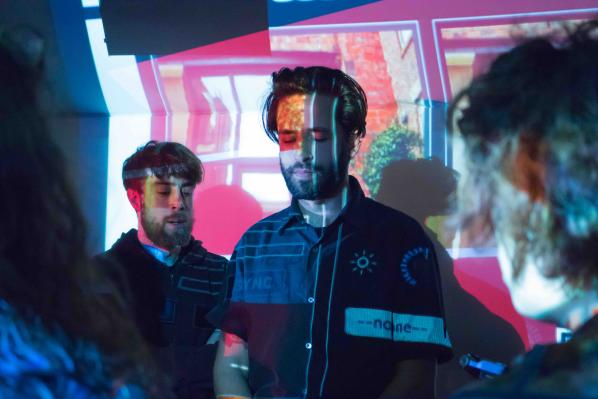
The concept grew from musician Jamie Cook’s final-year music degree performance, where he played with a saxophonist and manipulated her audio live, creating loops, sampling, applying effects and changing speed. “I wanted to use electronics in a very tactile way, so that the audience weren’t shut out between me and the computer screen,” he says. “They could see all of the sounds I was creating, they could see them being taken and then transformed. Over time I added more members from other media, like dancers and visual artists, which grew into this ensemble where everyone improvises live and feeds off each-other’s ideas.”
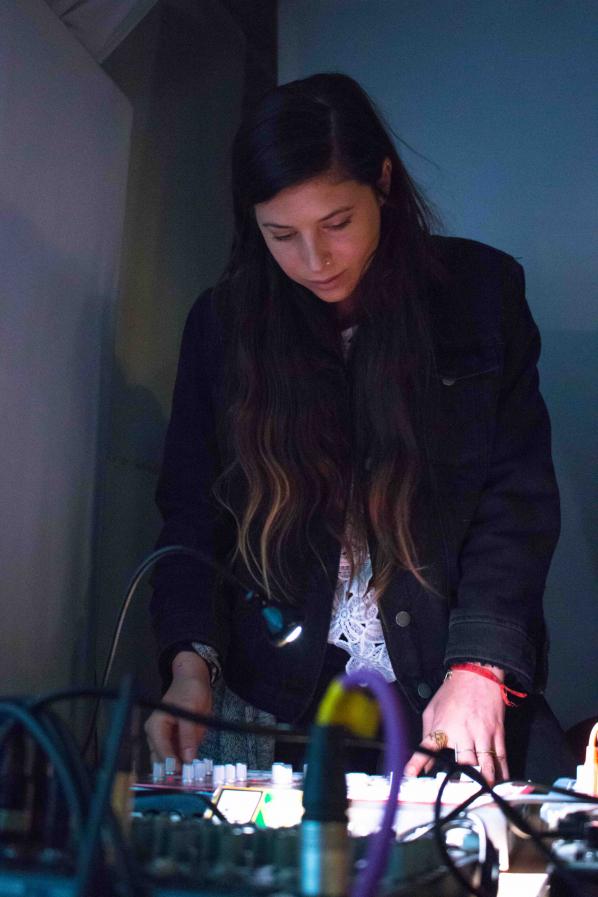
Each Babble performance refers to a short poem written by Charlie Dearnley, based on stories told by his grandmother, which “all grapple with a point of death or unburdening,” he explains. While performing, sensors on his costume feed to digital artist Sean Cotterill, whose software translates the movement into light and sound. “The idea of digital communities, using digital technologies to gather creative communities around them, is important to me,” Sean explains. Written in the supercollider language, Sean has put all his code for the show online, in the hope of developing further feedback loops beyond the live performance.
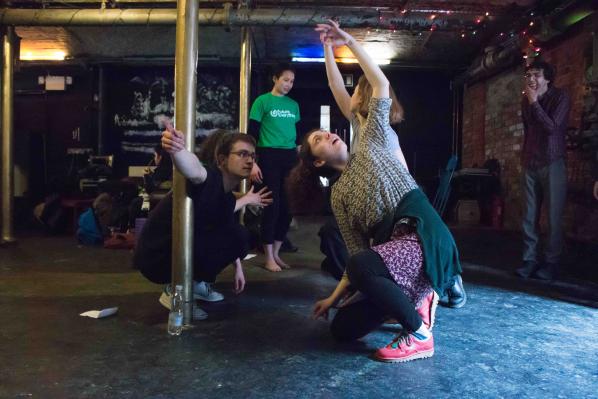
While process is an explicit part of Occasion Collective’s performances, each one feels stirring and organic. “It’s an attempt at honest expression which is heightened and realised through collaboration and working with others,” Charlie says, “acknowledging, for myself, the inadequacy of words in genuinely conveying experience; trying to create something that is more engaging.”
Engaging people is the challenge at the heart of Nelly Ben Hayoun’s work, as she explained after her talk at the Intelligence panel. The so-called ‘Willy Wonka of design’, Nelly is a one-woman nexus of collaboration who creates experiences to generate social action around science and technology, often space exploration. She assembled the International Space Orchestra, the world’s first orchestra composed of space scientists from NASA’s Ames Research Center and the SETI Institute (Search for Extraterrestrial Life). Featuring original music by Beck, Damon Albarn, The Prodigy, Penguin Cafe, Two time Grammy award winner Evan Price and Bobby Womack, she convinced scientists and astronauts to participate in an ambitious musical retelling of the Apollo 11 moon landing in 1969.
Video embed: The International Space Orchestra_ Official IFFR selection 2013 (https://vimeo.com/57863847)
“There are audiences that are not keen to be transported or play any part, but it’s my role to then force them into it,” she explains. “Most of the public is becoming quite lethargic, so it’s really difficult to get them to move. My way of doing things is what I call total bombardment: getting to people through the fields of music, design, arts, theatre, tech, digital and architecture. Even though you might not want to be engaged with the issues or the questions I’m raising, you will find yourself confronted, in any case.”
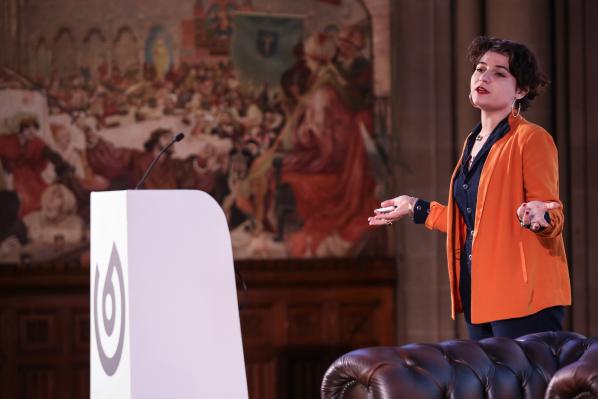
Nelly studied at the Royal College of Art under Anthony Dunne and Fiona Raby, who inspired her problem-finding rather than problem-solving approach to design, particularly with regard to future challenges and the potential impact of evolving technology. Her most recent project, Disaster Playground, investigates the planet’s emergency procedures through attempts to stage a simulation of an asteroid strike. Soberingly, Nelly finds that only about 20 ageing scientists are charged with planning for disasters such as asteroid collisions and meteor showers.
Video embed: Disaster Playground Teaser (https://vimeo.com/107466074)
“I’m applying critical thinking and critical design, but also looking at a range of artistic fields to see how we can merge all of these different disciplines to aim for social action,” Nelly says. “I apply Antonin Artaud’s theory of the Theatre of Cruelty to the way I engage members of the public with scientific research, looking for much more extreme and visceral ways to engage them, which you open up through collaboration. Whenever I work with scientific partners or sociologists or philosophers, I pick the ones who will fight with me. I believe that conflict generates innovation.”
The Turner Prize-winning Assemble collective prefers a more harmonious atmosphere. Comprised of 18 members, Assemble’s collaborative approach to architecture and urban development puts local people at the heart of development, implementation and ultimately the long-term life of each project. They also work on sustainable principles, choosing where possible to work with pre-existing local materials, reusing or repurposing them to better serve the area’s needs.
Assemble’s Mat Leung posed new ways to think about communities in a thought-provoking panel discussion with science fiction writer and futurist Madeline Ashby and new communication technologies expert Sarah Kember at FutureEverything’s Community panel. “[Sarah, Madeline and Assemble] understand community not as a monolithic term,” Mat explains. “Obviously there are loads of different elements to it. The term community is difficult because it assumes a single kind of identity, but together we wanted to interrogate that.”
Multiple communities can exist simultaneously and overlap in a given area, such as a community of residents, who Assemble empowered through the Turner Prize-winning Granby Workshop project, creating jobs through rebuilding a neglected area of Liverpool from the grassroots up; or a community of makers and artists, with whom they worked on the Blackhorse Workshop project in East London.


The Community panel developed a theme that ran through the festival: that no one individual or group is capable of meeting the challenges of the future alone. Finding ways to positively engage multiple stakeholders with a variety of knowledge and skills is vital to finding solutions that meet the needs of the wider community.
“Our successful collaborations come from an understanding that there’s a diversity of stakeholders, skills and knowledge,” Mat says. “We’re interested in a broad range of things, but we acknowledge we’re not amazing at everything. Each different member of Assemble has their own training and expertise, but when we work with a community, people who’ve been there for 15 years know more than we do – they’re experts in a different way. They might not know about which materials to use for a given job, but they can tell you the effect of a layout or the practical implications of what you’re doing. You have to acknowledge that people are experts in different fields”.
Projecting a vision into the future can be one of the hardest challenges for architects – but Assemble have developed what appears to be a powerful and effective way of ensuring the longevity of projects. “When you say ‘Let’s talk about the near future’, architects get hysterical, designers go into meltdown,” Mat explains. “As soon as you say community, legacy, or things like that, it brings up a set of expectations. But what you’re really saying is that you want your idea to be taken on and exist beyond the period you’re directly involved in its life. So we’ve found that collaborating with the community throughout the process, through workshops for example, is a great way to encourage people to continue using spaces after we’ve moved on.”
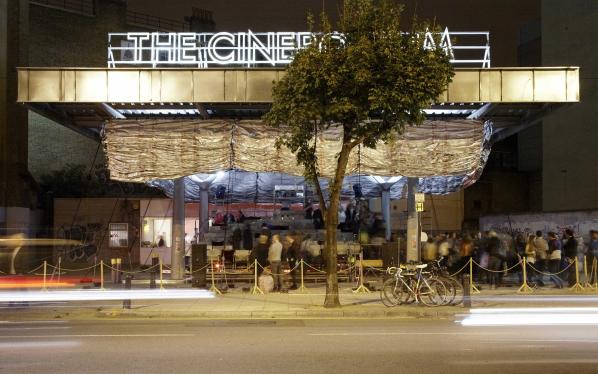
The enthusiastic spirit of collaboration fostered by FutureEverything transcended each event and sparked conversations between practitioners from a variety of different fields, who gave each other new perspectives through which to consider their own work. Drawing on the participatory ethos of progressive digital communities, the festival encouraged a refreshingly open atmosphere. But how to keep this energy going once the festival comes to an end? Many of the artists involved shared their processes in the hope that others can build on their achievements. The vibrant creative melting pot FutureEverything presided over will ensure that the new connections created will lead to even more inspiring projects in the years to come, from networks that extend far beyond Manchester.
Find out more about FutureEverything.
Featured Image: Stock photography from Google Image search “happy creative tech startup”
Neoliberal Lulz: Constant Dullaart, Femke Herregraven, Émilie Brought & Maxime Marion, and Jennifer Lyn Morone.
Showed at the Carroll/Fletcher Gallery 12 February – 2 April 2016.
Neoliberal Lulz asserts to have born witness, arm-in-arm with rest of us, to an unprecedented shift in the volatility and increasing speculative power of financial markets and the dissolution of value indexing to physical commodities. This relationship has been made particularly palpable in the realization that investment banks and corporations hold a tremendous sway (perhaps even tremendous to an unknowable degree) over our lives. The four artist/groups brought together make work as a way of trying to bring this dynamic into knowing.
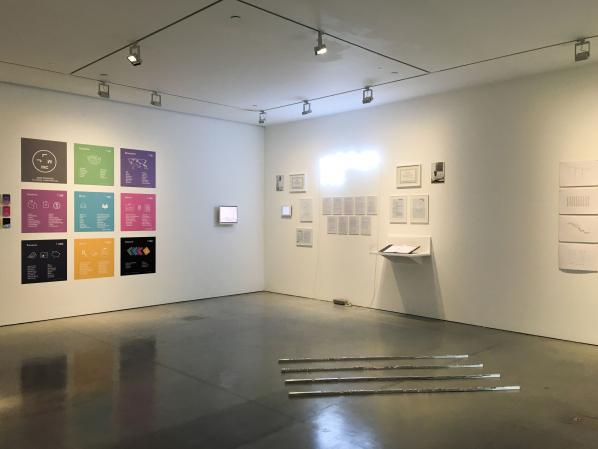
Neoliberal Lulz is not so much about this relationship, or the realization of this relationship, between market forces and lived experience. It’s more accurate to say that the exhibition and the artworks contained within it rather serve as a populist blueprint for how individuals can talk to the market. If political economies speak in the limited language of supply and demand, then how can we make ourselves heard?
New media is a particularly good way of addressing this question because of the way hardware and software must constantly negotiate the terms of inter-communication. The success of media is dependent on this trafficking in translations, between file formats, online and IRL, technical apparatuses, outdated and current softwares. So when artists like Constant Dullaart, Femke Herregraven, Émilie Brought & Maxime Marion, and Jennifer Lyn Morone make themselves “corporate,” mimicking the neoliberal virus, this move feels right at home with the kinds of techno-alchemist work being displayed.

Femke Herregraven makes the mystifying lifespan of high frequency trading material, which feels a lot like spinning straw into gold (or perhaps the other way around). Her works rehearse this slippery, ambivalent relationship between value and objects, indexes and standards. In this way Herregraven’s works ground the exhibition in a similar way as does Constant Dullaart’s Most likely involved in sales of intrusive privacy breaching software and hardware solutions to oppressive governments during so called Arab Spring: by memorliaizing in cold, clunky materiality the “immaterial” processes that are active under the banner of neoliberalism everyday. Three of the four artists on display have incorporated—Jennifer Lyn Morone™ Inc, Untitled SAS (that’s Émilie Brought & Maxime Marion), and DullTech™ (Constant Dullaart). Between these companies the process of how to become a company is cracked open, revealing how sophomorically simple and complicated the process is, how much paper detritus and nondescript stuff is secreted as byproduct. Constant Dullaart here adds a lesson on the aesthetics of startups with an entire room dedicated to the oddly-familiar B-roll shots of airplanes cut with inspirational platitudes. Jennifer Lyn Morone adopts the the aesthetics of a kind of good life marketing that is gender-targeted, and operates by corroding away what’s already there (mental health, well-being) to make its own market gap.
But I tell you this: the best part of the exhibition isn’t on display. Ask the front desk about buying shares of either Untitled SAS or Jennifer Lyn Morone™ Inc. This is the heart of the exhibition, and it’s either lamentably sidelined or a brilliantly premeditated that just inquiring about the purchase can reveal so many gaps and uncertainties.
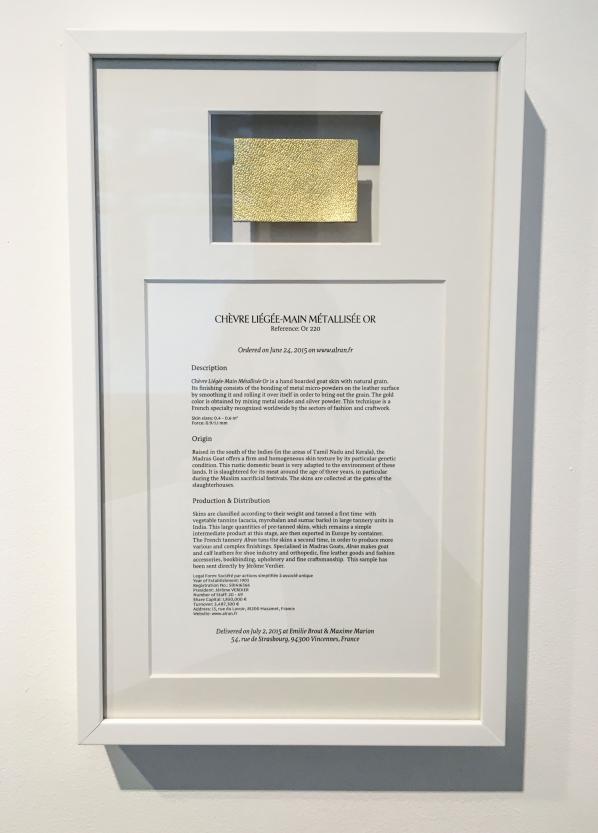
When I visited the exhibition, gallery attendants very kindly filled me in on the bold point details of buying shares, to the best of their ability. They explained that Unititled SAS shares sold for €30.00, with a €25.00 admin fee that went straight to Émilie and Maxime. It is not split with the gallery, as often the the sales of an art object are. Was the gallery entitled to any part of the sale of shares of Untitled SAS? Sort of: fifty-percent went to the French government, twenty-five percent went to Émilie and Maxime, and half of the remaining twenty-five percent went to the gallery. Did a new contract have to be drawn up to negotiate the profit negotiations between the gallery and artists who had incorporated some capacity? No, the normal consignment contracts were used (they did not share what the terms of these contracts are; I did not inquire).
What about shares of Jennifer Lyn Morone™ Inc.— how much did they cost? This was a decidedly trickier question, with nationality and class-based restrictions and allowances. The general gist was that since Jennifer Lyn Morone™ Inc. is registered in the U.S.A., that American citizens are subject to tax; English citizens are not. For English citizens there are also different price points and clauses for lower-income prospective investors. This does not apply to U.S. citizens, who are required to prove salary requirements before purchase can be approved.
Had anyone bought any shares yet, for either company? No.
Eventually, the attendants printed me a Jennifer Lyn Morone™ Inc. Instructions for Prospective Investors document: four-pages single-sided, unceremoniously stapled together. For those unfamiliar with this kind of legalese, it’s a bizarre artifact from another planet. Everyone should ask for a copy.
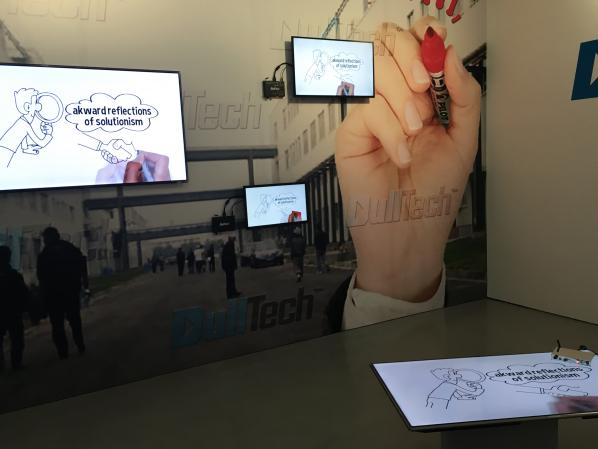
The title Neoliberal Lulz might tip its hat to the tradition of online trolls and their persistent, agnostic vitriol, but the exhibition itself feels like it sets out some very real stakes. This is a good thing, because an exhibition interrogating the asymmetrical relations of production and profit taking place at a prominent art gallery in Fitrovia (a borough in itself that is paradigmatic of these inequities) could have really been smug, smarmy, shit. The hypocrisy of an exhibition that singularly railed against the unmitigated growth of big business while standing amongst its spoils would be too much. But Neoliberal Lulz is not this: it is far more nuanced in its message, far more unclear on its value judgments. As an art exhibition Neoliberal Lulz did well to espouse the artist-as-researcher model. It helps make sure that the exhibition has legs outside of the exhibition space. The fact that most of these artworks have a life outside of the domain of art, circulating within the very thing they’re critiquing, legitimates their output. The other thing that Neoliberal Lulz does well is not to dwell on the narrative of the disenfranchised. I don’t say this because it’s not important but rather because it just simply wouldn’t read.
Neoliberal Lulz feels like a prompt that comes at a timely moment, slotting in to conversations like this, this, and this. It criticizes at the same time as it offers options, which seems like a rare combination these days. “What is to become of the future for young artists?”–the people wail, lamenting that much of the young, creative elite inevitably ends up siphoned off into the tech startup culture. Neoliberal Lulz seems to say this doesn’t have to be a bad thing, and I’m inclined to agree. All’s not lost when artists adopt an if you can’t beat ‘em, join ‘em ethos, particularly when they do so with a critical bent. Deeply sardonic and ruthlessly interrogative, Neoliberal Lulz is a successful venture into addressing the malleability of contemporary political economies to more progressive ends.

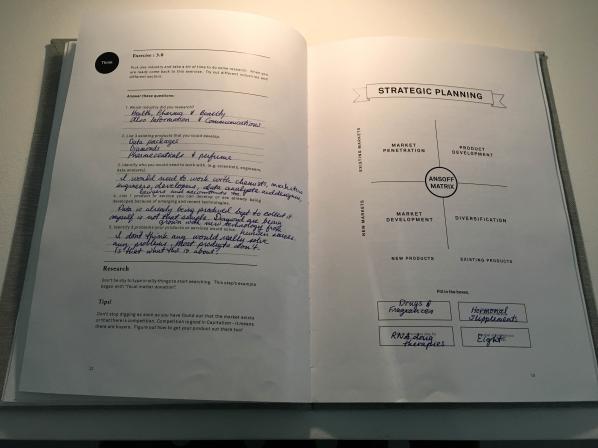
Carroll/Fletcher Gallery
56-57 Eastcastle St.
London W1W 8EQ
As part of transmediale’s opening night in Berlin, audiences were sat in front of three large screens and taken on a journey through the abstract infrastructures of the imminent ‘smart city’. Liam Young, a self-proclaimed speculative architect, narrated the voyage whilst beside him, Aneek Thapar designed live sonic soundscapes complementing the performance. For Young, the smart city is a space where contemporary anxieties are not only unearthed but increasingly multiplied. The smart city manufactures users out of citizens, crafting an expanse whereby the hegemonic grip of super-production evolves into a threateningly subversive entity. According to Young, speculative architecture is one of the methods of combating the city’s supremacy – moulding the networks within a smart city to facilitate our human needs within a physical realm. It is a means of becoming active agents in amending the future.

Speculative architecture as a term is relatively new, however the concept’s origins date back to the 1970s Italian leftist avant-garde. Back then it was called ‘Radical Architecture’, a term initiated by SUPERSTUDIO’s conceptual speculation regarding the structures of architecture. SUPERSTUDIO’s methods were transcendental as they favoured the superiority of mental construction over the estranged act of building. The founders of the group, Adolfo Natalini and Cristiano Toraldo di Francia, acknowledged modernist architecture as reductive to man’s ability of living a free life since its core foundations were built on putative methods of indoctrinating society into a pointless culture of consumption. The development of The Continuous Monument was a declaration to end all monuments since the structure itself was designed to cover the expanse of the world. Its function was to form ‘a single continuous environment of the world that would remain unchanged by technology, culture and other forms of imperialism’ as stated by SUPERSTUDIO itself. A function sufficiently egalitarian, and in some respects utopic, The Continuous Monument, much like Tatlin’s Third International in the 1920s, was never intended to be built, but instead to uncover the notion of total possibility and arbitrariness. Likewise, Young’s performative smart city does not purpose itself around applicable techniques of construction – it creates scenarios of possibility exploring the autonomous infrastructures that lie between the premeditated present and the predicted future. Hello City! intends to transpire the idea that computation, networks and the anomalies that surround them are no longer a finite set of instructions, but instead constitute an original approach to exploring and facilitating speculative thought through imagined urban fictions.

Liam Young’s real-time cinematic narration cruises us like a ‘driverless vessel’ through the smart city beyond the physical spectrum. The smart city becomes an omnipresent regulator of our existence, as it feeds on the data we wilfully relinquish. Our digital footprint re-routes the city, traversing us into what Young calls ‘human machines of the algorithm’. His narrative positions human beings as ‘machines of post-human production’ within what he names a ‘DELTA City’. As an envisioned dystopia which creates perversions between the past, present and future, Hello City! is reminiscent of Kurt Vonnegut’s post-modern narrative in Cat’s Cradle. San Lorenzo, the setting for Vonnegut’s book, is on the brink of an apocalypse – the people’s only conjectural saviour would be their deluded but devoted faith to ‘Bokononism’, a superficial religion created to make life bearable for the island’s ill-fated inhabitants. Moreover, the substance ‘Ice-9’, a technological advancement, is exploited far from its original purpose of military use, leading to looming disaster. Both Bokononism and the existence of Ice-9 resonate Young’s narrative as they explore the submissive loss of free will and the consequences of allowing the future to be dictated by uncontainable entities. In Hello City! the metropolis becomes despotic and even more complex as it is designed by algorithms feeding on information instead of the endurances and sensitivities of the human body.
Like software constructed by networks, the future landscape will be a convoluted labyrinth for physical beings. Motion within the city will be ordained by a form of digital dérive structured by self-regulated and sovereign systems. Young’s video navigates us through blueprint structures simulating the connections within networks thus proclaiming the voyage as unbridled by our own corporal bodies. The body is no longer dominant. He introduces us to Lena, the world’s first facial recognition image, originally a cover from a 1972 Playboy magazine. Furthermore, he makes references to Internet sensation Hatsune Miku as a ‘digital ghost in the smart city’ whilst the three screens project and repeat the phrase ‘to keep everybody smiling’ ten times. We may speculate that for Young, the smart city has the potential to function like Alpha 60, a sentient computer system in Godard’s film Alphaville, controlling emotions, desires and actions of the inhabitants in the ‘Outlands’. As Young dictates ‘the City, looks down on the Earth’ – it becomes a geological tool and engages the speculative architect to remain relevant within the ever-changing landscape of that space.
In a preceding interview, Young refers to the speculative architect as a ‘curator’, ‘editor’ and ‘urban strategist’ attempting to decentralise power structures from conventional and conformist architectural thought. In 2014, Young’s think tank ‘Tomorrow’s Thoughts Today’ envisaged and undertook a project titled New City. New City is a series of photorealistic animated shorts featuring the cities of tomorrow; one is The City in the Sea, another is Keeping Up Appearances and the last is Edgelands. Too often, these works are projected and interpreted with the foreseeable frowning of rising consumerism concurrent with the dissolute development of technological super structures. Without a doubt, the supposition that technology is alienating us from our identities as citizens of a city is undeniable and exhaustively linked to the creation of super consumers and social media. Nonetheless, New Cities is more than just about that – comparable to the architectural intrusions of SUPERSTUDIO, the narrative of Cat’s Cradle and Alphaville,New City underlines the impending subsequent loss of human liberty with the advent emergence of the smart city whilst Hello City! injects the audience in within it.
Young’s notion of the smart city is consolidated within a Post-Anthropocene existence. Without any dispute, our world will inevitably divulge a post-anthropocene reality, but until that critical moment arrives, acts of speculation, such as speculative architecture, only exist within the hypothesis of potentiality. In fact, throughout Hello City! speculation cannot be positioned as either a positive or negative entity – it appears to lie within a neutral area of hybridity and experimentation. The narrative of Hello City! is purely speculative and thus exceedingly experimental. Like much of SUPERSTUDIO’s existence, antithetical notions of egalitarianism and cynicism run throughout Hello City! triggering perpetual seclusion of the audience’s contemplations. Conflicting positions reveal an ambivalence resulting to escalated concerns towards the act of execution. Speculative architecture itself is a purely narrative process designed on a fictitious future that is not formulated and so the eternal battle between theory and practice will always occur. Uncertainties raise an issue of pragmatism and whether speculation, evidently in architecture, is commendable. Seeing as speculation for the future is, in its most basic form, an act of research, it is regarded as the most pragmatic practise when taking into consideration any future endeavours. As the performance draws to an end, Young declares that ‘In the future everything will be smart, connected and made all better’ and then indicates towards the contradicting existence of Detroit subcultures that the future map will be unable to locate. A message loaded with properties that are paradoxical and thus ambiguous in their intent, Hello City! occupies itself with inner contradictions that only create the possibility for plural futures, a functional commons for the infrastructure of tomorrow.
Featured Image: Johannes lands in San Francisco.
Traceroute – A Personal Journey Into the Uncharted Depths of Nerd Culture, A Realm Full of Dangers, Creatures, and More or Less Precarious Working Conditions. (Or Fear and Loathing in Nerdcore).
“In the end, we’ll all become stories” Margaret Atwood.
Before Vaporwave, Post-Internet, Facebook, and your latest Kickstarter campaign, there was the cybercultural counterculture. I encountered it through publications like Collapse, Mondo 2000, ReSearch, Fringeware Review, and bOING bOING (when it was still in print), and on BBS boards like The Thing and The WELL. This was the land of cyberpunk, Dead Media, Tactical Media, The Church of the SubGenius, online dungeons and wetware hacking. This is the native culture of Johannes Grenzfurthner, born of the dark forests of Austria, famous for music and mass murder (by his own admission), and a crèche for nerddom.
Traceroute (…) is a reflection on his own roots of nerddom, and an On the Road style romp across the United States as he visits icons of the counterculture, the outré, and the generally questionable.
He begins Traceroute with a fitting genesis story of his growing up in Central Europe, dressing like Captain Kirk, making treehouses and accidentally killing the family chicken with a failed science experiment, reading comic books, making short films, and being obsessed with Pachelbel’s Canon in D Minor. He saw that the neighbor’s patio tile always looked like LCD displays, and he started noodling around with his neighbor’s computer, logging into the FIDONet, learning about his nerddom, discovering ASCII porn, and Woschi Woschi Wau Wau, the Dog that Never Pooped. If you’re following me up till now, then you’ll get the general tone of the movie.
As Johannes expands on his arc from a gawky Austrian kid to founding the cybermedia group Monochrom in a quirky Germanic stream of consciousness, he decides to take his friends Jenny and Eddie on a trip across the US for a tour de farce into the depths of cyber-counterculture.
He begins his trip, of course, in San Francisco – home of the counterculture and the Californian Ideology, which he calls, “a fantastic realm of infinite opportunity and homelessness” There, he begins his intellectual trek across the USA with V. Vale – author and publisher of the ReSearch series of documentary books. Vale began his publishing career with a volume called Search and Destroy while working at the City Lights bookstore – a Mecca of beat culture. He cements the foundations for the film in saying that nerds made the counterculture; there is a sort of reflection that only comes from isolation or obsessiveness, and “There is no creativity in the absence of revolt.” says Vale.
Suddenly, I realize that I’m about a half thousand words into this review, and only about a quarter way through the movie, and barely out of San Francisco. That is the nature of Traceroute, a relentless stream of factoids and side trips that talks about many things, like the whiteness of cyberculture, the uncomfortable relationship between counterculture and neoliberalism, shipping containers, Area 51, as well as sci-fi props and makeup at Stan Winston Studios. This is the nature of the nerd; to be infinitely interested in infinite numbers of things, the more obscure the better. Actually, giving a feel for the film without describing it in total is probably the best thing to do, as it leaves many of the places Johannes goes to the imagination.
Traceroute has both memorable moments and stops that simply must be done if one is to visit cyber-counterculture. One of the mandatory stops is to SxSW Interactive in Austin, Texas and a chat with Jon Lebkowsky and Bruce Sterling. Jon is one of the founders of the legendary 90’s zine Fringeware Review and icon of Austin counterculture, as well as omniglot. Bruce Sterling, is of course, Bruce Sterling – cyberpunk author, WIRED Magazine blogger, and cyber-tastemaker. Listening to Lebkowski’s surprise at the traction of the cyberpunk movement in the 90’s in contrast to Sterling’s waxing of hanging with the tragically hip Milanese cyber-squatters of the time reminded me of the romanticism that also accompanies the underground.
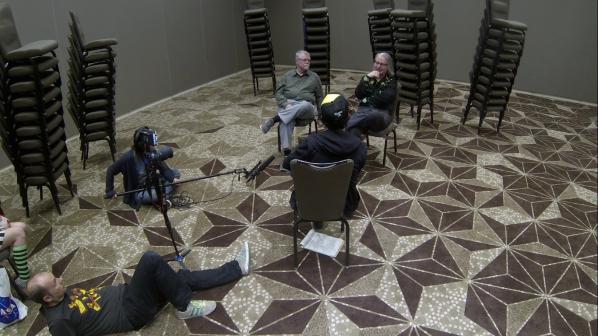
A fantastic moment was when the Traceroute crew actually winds up at the gate to Area 51 in the middle of the night and decide to talk to tactical artist Trevor Paglen to get more information about the site. Paglen, almost more than anyone, has done work that reveals “black” projects being pursued by the US government, such as stealth technology, spy satellites, the location of Internet ocean cables, and so on. During their conversation, Paglen brings up a mission patch for the US Air Force for a stealth project that has two things. First, there is an alien head, as it is Area 51 after all, and a caption that reads, “Gustatus Similus Pullus”, (or, Tastes Like Chicken). Frat humor in the skunkworks – hmmm…
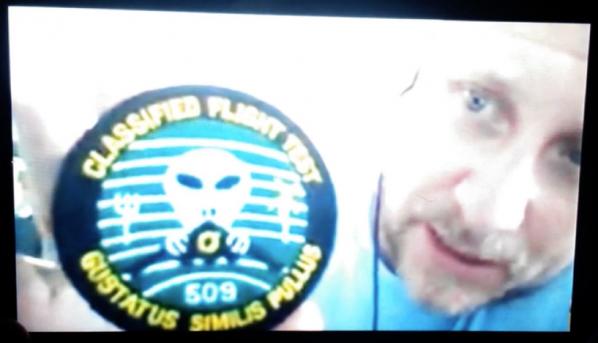
Grenzfurthner also muses that we are two things – sexual beings and tool users. This makes sense as his group Monochrom hosts the annual Arse Electronika festival (a sexual play on the Ars Electronica in Linz). This reveals itself in a number of segments with Miss Maggie Mayhem (San Francisco), Kit Stubbs (Boston), Christina Anapakis (Los Angeles, who does art from body cultures), and Bad Dragon, a company that does science fiction/fantasy dildos. From Maggie’s playfully powerful illustrations of the links between sex work and Silicon Valley to Christina’s experiments with Johannes’ culture to make a failed cheese, I am happy to see that Monochrom’s sex and body-positive message that nerds are filled with a curiosity about all of the world around them is present in Traceroute.
My only complaint about the movie is that I wanted more of it, or perhaps more of the eastern US, as it is nearly three-fourths of the way through the film before we leave Austin. Perhaps the newest part of the country, the West, might be the weirdest, but I’ll leave that to Johannes. And there are tons of other alternative cultural sites to go, like the Museum of Jurassic Technology and Craig Baldwin’s Artist’s Television Access in California, and Rich Pell’s Center for Postnatural History, the Mystery Spot, but he had a week, and only two hours of video. But on the other hand, I’m giving inordinate attention to the first half of the film, so not only am I self-referentially riffing on Grenzfurthner’s narrative style here, but mimicking the structure of the movie.
Lastly, anyone dealing with outré culture that mixes nerddom and capitalist critique has to go to Monroeville, Pennsylvania – site of George Romero’s marvelous political zombie flick, Dawn of the Dead. They go to Monroeville Mall, the site of the movie itself, with leftist critic and game designer Paolo Pedercini. There is a certain poesis about Paolo ranting about consumer culture, nerddom, the nexus of the mall and the surveillance state while waiting for the security guards at the mall to show up. These remarkably self-referential shots are what makes Traceroute magical.
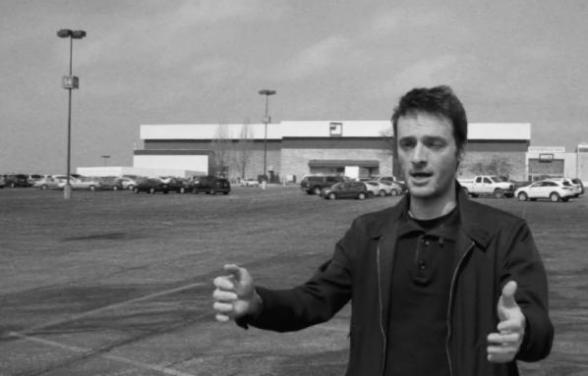
After watching Traceroute, I was left with a real exhilaration and a deeply reflective feeling at once, but I think this would be similar to Grenzfurthner’s experience on his ur-nerdtrek across the USA. I mean, except for being a decade older, we have a lot in common. Our upbringings were similarly nerdy, but mine in Ohio, and his in Austria, he started Monochrom while I was with RTMark, we have many friends in common in the film, and we’ve glancingly communicated for decades. And he just made the documentary of our shared subculture. Of course, I’m going to like this film.
However, I wondered – what about the relevance of cyberculture and the counterculture in the age of Facebook and postinternet slickness? I mean, what role does Traceroute’s subject matter have in the light of neoliberal, hyperprofessionalized cultural production evident in the mid-2010’s? But then, the words of Sandy Stone, an eternal voice of reason, rang out in my mind. She said that William Gibson (and I’d add, Sterling and the rest of the cyberpunks as well) wrote this future, and a lot of it came true. And it sort of went to shit, and we’re still doing it, and it’s all good. And I’d like to expand in saying that not just cyberculture, but counterculture just keeps going, and the fact that it’s from the 80’s or 90’s (or the 60’s, for that matter) makes any difference. What Johannes terms as nerd culture is merely many aspects of Western counterculture, and it’s a tradition that has given rise to everything from the Summer of Love to the personal computer (and that’s just San Francisco…). What Traceroute reveals is the tradition of alterity just beneath the surface of Western culture, and that it has a powerful effect on our mass consciousness, whether it is in plain sight or not. Traceroute is debuting at the NYC Independent Film Festival, April 27-May 1, 2016.
The Rubix Cube is is not the only twisty puzzle. Learn about Pyraminx, the 2×2 and 4×4 cubes, the Megaminx on Ruwix.
Gretta Louw reviews Abrahams’ book from estranger to e-stranger: Living in between languages, and finds that not only does it demonstrate a brilliant history in performance art, but, it is also a sharp and poetic critique about language and everyday culture.
Annie Abrahams is a widely acknowledged pioneer of the networked performance genre. Landmark telematic works like One the Puppet of the Other (2007), performed with Nicolas Frespech and screened live at the Centre Pompidou in Paris, or her online performance series Angry Women have solidified her position as one of the most innovative net performance artists, who looks not just at the technology itself but digs deeper to discover the ways in which it impacts human behaviour and communication. Even in the present moment, when online performativity is gaining considerable traction (consider the buzz around Amalia Ulman’s recent Instagram project, for example), Abrahams’ work feels rather unique. The strategy is one of contradiction; an intimacy or emotionality of concept and content, juxtaposed against – or, more accurately, mediated through – the technical, the digital, the screen and the network to which it is a portal. Her recent work, however, is shifting towards a more direct interpersonal and internal investigation that is to a great extent nevertheless formed by the forces of digitalisation and cultural globalisation.

(E)stranger is the title that Abrahams gave to her research project at CONA in Ljubljana, Slovenia, and which led to the subsequent exhibition, Mie Lahkoo Pomagate? (can you help me?) at Axioma. The project is an examination of the shaky, uncertain terrain of being a foreigner in a new land; the unknowingness and helplessness, when one doesn’t speak the language well or at all. Abrahams approaches this topic from an autobiographical perspective, relating this experiment – a residency about language and foreignness in Slovenia. A country with which she was not familiar and a language that she does not speak – regressing with her childhood and young adulthood experiences of suddenly being, linguistically speaking, a fish out of water. This experience took her back to when she went to high school and realised with a shock that, she spoke a dialect but not the standard Dutch of her classmates, and then this situation arose again later when she moved to France and had to learn French as a young adult.
There are emotional and psychological aspects here that are significant and poignant – and ‘extremely’ often overlooked. The way one speaks and articulates oneself is so often equated with intelligence and authority – and thus the foreigner, the newcomer, the language student, is immediately at a disadvantage in the social hierarchy and power distribution. Then, there are the emotional aspects and characteristics requisite for learning a language; one must be willing to make oneself vulnerable, to make mistakes. This is a drain on energy, strength, and confidence that is rarely if ever acknowledged in the current discourse around the EU, migration, asylum seekers, and – that dangerous word – assimilation. Abrahams lays her own experiences, struggles, and frustrations bare in a completely matter-of-fact way, prompting a re-thinking of these commonly held perceptions and exploring the ways that language pervade seemingly all aspects of thought, self, and relationships.
Of course this theme is all the more acute in a world that is increasingly dominated by if not the actual reality of a complete, coherent, and functioning network, then at least the illusion of one. In a world where, supposedly, we can all communicate with one another, there is increasing pressure to do so. Being connected, being ‘influential’ online, representing and presenting oneself online, branding, image – these are factors that are becoming virtues in and of themselves. Silicon Valley moguls like Mark Zuckerberg have spent the last five or six years carefully constructing a language in which online sharing, openness, and connectivity are aligned explicitly with morality. Just one of the many highly problematic issues that this rhetoric tries to disguise is the inherent imperialism of the entire mainstream web 2.0 movement.
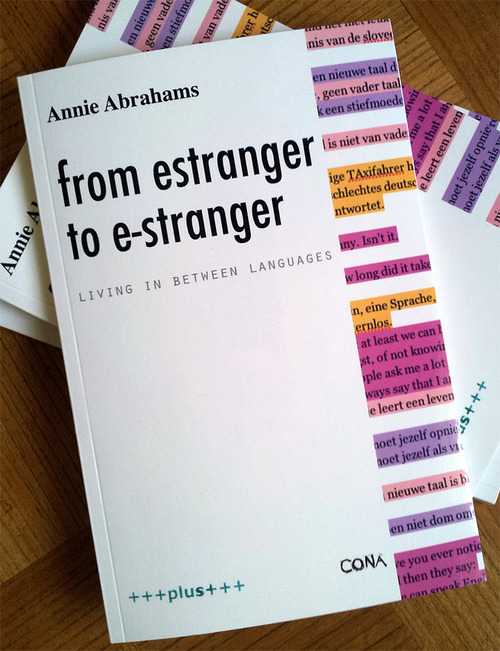
Abrahams’ book from estranger to e-stranger: Living in between languages is the analogue pendant to the blog, e-stranger.tumblr.com, that she began working on as a way to gather and present her research, thoughts, and documentation from performances and experiments during her residency at CONA in April 2014 and beyond. Her musings on, for instance, the effect dubbing films and tv programs from English into the local language, or simply screening the English original – how this seems to impact the population’s general fluency in English – raise significant questions about the globalisation of culture. And the internet is arguably even more influential than tv and cinema were/are because of the way it pervades every aspect of contemporary life.
This leads one irrevocably to consider the digital colonialism of today’s internet; the overwhelming dominance of western, northern, mainstream, urban, and mostly english-speaking people/systems/cultural and power structures. [1] Abrahams highlights the way that this bleeds into other areas of work, society, and cultural production, for example, through her citation of Mladen Stilinovic’s piece An Artist Who Cannot Speak English is No Artist (1994). In a recent blog post, Abrahams further reveals the systematic inequity of linguistic imperialism and (usually English speakers’) monolingualism, when she delves into the language politics of the EU and its diplomacy and parliament [http://e-stranger.tumblr.com/post/139842799561/europe-language-politics-policy].
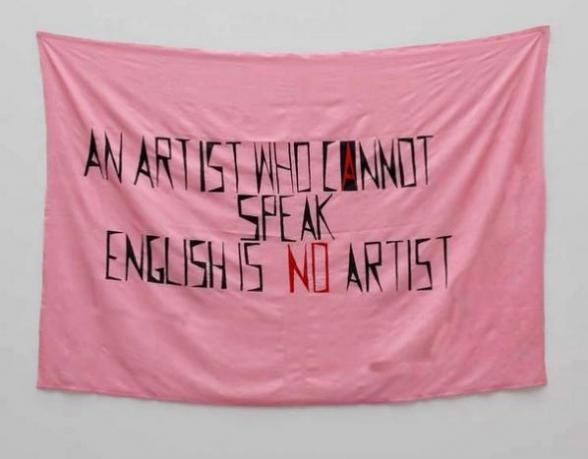
from estranger to e-stranger is an almost dadaist, associative, yet powerful interrogation of the accepted wisdoms, the supposed logic of language, and the power structures that it is routinely co-opted into enforcing. It is a consciously political act that Abrahams publishes her sometimes scattered text snippets – at turns associative or dissociative – in a wild mix of languages, still mostly English, but unfiltered, unedited, imperfect. A rebellion against the lengths to which non-native speakers are expected to go to disguise their linguistic idiosyncrasies (lest these imperfections be perceived as the result of imperfect thinking, logic, intelligence). And yet there is an ambivalence in Abrahams’ intimations about the internet that reflect the true complexity of this cultural and technological phenomena of digitalisation. Reading the book, one feels a keen criticism that is justifiably being levelled at the utopian web 2.0 rhetoric of democratisation, connection etc, but there are also moments of, perhaps, idealism, as when Abrahams asks “Is the internet my mother of tongues? a place where we are all nomads, where being a stranger to the other is the status quo.”
Abrahams’ project is timely, especially now that we are all (supposedly) living in an infinitely connected, post-cultural/post-national, online society, we are literally “living between languages”. The book is an excellent resource, because it is not a coherent, textual presentation of a thesis; of one way of thinking. It is, like the true face of the internet, a collection, a sample, of various thoughts, opinions, ideas, and examples from the past. One can read from estranger to e-stranger cover to cover, but even better is to dip in and out, and or to follow the links and different pages present, and be diverted to read another text that is mentioned, to return, to have an inspiration of one’s own and to follow that. But to keep coming back. There is more than enough food for thought here to sustain repeated readings.
I arrived at the Transmediale festival late Friday afternoon, which was hosted as usual at Das Haus der Kulturen der Welt (The House of World Cultures) in Berlin. The area where the building is sited was destroyed during World War II, and then at the height of the Cold War, it was given as a present from the US government to the City of Berlin. As a venue for international encounters, the Congress Hall was designed as a symbol of ‘freedom’, and because of its special architectural shape the Berliners were quick to call the building “pregnant oyster” [1] The exterior was also the set for the science fiction action film Æon Flux in 2005. Both past references link well with this festival’s use of the building. I remember during my last visit, in 2010, standing outside the back of the building watching an Icebreaker cracking apart the thick ice in the river. The sound of the heavy ice in collision with the sturdy boat was loud and crisp. This sound has stayed with me so that whenever I hear a sound that is similar I’m immediately transported back to that point in time. Unfortunately, this time round there was no snow, instead the weather was wet, warm and slighty stormy.
Last year’s festival explored the marketing of big data in the age of social control. This year, the chosen format was entitled conversationpiece, with the aim of enabling a series of dialogues and participatory setups to talk about the most burning topics in post-digital culture today. To give it grounding and historical context the theme was pinned to the “backdrop of different processes of social transformation, 17th and 18th century European painters perfected the group portrait painting known as the “Conversation Piece” in which the everyday life of the aristocracy was depicted in ideal scenes of common activity.” In recent years the festival has scafolded its panels, workshops and keynotes to grand, central themes to guide its peers and visitors, along with a large-scale curated exhibition. If we view the four interconnected thematic streams- Anxious to Act, Anxious to Make, Anxious to Share and Anxious to Secure – we might guess that the festival curators are also anxious to save all the resources (and celebrations) for next year, which is after all, Transmediale’s 30th birthday.
So, I was curious to see how my brief time here would unfold…
This review is focused on the hybrid event Off-the-Cloud-Zone. It featured presentations, talks and workshops, starting at 11 am, going on until 8pm. Hardcore indeed. It demanded total dedication, which unfortunately I was not able to give. However, I did offer my attention to the rest of the proceedings from lunch time until the end. It was moderated by Panayotis Antoniadis, Daphne Dragona, James Stevens and included a variety of speakers such as: Roel Roscam Abbing, Ileana Apostol, Dennis de Bel, Federico Bonelli, James Bridle, Adam Burns, Lori Emerson, Sarah T Gold, Sarah Grant, Denis Rojo aka Jaromil, George Klissiaris, Evan Light, Ilias Marmaras, Monic Meisel, Jürgen Neumann, Radovan Misovic aka Rad0, Natacha Roussel, Andreas Unteidig, Danja Vasiliev, Christoph Wachter & Mathias Jud, and Stewart Ziff.
The Off-the-Cloud-Zone day event was a continuation of last year’s offline networks unite! panel and workshops. Which also originated from discussions on a mailing list called ‘off.networks’ with researchers, activists and artists working together around the idea of an offline network operating outside of the Internet. The talks concentrated on how over recent years there has been a growing scene of artists, hackers, and network practitioners, finding new ways to ask questions through their practices that offer alternatives in community networks, ad-hoc connectivity, and autonomous systems of sensing and data collecting.
Disillusionment with the Internet has spread widely since 2013, when Edward Snowden the US whistleblower leaked information on numerous global surveillance programs. Many of these programs are run by the NSA and Five Eyes with the cooperation of telecommunication companies and European governments raising big questions about privacy and exploitation of our online (interaction) data. This concern is not only in relation to spying corporations, dodgy regimes and black hat hackers, but also our governments. “The idea of privacy has been flipped on its head. People don’t have to disclose their own information voluntarily anymore; it’s being taken from them regardless of their wishes.” [2] (Nowak 2015)
“The NSA’s principal tool to exploit the data links is a project called MUSCULAR, operated jointly with the agency’s British counterpart, the Government Communications Headquarters . From undisclosed interception points, the NSA and the GCHQ are copying entire data flows across fiber-optic cables that carry information among the data centers of the Silicon Valley giants.” [3] (Gellman and Soltani, 2013)
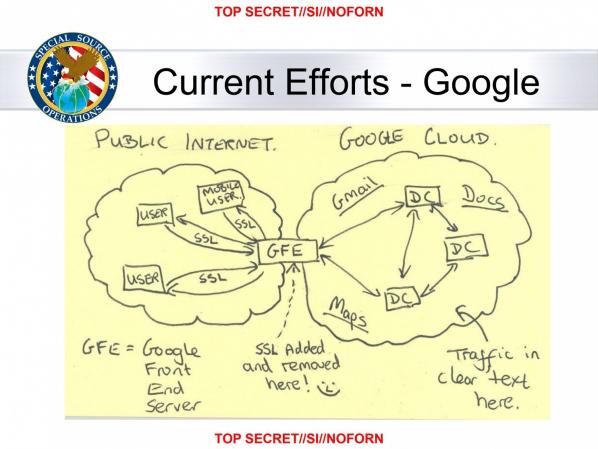
The above slide is from an NSA presentation on “Google Cloud Exploitation” from its MUSCULAR program. The sketch shows where the “Public Internet” meets the internal “Google Cloud” where user data resides. [4]
A legitimate concern for anyone wishing to read the contents of the leaked Snowden files, is that they will be spied upon as they do so. Evan Light has been working on finding a way around this problem, and at the Off-the-Cloud-Zone day event he presented his project Snowden Archive-in-a-Box. A stand-alone wifi network and web server that permits you to research all files leaked by Edward Snowden and subsequently published by the media. The purpose of the portable archive is to provide end-users with a secure off-line method to use its database without the threat of surveillance. Light says, usually the wifi network is open, but users do have the option to make their own wifi passwords and also choose their encryption standard.
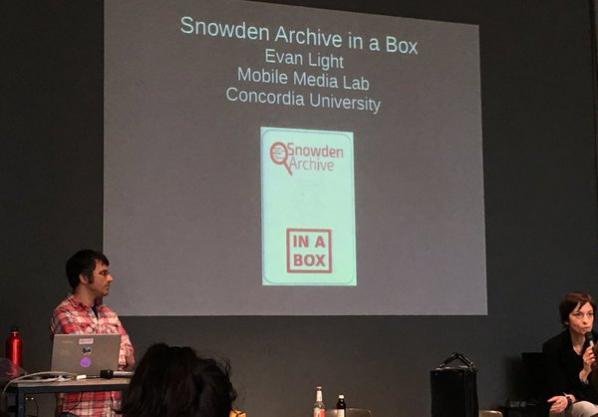
Snowden Archive-in-a-Box is based on the PirateBox, originally created by David Darts who made his in order to distribute teaching materials to students without the hassle of email. It is based on a RaspberryPi 2 mini-computer and the Raspbian operating system. All the software is open-source and its most basic setup can run on one RaspberryPi. In his talk Light said that a more elaborate version would use high-quality battery packs and this adds power for autonomy, along with the wifi sniffer that is running on a secondary RaspberryPi and a flat-screen for playing back IP traffic. If you’re interested in building your own private, pirate Archive-in-a-Box, visit Light’s web site for instructions on how to.

Christoph Wachter’s and Mathias Jud’s work, directly engages with refugees and asylum seeker’s social situations, policies, and the migrant crisis. They’ve worked together on participatory community projects since 2000 and have received many awards. For instance, take a look at their digital communications tool qaul.net which is designed to counteract communication blackouts. It has been used successfully in Egypt, Burma, and Tibet, and works as an alternative to already existing government and corporate controlled communication pathways. But, it also offers vital help when large power outages occur, especially in areas in the world suffering from natural disasters. The term qaul is Arabic and means ‘opinion, say, talk or word’. Qaul is pronounced like the English word ‘call’.

It creates a redundant, open communication code where wireless-enabled computers and mobile devices can directly initiate a fresh, unrestricted and spontaneous network. This includes the enabling of Chat, twitter functions and movie streaming, independent of Internet and cellular networks. It is also accessible to a growing Open Source Community who can modify it freely.
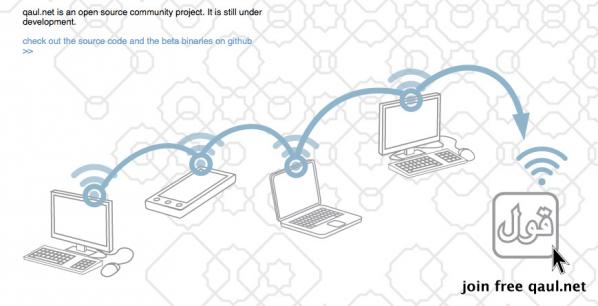
Wachter and Jud also discussed another project of theirs called “Can You Hear Me?”, a WLAN / WiFi mesh network with can antennas installed on the roofs of the Academy of Arts and the Swiss Embassy in Berlin, which was located in close proximity to NSA’s Secret Spy Hub. These makeshift antennas made of tin cans were obvious and visible for all to see. The Academy of Arts joined the project building a large antenna on the rooftop, situated exactly between the listening posts of the NSA and the GCHQ to enable people to directly address surveillance staff listening in. While installing the work they were observed in detail by a helicopter encircling overhead with a camera registering each and every move they made, and on the roof of the US Embassy, security officers patrolled.

“The antennas created an open and free Wi-Fi communication network in which anyone who wanted to would be able to participate using any Wi-Fi-enabled device without any hindrance, and be able to send messages to those listening on the frequencies that were being intercepted. Text messages, voice chat, file sharing — anything could be sent anonymously. And people did communicate. Over 15,000 messages were sent.” [5] (Jud 2015)
A the end of their presentation, they said that they will be implementing the same system at hotspots deployed in Greece by the end of the month. And I believe them. What I find refreshing with these two, is their can do attitude whilst dealing with political forces bigger than themselves. It also gives a positive message that anyone can get involved in these projects.
And then, it was the turn of the well known team at Dyne.org to discuss a project of theirs called Dowse, which is ‘The Privacy Hub for the Internet of Things’. They said (taking turns, there was about 5 of them) that the purpose of Dowse is to perceive and affect all devices in the local, networked sphere. As we push on into the age of the Internet of Things, in our homes everything will be linked up.
“Those bathroom scales and home thermostats already talk to our smartphones and in some cases think for themselves.” [6] (Nowak 2015)
As these ubiquitous computers communicate to each other even more, control over these multiple connections will be essential. We will need to know how to interact beyond the GUI interfaces and think about who has access to our private, common and public information. A whole load of extra information will be available without our consent.
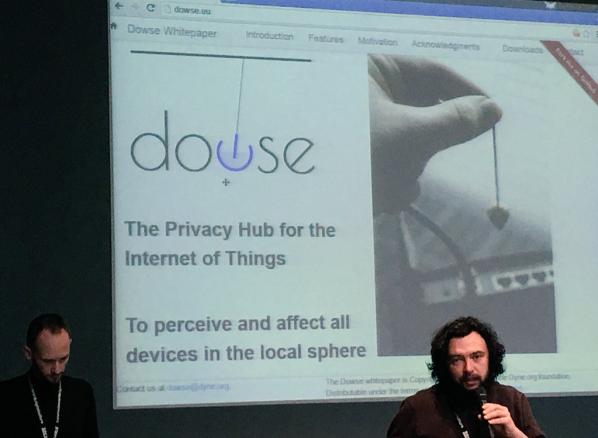
Dowse was conceived in 2014 as a proof of concept white paper by Denis Rojo aka Jaromil. Early contributors to the white paper and its drafting process includes: Hellekin O. Wolf, Anatole Shaw, Juergen Neumann, Patrick R McDonald, Federico Bonelli, Julian Oliver, Henk Buursen, Tom Demeyer, Mieke van Heesewijk, Floris Kleemans and Rob van Kranenburg. I downloaded the white paper and is definitely worth reading.
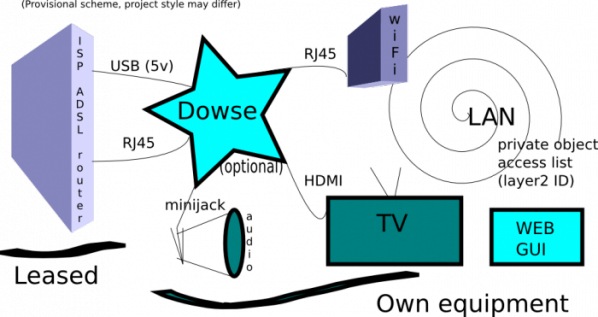
The Dowse project aims to abide to the principles stated in the Critical Engineers Manifesto, (2011). Near the very end of the talk they announced to the audience an open call for artists and techies everywhere to get involved and jump into the project to see what it can do. This is a good idea. If there is no community to make or break platforms, hardware and software, then there is a limited dialogue around the possibilties of what a facility realistically might achieve. Not just that, they want artists to make art out of it. I know there are some pretty clever tech-minded geeks out there, who will in no doubt take on the challenge. However, once those who are not so literate in the medium are able to exploit the project, it will surely fly. It’s going to be interesting, because if you look at the 3rd point in the Critical Engineers Manifesto, it says “The Critical Engineer deconstructs and incites suspicion of rich user experiences.” I’m thinking, that this number 3 element needs to treated with caution. If they really wish to open it up to a diverse user base, to engage with its potentialities, creatively and practically; thus, allow new forms of social emancipation to evolve as ‘freedom with others’. There needs to be an active intent to avoid a glass ceiling based on technical know-how. It’s a promising project and I intend to explore it myself and see what it can do and will invite other people within Furtherfield’s own online, networks to join in and play, break, and create.
Our final entry is the Sarantaporo Project which is situated in the North of Greece. A village in the mountains just west of Mount Olympus in Central Greece close to Thessaloniki, Macedonia and Larisa. The country has been in recession for over 6 years now, and many communities have had to create alternative ways of working with each other in order to survive the crisis. Over this troubling period, new forms of grass-roots coexistence, solidarity and innovation have evolved. The Sarantaporo Project is an impressive example of how people can come together and experiment in imaginative ways and exploit physical and digital networks.

Even before the economic crisis the region was already hit by poverty, and with the added pressures of imposed Austerity measures, life got even tougher. All the young were leaving and then migrating to the cities or abroad. Before the project in Sarantaporo, there was no Internet nor digitally connected networks for local people to use. This situation contributed to the digital divide and made it difficult to work in a contemporary society, when so many others in the world have been using technology to support their civic, academic and business for so many years already.
“In Greece, where unemployment reaches 30% in all ages and genders, and among the youth overpasses 50%, immediate solution for the “social issue” is more than urgent.’ [7] (Marmaras).
“Besides maintaining the network in a DIWO (Do It With Others) manner, and creating an atmosphere of cooperation among far-flung communities that were previously strangers, the Sarantaporo network is incorporating different groups of people into the community, like Farmer’s Cooperatives and techies. It is also creating an intergenerational space for learning.” [9] (Bezdommy 2016)

To resolve this issue a group of friends decided to deal with this problem by setting up a community D.I.Y wireless network to provide free internet access to 15 villages in the municipality of Elassona. “Sarantaporo.gr is an open source wireless mesh networking system that relies greatly on voluntary work both for its development and maintenance. Some volunteers are involved in the project by simply installing an antenna on their roof. Others, more actively engaged with the project, are responsible for sustaining the network by hosting meetings and answering technical questions.” [8] (Kalessi 2014) The audience was presented with snippets from a film made by the filmmaking collective Personal Cinema, about the project. It was made so the story of Sarantaporo’s DIY wireless network gets a wider reach, and that others are also inspired to do similar projects themselves.
These projects are dedicated to creating socially grounded and engaged alternatives to the proprietorial, networked frameworks that currently dominate our communication behaviours. These proprietorial systems, whether they are digital or physical are untrustworthy, and control us in ways that reflect their top-down demands but not our common needs. This reflects a wider conversation about who owns our social contexts, our conversations, our fields of practice, the structures we use, the land, the cables, our history, and so on.
Looking at the state of the planet right now you’d be forgiven for betting on a future not far from the director Neill Blomkamp’s vision in the sci-fi movie Elysium where, in the year 2159, humanity is sharply divided between two classes of people: the ultra-rich whom live aboard a luxurious space station called Elysium, and the rest who live a hardscrabble existence in Earth’s ruins. However, in the Off-the-Cloud-Zone talks we encountered an ecology of strategies to protect our own indegenous cultures from the crush of neo-liberalism, we felt part of a grounded movement discovering new conversations and new methodologies that may provide some protection against future colonisation. Perhaps there is a chance, we can build and rebuild stronger relations with each other, beyond: privilege, nation, status, gender, class, race, religion, and career.
The festival this year was less structured and more nuanced than usual. It gave conversation a greater role and a deeper social context, and opened up the process for the many to connect with the ideas being explored. The whole affair seemed to be slowed down and less caught up in the hyper-macho trappings of accelerationism. It seemed less neurotic and spending less effort to impress. I’m sure, next year, on it’s 30th anniversary, all will be sharp and amazing. However, I liked this less glossy, more messy version of Transmediale and I hope it manages to impress the wrong people again, and again.
What Hope Looks Like After Hope (On Constructive Alienation) is an exhibition conceived by Alexandrian curator Bassam El Baroni as part of Ashkal Alwan’s international cultural forum, Home Works 7. Run by the Lebanese Association for Plastic Arts, Ashkal Alwan is a non-profit organization based in Beirut, Lebanon. The exhibition opened on November 12th and ran until the 10th of December 2015. Drawing from philosophical concepts revolving around the drowning of the contemporary human consciousness and free will, the show is an elaborate discussion of how we are coping with the decline of a future that used to be in our hands. Bassam El Baroni in union with the artists involved raise questions as to how we can mediate and engage with solutions for creating (or disintegrating) prospects of a more ‘hopeful’ future.
The omnipresence of our reliance on technology echoes throughout the large space with the persistent humming of numerous projectors utilised in the exhibition. A correlation is directly created between the open space and the idea of alienation, as the reverberating sound becomes the only contributing factor that disrupts the isolation of each work. What used to be an old furniture factory building was the host for considerations regarding the repercussions of the current world’s most celebrated yet paradoxical phenomena. Perceptions of technology are relentlessly conflicting as there is an inherent drive advocating that we may either perceive the phenomena as good or bad. However, it must be understood that technology cannot be subtracted from human social, political or economic life; today, the two coexist. What Hope Looks Like After Hope (On Constructive Alienation) is divided into sections that are devoted to facilitating each artist’s work and touching upon these separate ideas.
Curated to represent a hotel room, Leonardo Cremonini’s digitally reproduced paintings are coupled with Yuri Pattison’s video 1014 listed in the exhibition guide as “shot in Edward Snowden’s hotel room hideout”. In the format of a hotel room, the piece also involved a bed and two nightstands with lamps, along with Pattinson’s 1014 being looped on a large TV monitor opposite the installed bed. Hotel rooms are standardised, fixed and homogenous in every single way. Cremonini’s paintings are reproductions both in terms of their digital print format and in the context of the general hotel room, where each room has replicated decors. Considering the idea of standardisation, Pattinson’s video appears to be the inception of a paradox as the space is curated to represent a hotel room, whilst a video about a hotel room plays in the background – but this is not any hotel room, it is Edward Snowden’s hotel room.
Snowden’s outing of the NSA’s and Five Eyes’ global surveillance programs to the popular media was readily perceived as a public civil act as it revealed a huge breach of privacy for citizens worldwide. Closely linked to ideas of ubiquitous surveillance versus freedom and civic liberty, Pattinson’s video utters phrases such as ‘I am only just me, I am a passer-by’, ‘Life is so arduous’ and ‘I am too tired to love’. The camera pans throughout the room to expose translucent glass spaces whilst untagged maps are being graphed when the camera pans to the city-landscape outside the window. Pattinson’s video is a survey of a hotel room, metaphorically standing for transitory spaces that can lead to a certain, self-perpetuated superficiality. We are consumers of desires, trapped within the hotel room metaphor.
Desire is an element in need of a risk assessment, and according to Nelmarie du Preez, such a risk assessment can be measured through a set of computerised algorithms. Two performances are displayed on two screens facing each other, du Preez’s to stab and to rely, from her ‘Loops of Relation’ series – both jesting with risk. Thoroughly reminiscent of Abramović’s and Ulay’s The Other: Rest Energy, du Preez positions herself in a certain degree of danger. to rely features du Preez facing a machine with an extended bow and arrow as she holds the tip of the arrow. to stab features du Preez sitting on a table with her hand stretched as a programmed machine repeatedly performs a five finger fillet (FFF); a popular knife-game embedded into American culture as a popular pastime as featured in the movie Aliens where Sigourney Weaver realises that the character Bishop meticulously performing the FFF is an android. Comparable to Aliens and Rest Energy’s notion of unveiling the full potentiality of the body’s endurance and trust over emotions and nerves, du Preez’s reliance on the machine is inherently vital.
She is performing a trust exercise with her programmed piece of technology and promoting a delicate balance between trust and danger. However, the problem in her actions innately exists when considering the core of the AI’s function; a machine does not possess the same sentiments as Ulay did towards Abramovic. A machine owes no responsibility or emotion towards du Preez, and in some sense, the roles have been flipped. Where du Preez is the possessor and programmer of this machine, she is now inflicting herself as the target. She relinquishes herself as the master, challenging the notion of possessing selfhood and allowing her own free will to be diminished. The metaphor of the bow and arrow pits du Preez and the machine as equals; the tension represents the idea that both entities are needed in order for the piece to have significance. Simultaneously, the interplay between du Preez and the machine uncovers a subtle warning of our insentient confidence towards the inescapable technology; du Preez can only stop herself from being in danger if she pulls the plug.
In very close proximity to du Preez’s work and upholding the same ideals of technology contributing to human activities is Salemy’s The Artist is Hyperpresent. The work is a three-headed screen structure overrun by the artist’s own personal social media feeds. Of course, the immediate reaction of any millennial would be to attempt a ‘scroll down’ function on the screens only to be disappointed that the machine did not respond to the command. The Artist is Hyperpresent is an undeviating allegory of the structure wanting a ‘digital life’.
On the other hand, Katia Barrett’s Limiting Metaphors, Enabling Constraint is an interesting take on the self through what appears to be an interrogation or courtroom procedure of a crime. Two large projector screens hang in the middle of the room whilst switching between them, introducing an individual of uncertain sex with blonde hair. The over-the shoulder shot is utilised evidently in preserving the mystery of the individual and the case itself. Someone asks ‘Why are you following me?’ whilst it sounds as though the conversation is happening from the other side of a glass window. Several retorts such as ‘I don’t think he was the victim here’ and ‘I’m the last person, you don’t know how I feel’ are followed by more questions such as ‘Who is watching you?’
The protagonist cannot address the questions because there is a certain degree of perplexity surrounding not only the timing of the event, but also the very core of what took place. The video becomes an act of displacement, as there is ambivalent confusion in the idea of the self being mingled with objects separate from the body. The character’s present environment, sitting in a dark empty room, is ambiguous and in this way begins to evoke Andy Clark’s idea of ‘active externalism’.
Clark is a neuro-philosopher whose concept of active externalism is described in the exhibition guide as ‘a description of subjectivity in which he renders the active role of the environment in driving cognitive processes’. For Clark, ways of perceiving ourselves and those around us are increasingly experiential and dependent on our environment – a notion that extends to Thomas Metzinger’s metaphor of the ‘ego-tunnel,’ which in Metzinger’s book, The Ego Tunnel: The Science of the Mind and the Myth of the Self, refers to the experience of our own consciousness. He states that ‘conscious experience is like a tunnel’ and that ‘the content of our conscious experience is not only an internal construct but also an extremely selective way of representing information’. If in any case Metzinger’s claims that our ‘sensory organs are limited’ and that we are ‘unable to experience and introspectively recognise our self-models as models’ are even remotely true, then Barrett’s work closely relates. It raises questions of how we experience society – is it a conscious exertion or is it partly constructed by our surroundings? It is more commonly believed that we are solely responsible for constituting the meaning of things, but what if we’re not? What if we are limited beings? What if this finitude is a ramification of our unaware reliance on several advancements that were at their pinnacle within our lifetime?
Walid Sadek also explores this thought in his piece The Conversion of St. Paul. The installation is placed in two separate but identical square rooms at very close proximity to each other. Each room is fitted with an overhead projector displaying the inside of a VHS tape. Between the two rooms is a narrow corridor opening up to a larger but empty peripheral area. By standing between these two rooms and focusing your vision straight ahead, an entirely new image forms in the void ahead. In the exhibition guide, Sadek explains that ‘what could allow for the making of an openness in which living is possible even without the promise of a coming eruptive event’. In this sense, the act of looking straight ahead onto the devised new image can be perceived as looking into or towards the future. By creating an allegory of the ‘image-encounter’ (or visual illusion), he allows our mind to utilise aspects from two environments and claims the result as a speculative future and existence.
Speculative existence is also examined in Matthew Poole’s collaboration with Bassam El Baroni titled Société Phantome – two separate projections on the wall presenting what could be the commandments of the ‘new’ world. The poem itself is suggestive of explosive and fiery liturgy sung in religious hymns. It retorts phrases such as ‘We cannot decline’ ‘Our walls are without fervour. Our doors are without zeal’, and resonates Guy Debord’s Society of the Spectacle both in execution and impression. Just as the Society of the Spectacle frames itself as the manifesto of the Situationist movement in the 1960s, perhaps Société Phantome can be in this light too.
Debord’s Society of the Spectacle focuses on the ‘negation of life’ due to the ‘loss of quality’ because of the instant commodification that occurred during the rise of mass media. In this context, we may associate an evolved spectacle that has arisen from our passive unification with technology. Debord’s claims such as ‘Everything that was directly lived has receded into a representation’, and ‘The images detached from every aspect of life merge into a common stream in which the unity of life can no longer be recovered’ are intrinsically concurrent with the alleged futility by which the human dwells in the face of an ever rising technological contemporary society.
Amanda Beech’s Covenant Transport, Move or Die, vocalises a different dimension to What Hope Looks Like After Hope (On Constructive Alienation) – the abstract socio-politics of post-capitalist culture. Beech’s room was curated distinctly with bright green walls, two benches, fitted carpet and two screens; one facing you as you walk in and one to the left of the room. The video is the loudest in the entire exhibition and perhaps the most extravagant of all as it interplays with the concept of the ‘green-room’ where images are being superficially created. The video spits words such as ‘EFFICIENT’, ‘EFFECTIVE’, ‘VOTE’, ‘REPORT’ and titling the excerpts from the front screen as: ‘Round 1’, ‘Round 2’). Covenant Transport, Move or Die comments on the ‘psyche of Capitalism’ as the video’s intentionally unpolished feel adds a new rawness and immediacy to the exhibition’s concept, touching upon the politics of Accelerationism. If Debord’s Society of the Spectacle was the founding awareness of socio-capitalist consequence, then ‘Accelerationism’ is the current age’s pinnacle of consciousness. It comes as no surprise that Debord’s views are being progressed into a condition far more intricate as we ‘accelerate’ through our daily lives.
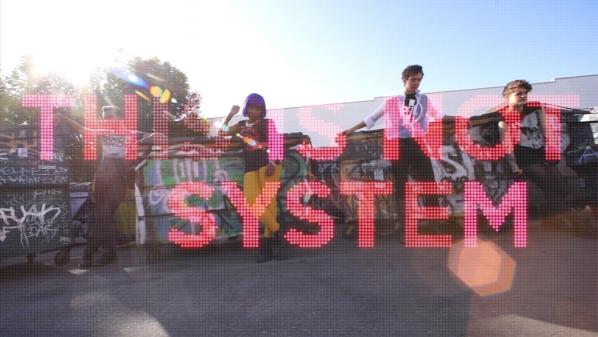
Accelerationism is defined in the book #accelerate, as ‘a political heresy: the insistence that the only radical political response to capitalism is not to protest, disrupt or critique, nor await its demise at the hands of its own contradictions, but to accelerate its uprooting, alienating, decoding, abstractive tendencies’. There are two potential paths to consider when taking into account our current world state (economically, socially, politically etc.). One path would be to embrace the fear of becoming a world of a politique du pire, expecting and expending the worst, and as a result relinquishing all hope. The second path would be to simply hope that capitalism would subside (or die, preferably) of its own internal contradictions. Nevertheless, neither of these choices undertaken, by left-wing or right-wing variants of Accelerationism, are perceived as helpful or realistic in combatting the situation. To the contrary, there must be a future-orientated realist philosophy as ‘extremist caricatures obstruct the consideration of a diverse set of ideas united in the claim of truly progressive political thought’. We are not at the end of the ‘world’ (as we know it) but at the very beginning of an interesting political experiment that is not as bleak as it appears. Such optimism was found during Patricia Reed’s lecture titled ‘Synthesis and Constructive Alienation’, as part of a lecture-series facilitated by Bassam El Baroni to complement the exhibition.
Reed’s lecture makes claims for our ‘social plasticity’ and ‘the need for constant redefinition in light of changing contexts’ revolving around ‘fanaticizing our downfall’. Her assertions opened up a considerably fiery debate at the end of her lecture as she questioned the notion of ‘inexistence’ as a non-being who plays no part in the reasoning of a system. Conclusively, her lecture ruptured the so-called Accelerationist dispute between idealism and realism whilst simultaneously uncovering the inconspicuous anomaly of attempting to guarantee the future when human nature is increasingly malleable.
Furthermore, Reed’s piece Volatile Prophecies was, I personally believe, the most captivating and meditative piece in the show. Placed in the furthest left corner of the exhibition space, Volatile Prophecies was displayed on a giant screen, showing an infinite amount of computer rendered and programmed floating coins moving through the screen in various directions and currents with a soundtrack intentionally (or unintentionally) following the flow of the coins.
The video-installation is described as pinpointing the economy ‘as a global architecture of human relations’. According to an excerpt from the exhibition guide, ‘financial engineers are our contemporary soothsayers and Volatile Prophesies is deploying some of their techniques’. Structures created by these ‘financial engineers’ have the possibility to allow or disallow limitless opportunities of relation, of function, and of structure therefore making them volatile. Floating exists when space becomes abstract, and where space is abstract, time could also be considered as abstract. As a result, the piece appears to be rejecting a harmony to a linear structure of economy and social relations.
Parallel aesthetics can be found in Hisham Awad’s commissioned video named Untitled whose mise-en-scène is prodigious. Awad combines the archetype of Delleuze’s ‘time-image’ and applies it to an allegorical narrative. Tackling techniques such a ‘slippage’ and methods of diegetic and non-diegetic sound, his use of particles applied over a post-produced image, invites the viewer to receive it as a form of film essay, stated to be ‘thinking with and against Deleuze’. Awad’s inclusion in What Hope Looks Like After Hope (On Constructive Alienation) is an interesting addition. Through connecting the ‘Deleuzian’ thought to modalities of motivation and logic, Awad may be reconstructing the impulse of freedom, undeniably connected to the tussling against unrealistic expectations of our current socio-political (non) human condition.
Drawing from these unrealistic expectations, Martti Kalliala’s Exostead installation unearths a vital disparity between ‘idealistic’ and ‘utopian’. Exostead is an installation of constructed aluminium steps with various de-potted plants scattered and broken throughout all levels. It seems to take the shape of an island, or a sovereign ‘seastead’. The concept of a ‘seasted’ hopes to form a utopian civilisation drifting in solitude and untouched at sea. However, Kalliala’s Exostead does not seem to be advocating for a utopian state, but rather for the possibility of one if time and human beings were free from their surroundings.
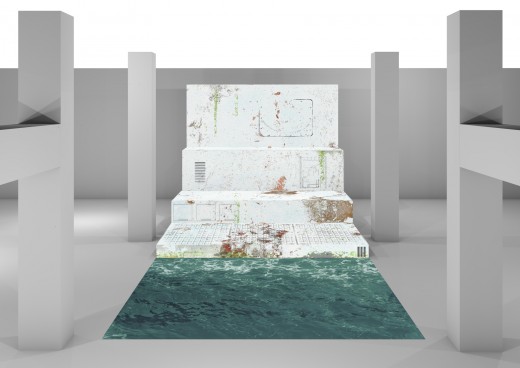
‘Exo’ is Greek for ‘outside’ or ‘out of’ implying that the ‘seastead’ is a way to ‘get out’, but towards and away from what? Instead, should we not be problematized by the seasted and its unmediated future in solitude and sovereignty? Would such a place not be promoting or accelerating the problems faced by contemporary society if it happened to be inhabited by the wrong type of people? Where does the hope of a seastead begin to be probable and where would it end?
What Hopes Looks Like After Hope (On Constructive Alienation) tends to the elusiveness of a concept such as ‘hope’ as a kind of sine qua non in a world where human desires, actions and thoughts are passively governed by cognitive capitalism. (Constructive Alienation) as stated in the title’s parenthesis, finds itself in the anticipatory readiness of desiring to predict the future, not because it is precarious, but because it needs mending to a certain degree. In an age where post-capitalist economic and social organising is at its most glorious foothold, Bassam El Baroni indexes the finitude of the human condition. Yet, we could be in the middle of capitalism, instead of in a state of post-capitalism, and if it is as such, our anxieties for the future will only intensify. As a result, the exhibition does not supply the answers to hope. What it does provide however are the potential outcomes of the imminent contingency enveloping itself in front of our eyes, only to raise more questions as you exit the space.
All photos are courtesy of Bilal Jawiche.
(Brian William Rogers and Yasmine Dubois Ziai were also featured on the opening night however I was absent for their performance.)
Featured Image: Black Shoals: Dark Matter’, Joshua Portway, Lise Autogena, Big Bang Data.
Big Bang Data is a major travelling exhibition currently set within London’s Somerset House. That a large institution is presenting a journey via data capture through ‘selfies, surveillance and infographics’ is in itself an interesting patchwork of intent and realisation. The aim of the exhibition is to ‘demystify data’. This is a grand, summative and in actuality slightly awkward claim which, in my view, encapsulates the character of an interesting, textured exhibition in an unintentionally astute way.
As Big Bang Data is dedicated to revealing data comprehensively through its various architectures and iterations, it makes sense for the underrepresented materiality of information to have prominence early on. This materiality, perhaps inevitably, was compromised in the gallery space. Entering the first room brings you face to face with Timo Arnall’s Internet Machine, which takes the form of multiscreen video documentation of not just the machines, but also the architecture, which supports mobile telephony.

I would have loved to have experienced the spaces shown more intimately and walked around one of these structures; the installation was illuminating but I was still most certainly watching at a remove. This initial interplay of removal and involvement is central to the way we experience data. How can people begin to understand something which exists as multiple codes and flows, on a scale and at a speed which is not concerned with making itself understood by humans? What form could an understanding of data possibly take? When learning about something this far from our grasp, it seems that ‘understanding’ must be replaced by ‘awareness’. Rather than seeking one answer via one route the visitor to Big Bang Data has to build an impression, obviously subjective and subject to change.
In its quest to expose and explain data’s social and cultural uses, it presents a fairly overwhelming amount of information. It is interesting to walk through the space thinking about how this information has been channeled by each specific project. Some representations, such as Owen Mundy’s ‘I Know Where Your Cat Lives’, link distant people and spaces via connected points, while others such as Phillip Adrian’s ‘One Second’ capture in great detail one specific point in time and space.
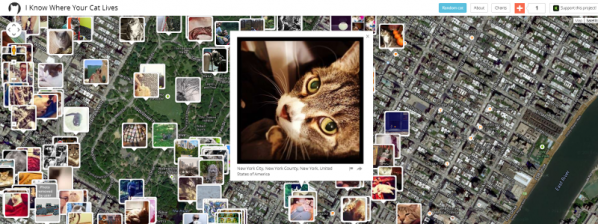
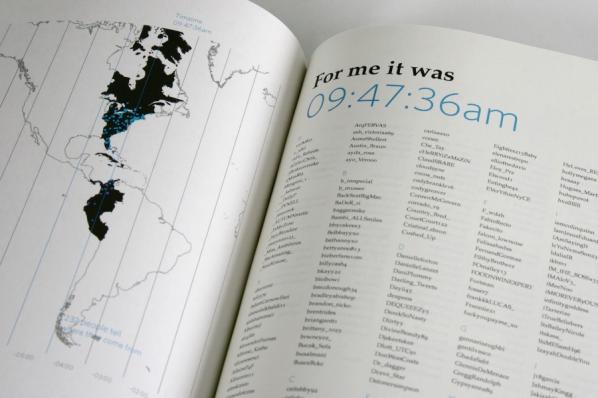
Julian Oliver’s ‘Transparency Grenade’ brings together graphical, console and physical representations of data to offer a transportable means of leaking information as a response to impenetrable governing systems. Each of the works on display demonstrates a negotiation between temporality, materiality and spatiality, and often one is sidelined in favour of the other. Again, considering the exhibition in this way is also to consider the world of data in all its contrariness.
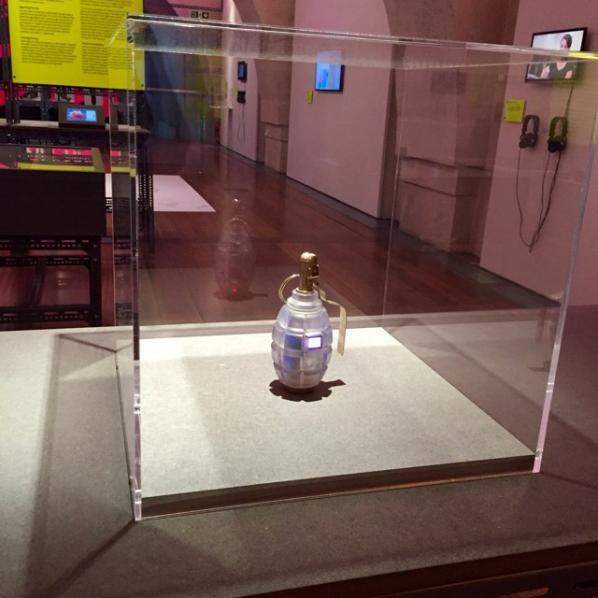
Data manifests itself at the same time locally and globally. As well as addressing specificity, the projects shown in Big Bang Data dwell repeatedly on scale. Works such as Tejka’s ‘London Data Streams’ and Nicholas Felton’s ‘Annual Reports’ pit scales against each other to cast light on the filters through which data is processed.

Ingo Günther’s ‘World Processor’ and Forensic Architecture’s ‘Liquid Traces: The Left-To-Die Boat Case’ are examples of resonant, atypical data visualisations which mutate familiar imagery and present alternative summaries of events. The section entitled ‘Data For The Common Good’ shows some of the ways data is being actively used in society to empower citizens with works such as Safecast’s ‘bGeigie Nano’ and IF’s ‘Data Licenses’, while a series of video interviews with journalists and other professionals working with data illuminate the processes through which information becomes communication.

The previously mentioned tension between object and their presentation recurs at various points throughout the exhibition, a great example being the array of undersea telephone cables, presented in cases of wood and glass which could have been magpied from a display of historical artifacts (each cable segment has a number next to it which corresponds to a factual description). It felt strange not being able to touch them. A work which I felt fully occupied, and knowingly played with, its surroundings was Ellie Harrison’s vending machine, which sits unassumingly in the gift shop; its secret is that when search terms connected to the recession make the headlines, free snacks are dispensed. Its presence in a exhibition on data in a gallery space felt appropriate.

Big Bang Data, which runs alongside a programme of events and has previously been exhibited at CCCB in Barcelona, comes at a moment where large organisations are more frequently bringing concepts such as surveillance, open source and free software into public spaces. There is a great need to bring the concepts and processes surrounding data more wholly into the public eye, and this exhibition strikes me as, overall, a big step in a good direction. It makes real and challenging efforts to bring together world-spanning processes, complex concepts and extremely diverse content into an exhibition space. The task of the exhibition’s curatorial and production teams must have been difficult.
Of course the challenges they faced have been dealt with before many times in many ways, and of course the practical decision-making involved in producing an exhibition invariably creates tension points. The reason I’ve dwelt on the problems of the organisers here is that the tensions evidenced within the space at Somerset House say much not just about the response of the publicly funded arts to data but also about the nature of data itself. The exhibition turns into at times a museum, a bedroom, a classroom, an information point, a scruffy new gallery space and a state of the art new media space. In bringing together the story of data the exhibition also brings together the story of representation in space more generally.
In writing about Big Bang Data I have had to choose to highlight certain works and not others. Your interpretation will be entirely different from mine, which is as it should be where data and cultural inclusion is concerned. What’s important is that the exhibition’s prominence and texture opens up conversation and critique. The exhibition is detailed, procedural and expansive. It is also alive with contrariness, generality and awkwardness. Perhaps one of the great things about the show is that these qualities are left to jostle for space. For me, reading this exhibition as a performative event was useful; others may leave Somerset House with an entirely different view having taken an entirely different route. This is inevitable where data is concerned – learning is incremental and procedural, but not traditionally linear.
Featured image: The facade of Kunstquartier Bethanien. Image by Nadine Nelken.
After a full year of events focusing on several topics, from drones to surveillance, cyberfeminism to hacktivism, or even the famous Technoviking and a hot debate on the politics of the Porntubes, the Disruption Network Lab wraps up 2015 with its event STUNTS, focusing on political stunts, interventions, pranks and viralities. It was a year of great success for the DNL and proof of that was a full house, in the middle of a cold Berlin winter, full of people eager to take part of this last gathering on art research, hacktivism and disruption.
Just at the entrance, in the castle-like facade of Kunstquartier Bethanien, the Free Chelsea Manning Initiative projected a video including phrases of support, denouncing the system that violently charges against all the whistleblowers who bravely stand against state-crime. Chelsea Manning, sentenced in August 2013 to 35-years of imprisonment, turned 28 years old on the 17th December. The initiative took the occasion to celebrate her anniversary but also to remind us of her cause and of how vulnerable whistleblowers are under the purview of “justice”.

Peter Sunde, one of the founders of Peter Bay, has recently given an interview stating “I have given up” when asked about the current state of free and open internet. The pessimistic tone that might loom among hacktivism has its reasons. With a growing and raging state surveillance, invigorated politics of fear veiled as anti-terrorism propaganda, or the alienating neoliberal order, the seemingly scarce possibilities to fight back can be easily overtaken by a sense of hopelessness. Yet, the proposal of STUNTS claims the possibility of new futures; suggesting that new artistic militancies and political subversions of neoliberal networked digital technologies, hoping to provide a glimpse of another world. What can be done? There’s still a lot to be done.

The opening keynote was reserved to John Law, original member of the Suicide Club and Cacophony Society, and one of the initiators of the Burning Man Festival, who gave an inspiring speech condensing 40 years of disruptive movements in the city of San Francisco. Law highlighted how important it was to live in San Francisco, a well-known refuge for many weirdos, hippies and punks, and how the city served as fertile ground for the foundation of many movements of disruption, such as the Suicide Club or the Cacophony Society.
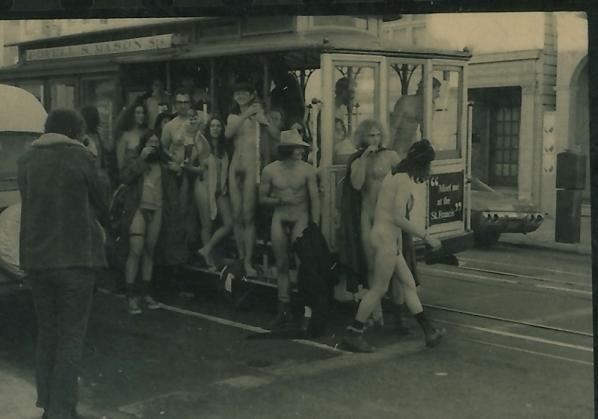
The Suicide Club, born from a course at the Free School Movement (also known as Communiversity) in the late 70s, was one of the pioneers with its events of urban exploration, street theatre and pranks. For several years, its members engendered actions of occupation and appropriation of public spaces, aiming to subvert the order of these spaces and highjack the authorities. Later on, some of its members founded the Cacophony Society which followed the same footsteps, creating social experiments and stunts, which according to Law didn’t necessarily mention being political but instead playful acts of liberation from the norm. Yet, in an age of overwhelming neoliberal labour exploitation, we can wonder if having fun among the working class isn’t already a political act. As Law said, “the events were illegal but not immoral” reminding everyone that in ethics and politics of disruption, right and wrong should never be defined by law. It seems that disruption is intrinsically political in the sense it questions the ruling order while also being an emancipatory act of dissidence.
PANEL: STUNTS & DUMPS – THE MAKING OF A VIRAL CAUSE

The panel, moderated by Ruth Catlow, one of the founders of Furtherfield, included a group of four hacktivists and disruptors, two of whom claimed to have once been Luther Blissett, an open-pseudonym used by several artists and activists as an hoax who has taken credit and responsibility over several stunts and pranks over the past 20 years. Following the thread of adopting an emancipatory praxis in the demand for privacy, M.C.McGrath presents the Transparency Toolkit. Motivated to refuse of data collection and the brute quantification that intelligence and corporations enforce as an interpretative lens for evaluating people’s lives, with this toolkit McGrath intends to facilitate the access to a database that allows journalists and civilians to surveil the surveyors. Providing easy access to personal data of the intelligence community, he gives intelligence a taste of its own poison. In response to the predictive justice portrayed by nowadays algorithmic supremacy, the Transparency Toolkit disturbs the power asymmetry while possibly enabling for even some form of critical mob justice.

Andrea Natella, creative director of guerrigliamarketing.it and KOOK Artgency, seeks for justice by creating elaborate hoaxes that corrupt corporate advertisement. Hoaxes such as the fake air company Ryanfair which claimed to “welcome aboard refugees” under the Geneva Convention, enabling refugees to fly without a visa. The ingenious mockery resulted in a flamed response from the ‘real’ company debunking the advertisement while at the same time it has received a great attention from the media, resulting in a broader public discussion on the refugee situation. Once again, Natella presents us with the power of disruption by taking advantage of tools used by the prevailing order.

The undergraduate in Computer Sciences Mustafa Al-Bassam has gained notoriety for being a part of LulzSec, a computer hacking group responsible a number of high profile attacks, resulting in being legally banned from the Internet for two years. From an early age Mustafa focused his time in the creation of tools to unmask the tenacious mechanisms of domination. From ironically proving the negative correlation between tests scores and the amount of assigned homework to denouncing violations of online privacy and security perpetrated by state agencies such as the FBI, Mustafa has been a main character in the defence of human rights in the post-digital era.
To close the panel, Jean Peters, co-founder of the Peng! collective, shifts the perspective of the debate. What if instead of blaming or attacking members of intelligence we could provide them the tools to liberate them from their own institutions? Recognising that within the intelligence community resides a great number of whistleblowers, Intelexit, which started as a hoax, is now an initiative that helps people leave the secret service and build a new life. Aimed specially at members of agencies such as CGHQ or NSA, Intelexit offers safe and encrypted channels of communication through which intelligence members can get access to legal and moral support. Without the intention of dismissing responsibility of these members, claiming some banality of evil, by emancipating intelligence members Intelexit conceives another possibility to disrupt the system from within.
CELEBRATING AT SPEKTRUM

With an incredible array of playfully disruptive tools and practices, the ending tone of the panel is of hope and optimism. Maybe this is the kind of optimism that inspired Chuck Palahniuk into writing the Fight Club, clearly influenced by the Cacophony Society of which he was a member. Optimistic disruption seems to pave way to new worlds of possibilities, into a new future envisioned with the help of DNL.
To close STUNTS in an even more optimistic way, the celebration of a year of DNL was at SPEKTRUM, another outstanding initiative in Berlin and another example of success. After less than a year of activity, SPEKTRUM, an open space that aims to link art and science, has already gathered a solid reputation in the field along with a trustee community of followers and participants. While we cross fingers for another year of funding for DNL, SPEKTRUM will continue to offer a rich program of concerts, performances, installations and debates.
Last Review – PORNTUBES: Reveals All @Disruption Network Lab, Berlin. By Pedro Marum, 2015
http://furtherfield.org/features/porntubes-reveals-all-disruption-network-lab-berlin
The Wrong Biennial, organized by David Quiles Guilló, is possibly the largest internet-based exhibition to date. With a flexible roster of 90 curators and 1100+ artists, this estimation of the exhibition may just be correct. However, as with any project of such a size, The Wrong may serve to be, as well as an overwhelming survey of contemporary media art, it could also be a mirror of individual critics and curators’ desires. But what it also represents for me is a grand bazaar of the current state of media art, and what I would like to discuss, along with a couple of the ‘pavilions’, which are the meta-effects of the exhibition.
But when I talk about The Wrong being a mirror for the hopes and desires of the curators and critics is that the reviews to date are as broad as the exhibition, and sometimes shaped to that critic’s interests or familiar territory. One critic recuses himself as more of a brick and mortar type, looks at a couple pavilions, and then addresses Lorna Mills’ post-internet satire of John Berger’s Ways of Seeing as a possible move to currently familiar territory.Conversely, the business magazine Fast Company, asks if The Wrong will finally allow digital art to sell. A virtual worlds blog hails the FrancoGrid SecondLife-like pavilion as yet another chance for “the art world to finally see the brilliant work happening inside virtual worlds”.

On Facebook, a thread with post-internet & glitch artists muse as to whether the non-institutional nature of The Wrong might constitute some dilution of the work in galleries. The views of The Wrong seem to be, in light of its sheer scope, more a reflection of what the critic finds familiar than tackling the overall project.

These are cursory cross-sections of the discussions happening online. From one review to the next, as important as the art and the artists, is the fact that Guilló has undeniably blown open a gigantic conversation about the nature of electronic art.The Wrong Biennial, regardless of its composition, structure, etc., has proven and a disruptive moment in this moment of hyperprofessionalized media art practice, and has created an online/offline archipelago larger than any festival, such as Ars Electronica, ISEA or Transmediale. And it’s free. But with the size and open nature of such an event in light of professional pressures from student loans to art fairs one asks, what good is being exceptional when you open the gates for undifferentiated curatorial practice? But conversely, art critic Jerry Saltz mentioned that the work he saw after the last art crash in the late 2000’s was more and better after the flattening effect of the crash. Could the rhizomatic effect of the bazaaring of net art created by the sheer scope of The Wrong have created one of the greatest analogies for the current explosion of media art today by giving a lot of it to the online public and creating an agora for discussion as well?
While the effects of The Wrong I am explaining may seem like the title of the Performa ’09 biennial in saying, “Everywhere, All at Once”, Guilló took a flexible, but very rigorous approach to constructing the exhibition. In the beginning, Guillósought funding for the project on Indiegogo, and set up bienniale and curator group pages on Facebook, as well as an extensive exhibition catalogue website. These set a framework for the numerous on/offline “pavilions”, all linked through the biennial online sites. And, periodically, there are docented online “tours” of the Biennial every week or so that attempt to make sense of the content onslaught that The Wrong presents. In a way, this biennial uses the aesthetics of the Long Tail to situate itself somewhere between “snack culture” (Wired, 2007) and recursive self-curation/the “curated life” in its structure to mirror the current cultural sociological terrain. In other words, what is as impressive regarding The Wrong is its structure as much as its content.
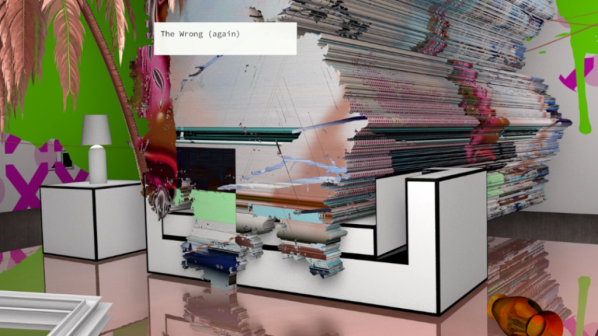
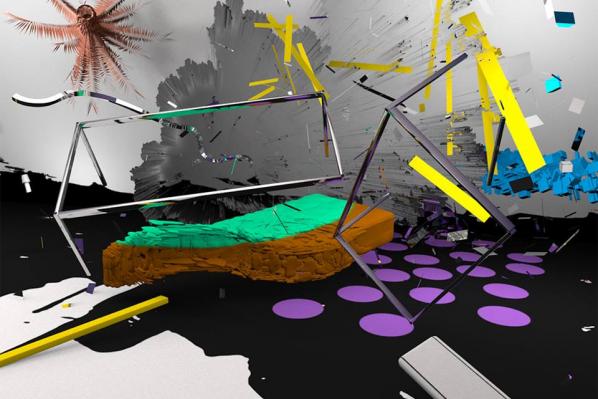
In allowing myself to peer into the abyssal mirror of content implicit in The Wrong and see my own reflection in it, I see a project I did in 1998. I curated a show called Through the Looking Glass for the Beachwood Center for the Arts in Cleveland, a 3000+ sq. foot space. More or less, there were a number of kindly locals who were curious about digital art. For this show, I got 80+ physical artists and 40 or more online artists to show the breadth of the current scene from every continent (there was even an Antarctican photo installation…) Artists included Michael Rees, Scott Draves, Helene Black, RTMark, and many more. The show included a physical space as well as the show website (http://voyd.com/ttlg/) which also included a number of other artists. The exhibition was promoted/discussed on sites like The Thing and Rhizome, and was documented in Christiane Paul’s New Media in the White Cube and Beyond, (UC Press, 2008), somewhat mirroring Guilló’s discursive hydra. The importance was that it got a regional and international dialogue going about the state of media art at the time, much like The Wrong, but only at a fraction of the latter’s scale.

Guilló’s project transcended the museum, as in conversation online he was enroute to one of the museums he has spoken on the subject, including sites Europe, North America (SAIC) and others. In this regard, the reach of the project, while theoretically only possible as something like Ars Electronica’s Net.Condition or the Walker’s Art Entertainment Network in the late 90’s, has engaged the many social media layers from Facebook, Twitter, as well as net.distribution and reached a much wider audience. In this way, I feel Guilló has sidestepped the institution to make an exhibition that reflects the cultural terrain and social practices of its milieu – the Internet. In some ways, I feel that The Wrong could be the first true net.biennial.
With nearly a hundred “pavilions” to view, writing on any one cannot address the scope and structure of The Wrong. Perhaps I am less enthralled with ones that deal with individual artists, moreso with thematic pavilions, and more with the open call ones, as they create a generative basis for expansion of the biennial itself, creating more diversity within it.

One of the open calls that I liked well enough to volunteer for was Brazilian Gabriel Menotti’s Approximately 800 cm³ of PLA, which was an open, print-til-we-run-out, Fluxus-reminiscent, “give us a file and we’ll print it exhibition”. The resultant models were put on display at Baile, in Vitoria, Brazil, and included pieces from veteran Chicago 3D print artists Tom Burtonwood and Taylor Hokanson. Another pavilion of interest (again using the mirror metaphor, as I have been known to do work in virtual worlds) is that of the Wronggrid Pavilion in FrancoGrid, a Francophonic OpenSim (read: open source Second Life) that hosted a 6-month residency with sixteen artists. The WrongGrid Pavilion has generated a great deal of content, especially from Jeannot GrandLapin (Frère Reinert?) as the big avatar rabbit GrandLapin, and another Chicagoan, Paul Hertz. The WrongGrid virtual vernissage was one of the more memorable events in The Wrong as it gave one of the few opportunities for people to meet in the virtual across continents and share in the work in real time. But these are only two of nearly 90 sites that constitute this massive undertaking.
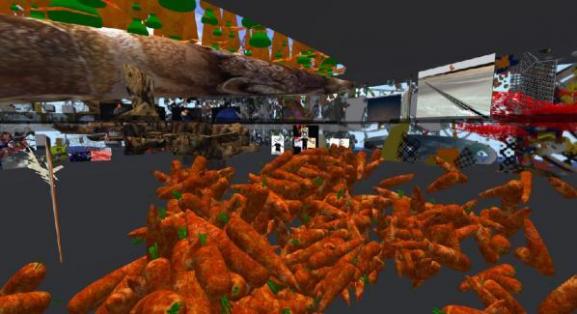
David Quiles Guilló has created a juggernaut – significant enough to get the #3 nod from Hyperallergic for top shows in 2015. From its size and scope, it represents a breadth of artists and themes that shows a fantastic cross-section of the current electronic media art ecosystem. In addition, The Wrong engages avant practices of open curation, nested participation, and relational organization while challenging the necessity of institutions and art fairs. While The Wrong may be as hard as Benjamin’s Arcades Project to get through, most sites give rich experiences, and some give empty links. What is important about The Wrong Bienniale is that it appears to be one of the few projects that is a true net.biennial in terms that it is about the net, how its links with the physical, and how it refers to projects like the Fluxus-inspired Eternal Network that explore how we create through social and technological networks. The Wrong Bienniale is a disruptive site of cultural engagement in a social milieu complaining of malaise and cynicism. It’s time to consider what media art is; how our communities interact; how we operate as a community; and what it means to be a media artist in a mediated culture.
Featured image: Nishant Shah, Roy Klabin, Francesco Warbear Macarone Palmieri, PG Macioti and Liad Kantorowicz
Finally I had the pleasure to attend to a session of the Disruption Network Lab. Physically, let’s say. Even though this was the first time I’ve managed to be in Berlin for one of its events, I’ve been a compulsory virtual follower, watching the videos of their fully recorded sessions. This is a hint for anyone who would like to watch all the previous keynotes and talks.
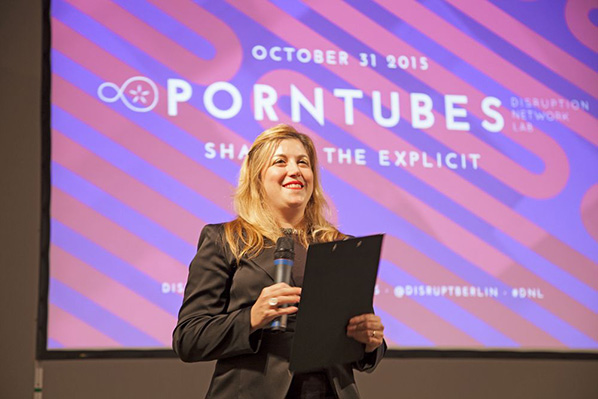
With its first edition in April, Disruption Network Lab is an ongoing platform of events and research on art, hacktivism and disruption, held at Studio 1 of Kunstquartier Bethanien, in partnership with Kunstraum Kreuzberg/Bethanien, in Berlin. On 31st of October it has held its 5th session, PORNTUBES: Sharing the Explicit. Aiming to discuss the role of porntubes in the sex and porn industry it gathered porn practitioners, entrepreneurs, sex work activists and researchers, to engage in a debate on the intertwining of porn with the Internet.
Pornography has always been a pioneer in using new technologies for its distribution and promotion. Internet, by allowing anonymous access to porn from the comfort of everyone’s home it seemed to be the ultimate tool for the porn industry’s expansion, to say the least. As pointed by Roy Klabin during the talk, 38,5% of the time we spend on the Internet is spent watching porn. As in many other spheres, it also seemed to be the beginning of a new era of labour liberation with an apparent decentralisation from the big porn production houses. This has allowed the blossoming of new small and independent companies with their own place in the market. But if cyberspace once seemed to offer a possibility to escape the tentacular control and exploitation exercised by the corporative monopolies, it is now known that the rebellion of the cybernetic innovators – creators of porntubes and new online sex tools – seems to be purely a coup d’etat.

The opening keynote was by Carmen Rivera, a Mistress and Fetish-SM-performer, with a long history in the porn industry business, with an experience of the migration of porn from cinema to VHS and later to the Internet and then onto the porntubes. In conversation with Gaia Novati, a net activist and indie porn researcher, Carmen tells us her personal and professional story and immediately gives a better understanding on how porntubes – such as Redtube, X-Hamster or Youporn – have an ambiguous influence in the porn industry. Once perceived as a democratic tool allowing small porn producers to expand their radius of audience-reach, Rivera explains how much of a perverse tool of exploitation it has become and one that small producers have become too dependent on.
The fast pace of the Internet creates a lot of pressure to satisfy the hunger of porn consumers. As has become virtually infinite “fast-porn” is closely aligned with the capitalist paradigm of production, putting a bigger focus on quantity rather than quality. As the Internet leaves no space for durability — one day you’re in, the next day you’re out — careers become frail, the work of these companies are highly precarious and the concept of the “porn-star” is a short lived mirage.
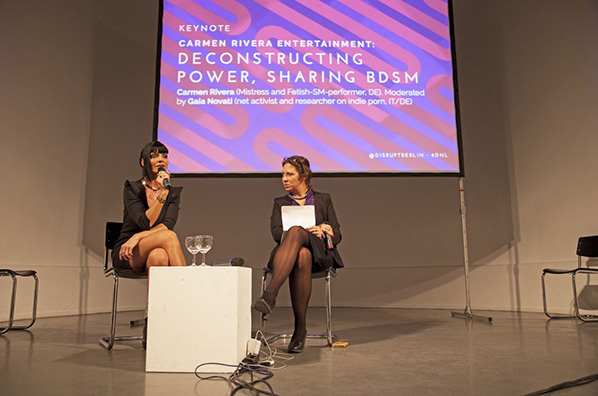
Rivera also highlights how online piracy has become virtually unavoidable resulting in gigantic losses to the porn industry. As producers see their films ending up on porntubes free of access, lawsuits don’t come as a viable solution but as financial black holes for any small or even medium companies. Even though the future doesn’t seem bright, Rivera doesn’t quit. Her battle cry: we need to create a bigger awareness of the pestilent system that controls the online porn industry. New tools of disruption need to be found to fight against these new power asymmetries established through the domination of cybernetic capital.
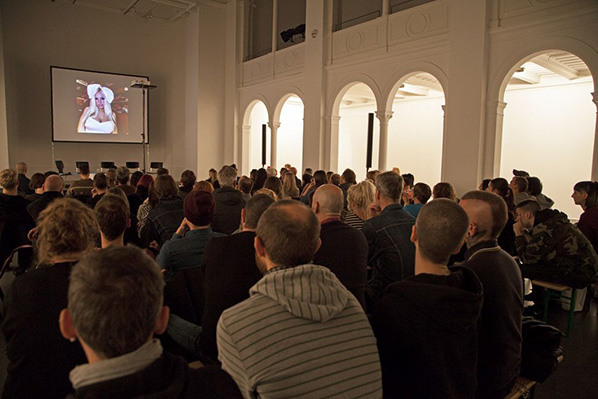
After the keynote, the discussion shifted to examining new tools of online sex work such as the project PiggyBankGirls, self-proclaimed as the first erotic crowdfunding for girls. Unfortunately, Sascha Schoonen, CEO of the project, wasn’t able to attend. Instead a short promo video was presented introducing the project, giving some tongue-in-cheek examples on how girls could profit from this crowdsourcing tool.
Women upload videos pitching their ideas or projects – financing a shelter for stray animals, the payment of tuition fees, a trip to Japan, – and then share online porn performances in exchange for support from “occasional sugar daddies”. Although one wonders if this isn’t just a euphemism – a sanitised version, let’s say – of already existing tools used by women who need money, regardless of them making public how they intend to spend money Nevertheless, it is true that the actual exploitative system needs to be dismantled, workers should be getting a bigger share for their labour and PiggyBankGirls poses as one more tool to do so, however this project also left many unanswered questions. Who are actually the women who can profit out of it? PiggyBankGirls promo tries to make this form of sex labour sound “cute”, easy and accessible. However, is just another tool for established porn actresses to diversify their means of income?
The panel, moderated by Francesco Warbear Macarone Palmieri, socio-antrophologist and geographer of sexualities, included abstracts showing a wide array of perspectives on the issue of porntubes and online sex work. The researcher Nishant Shah opened the panel with a wonderful talk ranging from porn consumerism to porn politics and how porn is influencing our digital identities. In a porn-consuming society, from establishing clear distinctions between “love” and “porn”, respectively meaningful and perverse, desirable and visceral desire, porn seems to be contingent on the morals of the spectator – as it only exists through the spectator it has also become a tool of puritan regulation. From Facebook teams of censorship and sanitisation of the virtual space to websites such as isitporn.com it is possible to understand that the concept of porn becomes itself a regulator of our sexual expressions, defining the line that separates decency from indecency. Paving the way to the pathologization of porn practices but yet dictating the meaning of authentic sexual performances, as the only visceral forms of sexual performances available, Shah pointed out how pornography, as a cultural and digital artefact, works in the regulation of our societies and in the production of our identities. Giving the example of Amanda Todd, who committed suicide after suffering from bullying for exposing her sexual body online, Shah shows how new forms of “porn” take place in the digital, from doxxing to unintended porn being perceived as such, enabling new forms of violence – let’s say porn-shaming.
Also focusing on porn consumerism, Roy Klabin, investigative documentarist/filmmaker, goes back to the discussion initiated with Carmen Rivera on porntubes VS porn producers and how producers make money. According to Roy, MindGeek, the company that owns most of the porntubes – from Youporn to Redtube – has been one of the main entities responsible of the destruction of the porn industry. By creating piracy websites holding gigantic libraries of free access to porn and making revenue out of the advertisement, resulting in huge losses for the porn companies which at the same time had become dependent on the tubes to advertise their work. Roy makes an appeal to porn producers to diversify their strategies: from webcams to virtual reality, the porn industry needs to be one step ahead of the contemporary systems of digital exploitation.
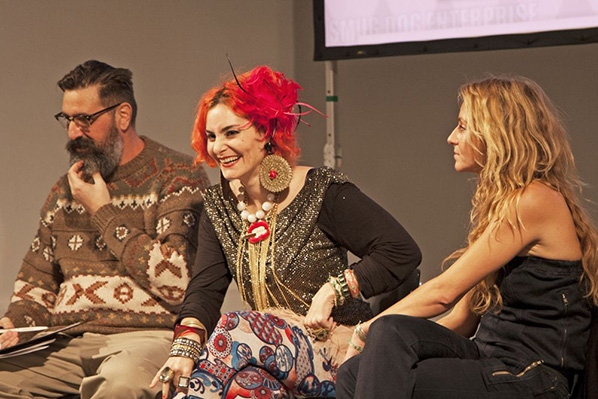
PG Macioti, a researcher and sex workers rights advocate and activist, together with Liad Kantorowicz, performer and sex workers’ activist, presented an overview on how the Internet has reshaped sex work – from sustainability to work conditions – listing some of the outcomes, pros and cons, of the extension of sex work to the virtual spaces. Online sex work, namely erotic webcam work, has enabled a proliferation of sex work by offering safe, independent and anonymous services. On the other hand with the insertion of sex work on the capitalist mode of production, just like in many other forms of digital labour it has rendered a bigger alienation to the workers – who work mainly alone and, also due to stigma, don’t share any contact with fellow colleagues – resulting in a more and more precarious labour, with sex workers being paid by minute, having to pay for their own means of production and usually paying a big share of their income to the middleman webcam services host agency.
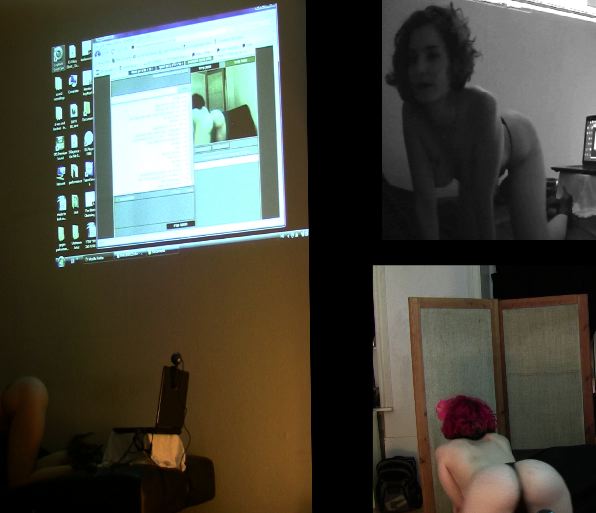
Overall, the Internet has enabled a multiplication of narratives on sex work but the power asymmetries between the online corporations and workers results in a growing exploitation and precariousness. The transversal message to all participants seems to urge for disruptive tools for online sex work, tools of self-empowerment and emancipation within the digital paradigm. Quoting the Xenofeminism manifesto by Laboria Cubonics, “the real emancipatory potential of technology remains unrealised” and the Disruption Network Lab might be the much needed spark for this revolution.
The PORNTUBES event couldn’t have had a better ending with a party held in the legendary KitKatClubnacht, a sex & techno club that is open since 1994, famous for both its music selection and its sexually uninhibited parties. It seems an exciting idea, to say the least, to bring all together researchers, porn entrepreneurs and activists to this incredible venue after an intense afternoon discussing the porntubes.
Concluding the series of conference events of Disruption Network Labs during 2015, the next event will be STUNTS: Distributed, Playful and Disrupted, taking place on the 12th of December, at the Studio 1 of Kunstquartier Bethanien, and the direct link is: http://www.disruptionlab.org/stunts/. This time the discussion will focus on political stunts as an imaginative and artistic practice, combining hacking and disruption in order to generate criticism of the status quo. As the immense dragnet of state-surveillance extends it becomes imperative to understand which are the available tools of obfuscation, how it is (still) possible to hack the system and which tools of political resistance can be deployed Disruption Network Lab wraps the year with a tempting offer, inviting artists, hackers, mythmakers, hoaxers, critical thinkers and disrupters to present practices of mixing the codes, creating disturbance, subliminal interventions, giving raise to paradoxes, fakes and pranks.